- Skip to primary navigation
- Skip to main content
- Skip to primary sidebar


Connect with us

- Privacy Policy
- Journey by Country
- My Cookbook
- Exploring the world through food
Maltese Bragioli (Beef Olives) Recipe
September 29, 2016 By Darlene at International Cuisine
- Pinterest 1152
- Facebook 336
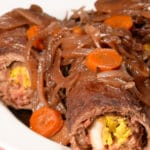
Maltese Bragioli also known as beef olives, are slowly braised stuffed bundles of beef. Beef rolls would be a more accurate description. The term olive is a bit confusing as there are no olives in this recipe.
It turns out they got their name because they are stuffed and somewhat resemble the shape of an olive when cooked. Whatever you call them, they are delicious bundles of joy!
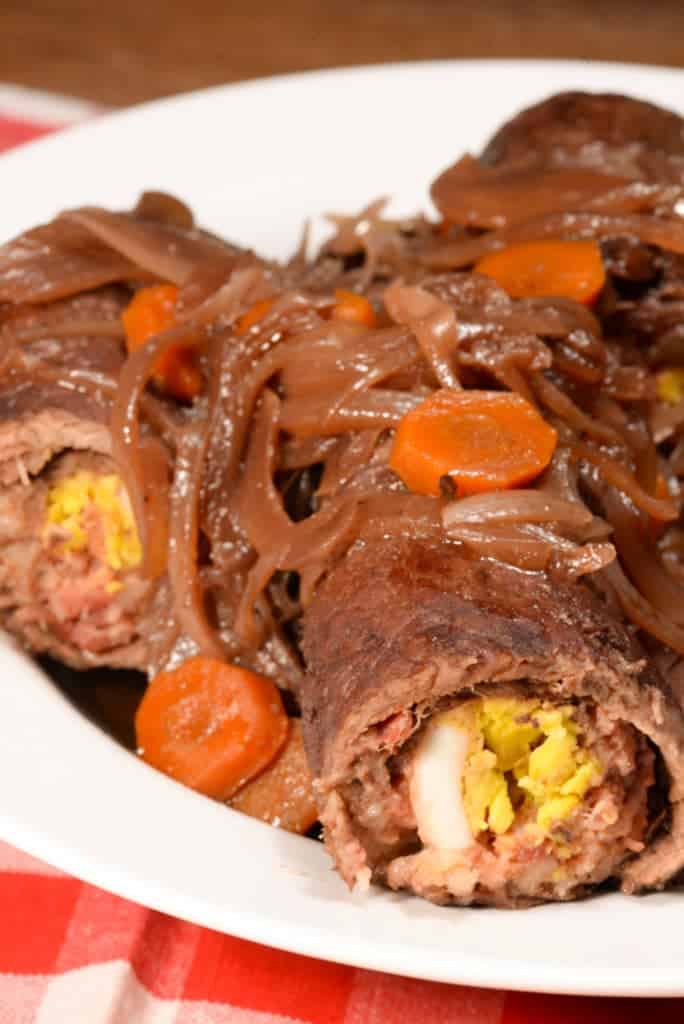
This dish can be made with not the best cut of meat because it is braised in wine for a long time. I found some thin sliced top sirloin at my local market and it worked out great. You could use a thin slice of flank steak but really any slice of beef will do. You will make the meat slice thinner with a mallet.
The beef slice is rolled up with a mixture of bread crumbs, chopped bacon and parsley then topped with hard-boiled eggs. Once rolled they can be secured with butcher's twine or wooden toothpicks to keep them together while browning then braising.
The beef rolls are then browned over medium heat in olive oil or lard, in a large saucepan. The browned bragioli is placed on bay leaf in a large stock pot. The carrots and onions along with some garlic cloves are cooked in the same pan as the beef, then the pan is deglazed with the wine and poured over the beef rolls. This is your braising liquid. Sometimes pine nuts are added as a garnish. Be sure to remove the kitchen string or tooth picks before serving.
This dish is often served with mashed potatoes and peas however I made it with a pasta omelette as part of our Maltese meal, which was wonderful. How ever you serve them, you will savor this traditional Maltese beef dish.
This dish can easily be made Plant Paradox compliant by using grass fed beef, compliant bacon and compliant bread crumbs. You can serve it alongside mashed sweet potatoes or cauliflower for a delicious meal.
Did you know that the name of the island nation of Malta is derived from a Greek word meaning "honey"? The island has an endemic species of bee, which produces a unique type of honey for which the island is famous. Although when I visited there some people said it was because of the color of the stone of the buildings, they are definitely a honey color.
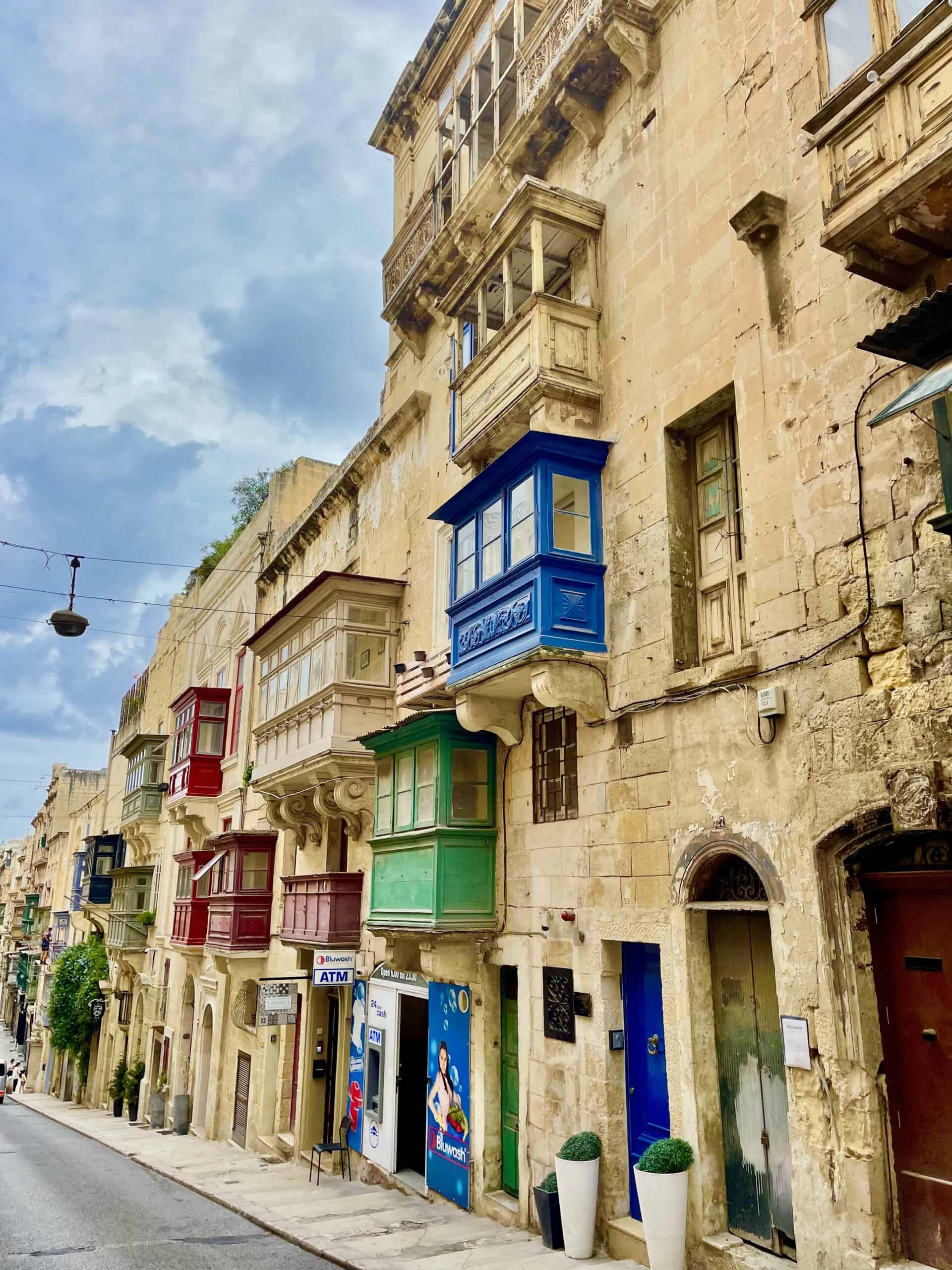
Have you ever been to Malta? I would love to hear what your favorite dish was when you visited there. If you make this Maltese bragioli, I would love to know if you loved it as much as we did.
If you would like to learn more about Maltese cuisine, be sure to check out " Our Journey to Malta " Also, get more authentic Maltese recipes like pastizzi, a wonderful street food pastry, or olives stuffed with tuna called Zebbug mimli . a cheesy pasta omelette called froga-tat-tarja plus some Maltese gelat (Ice cream).
Craving even more? Be sure to join the culinary and cultural journey around the world so you don’t miss a thing, it’s free, You can also follow me on Instagram , Facebook , Pinterest and youtube to follow along our journey.
Please note that this page contains affiliate links in which I will earn a small commission however, it will in no way affect the price you pay. I thank you for your support!

Maltese Bragioli (Beef Olives)
Ingredients.
- 1 lb. top sirloin thinly sliced in long pieces
- 1 onion sliced thinly
- 1 carrot cut into bite size pieces
- 3 slices white stale bread without crust crushed
- 2 hard-boiled eggs sliced
- 4 slices bacon chopped
- 1 handful parsley chopped
- 1 Tbsp olive oil or lard
- 2 cloves garlic minced
- 2 bay leaves
- salt and pepper to taste
- 1 cup red wine +/- for braising
Instructions
- Beat the slices of meat with a mallet so they are nice and thin.
- In a bowl, add your bread crumbs, chopped bacon, parsley, and a little salt and pepper. This is your stuffing. Place a heaping tablespoon of the stuffing onto a slice of the beef and spread it out along with a couple slices of hard boiled egg.
- Roll the meat slices lengthwise over the stuffing and tie it up with cooking string or else secure with toothpicks. Do this with all of the beef, trying to evenly distribute the stuffing.
- Pour some oil or lard in a a large pan and fry the beef olives on all sides until nicely browned. Transfer the beef olives into a large stock pot and place them on the bottom of the pan along with the bay leaves.
- Using the same pan that the beef was cooked in, fry the onions, garlic and carrots until the onions are translucent.
- Pour the wine over the onions and carrots and deglaze the pan.
- Pour the sauce over the beef olives and put on simmer, you want it to gently simmer for about 1 1/2 hours until the beef is beautifully tender. NOTE you may need to add a little wine or water if it boils away but not to much you want it to braise not stew.
- When finished remove the toothpicks and strings and serve along with the sauce.
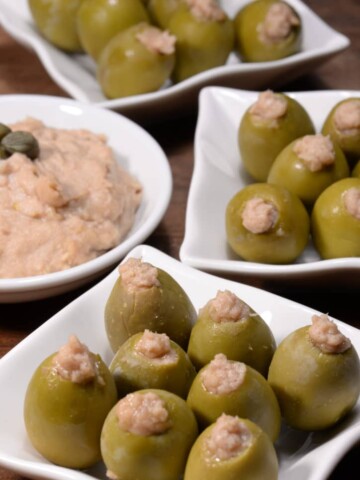
This Week's Recipes
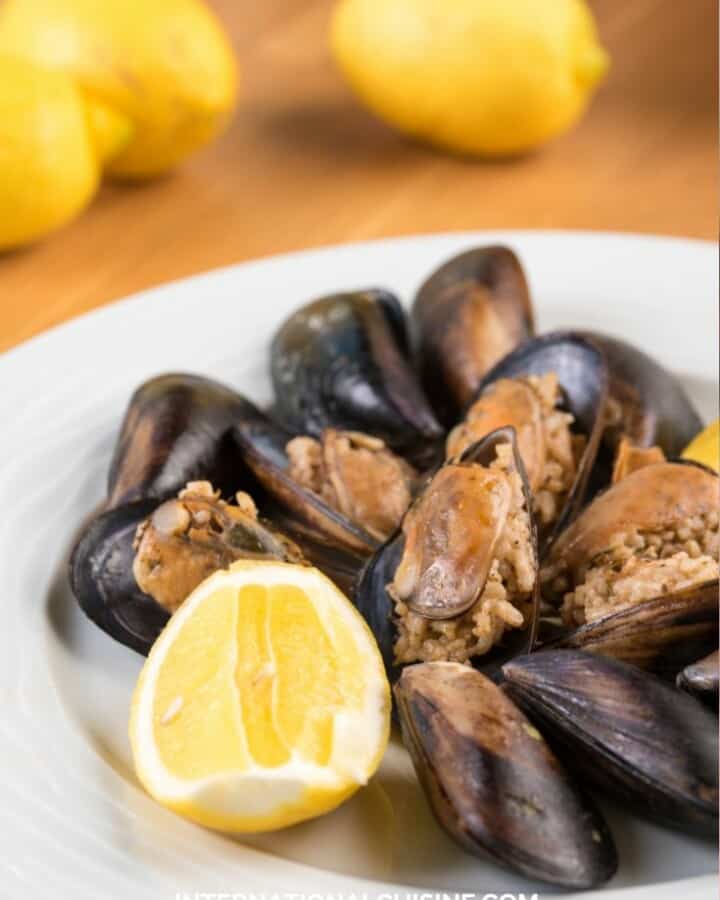
Turkish Stuffed Mussels Recipe (Midye Dolma)
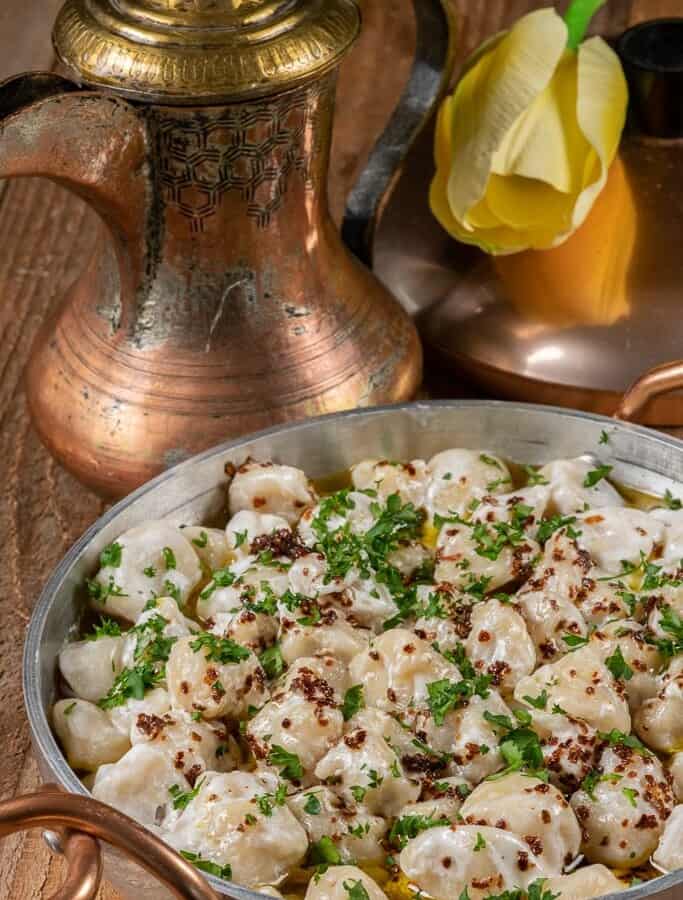
Turkish Manti Recipe (Homemade Lamb Dumplings)
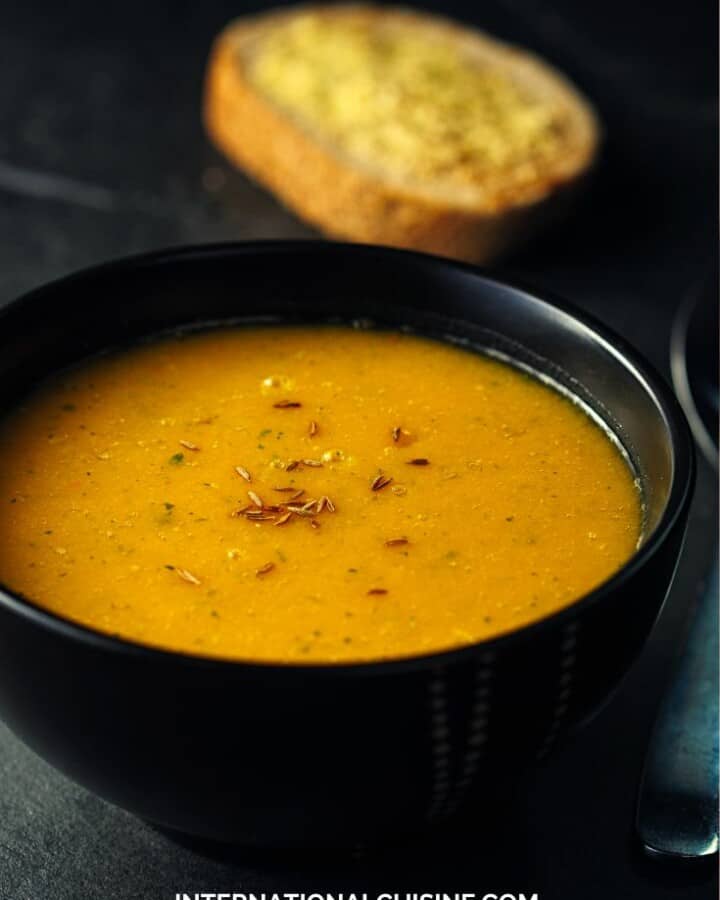
Turkish Red Lentil Soup Recipe (Mercimek Corbasi)
Rate this recipe.
- Taxi Booking
- Excursion and tours
- Chinese Restaurants
- Restaurants in Gozo
- Restaurants in Sliema
- Restaurants in St. Julian's
- Restaurants in Valletta
- Restaurants in Marsaskala
- Restaurants in Mdina
- Restaurants in Paceville
- Restaurants in Xemxija
- Restaurants in Mgarr
- Restaurants in Vittoriosa (Birgu)
- Top 10 restaurants in Malta and Gozo
- Chef Interview-The Kitchen Restaurant
- Chef Interview - Emperor of India
- Chef interview with Reuben Grixti from Scirocco Restaurant
- Marsaxlokk Fish Market
- Farmers Market
- Bigilla Recipe
- Aljotta Recipe
- Kwarezimal Recipe
- Bragioli Recipe
- Timpana Recipe
- Stuffat tal-qarnit Recipe
- Pastizzi Recipe
- Lampuki Moqlija Recipe
- Qaqoċċ mimli Recipe
- Figolli Recipe
- Ħobż biż-Żejt Recipe
- Stuffat tal-fenek Recipe ( traditional Maltese rabbit stew)
- Imqarrun il-forn
Top rated restaurants by members
Best restaurants according to malta.com, bragioli recipe, make your own maltese traditional beef rolls.
Maltese traditional cuisine can be very tasty without using the very best cuts of meat. This tasty speciality is part of the Maltese peasant and rustic recipes , that can also be served as two meals, using the sauce with pasta as a first course.
Ingredients to make your own Bragioli:
6 thin slices of topside or round steak, flattened with a mallet 400g veal mince 2 rashers bacon, diced 2 cloves garlic, crushed ½ cup parsley, finely chopped 1 tbsp oregano, finely chopped 1 shallot, thinly sliced ½ cup gbejniet (Maltese cheese), grated 2 eggs, beaten Sauce 3 tbsp olive oil 2 large onions, diced 5 cloves garlic, crushed 1 tin tomatoes 1 cup flat leaf parsley, leaves picked ½ cup basil, leaves picked 250ml red wine 500ml water Salt and pepper to taste 2 bay leaves
Don't worry, it's easy to prepare Bragioli:
Start with the sauce : chop and fry onion and garlic in olive oil until softened and golden. Add tomatoes, herbs, red wine and water and leave to simmer while you prepare the bragioli.
First, lay out the beef slices. Meanwhile, mix the remaining ingredients together and season with salt and pepper. Place then a heaped tablespoon of stuffing mixture on each beef slice, spreading out well. Roll it up and secure it with a toothpicks or tie with butcher’s twine. Place the bragioli in the sauce and simmer for 1 ½ hours over low heat.
View our list more tasty Maltese specialities such as Bigilla and Timpana !
| About us | Contact us | Advertise on Malta.com | Terms and Conditions |
Copyright © 2011 - 2019 All rights reserved in all formats known and unknown.
Malta.com is held by an independent commercial company, not related to any civic or official institution. Malta.com was created to promote the Island of Malta. We provide information about Malta, Gozo and Comino - Malta guide, Attraction, Event, Museum, Beaches, Hotels, Apartments and Farmhouses.
Malta.com is powered by a private technical solution - Contact us for more information.
You must activate Javascript support in your browser settings.
Search This Blog
Nanna's cookbook.
Family Recipes, Maltese, Mediterranean
- Main Dishes
Maltese Bragioli, "Beef Olives"

..I'm dying here...! They look so good!, just like my mother and Nana used to make. We need more!
Thanks John! It's so intimidating to recreate those cherished family recipes, but it's well worth the effort when you finally succeed. I hope you give it a shot, and please let me know how it turns out if you do!
Try using eye of round roast sliced into thin rounds and pound them into even thinner rounds.This is what Nana Esther always uses. One of my favorite Maltese dishes. YUM...
Thanks for the tip! I will try that next time!
I made this last night for the first time and it was amazing! My own nana passed away when my mom was just a girl soI have none of her recipes. THANK YOU!
Aww, you're so welcome Tammy!! I'm really happy the recipe was a success for you! You might want to check out some of our other Maltese recipes. They might be able to help supplement other lost family favorites.
Post a Comment
Popular posts.
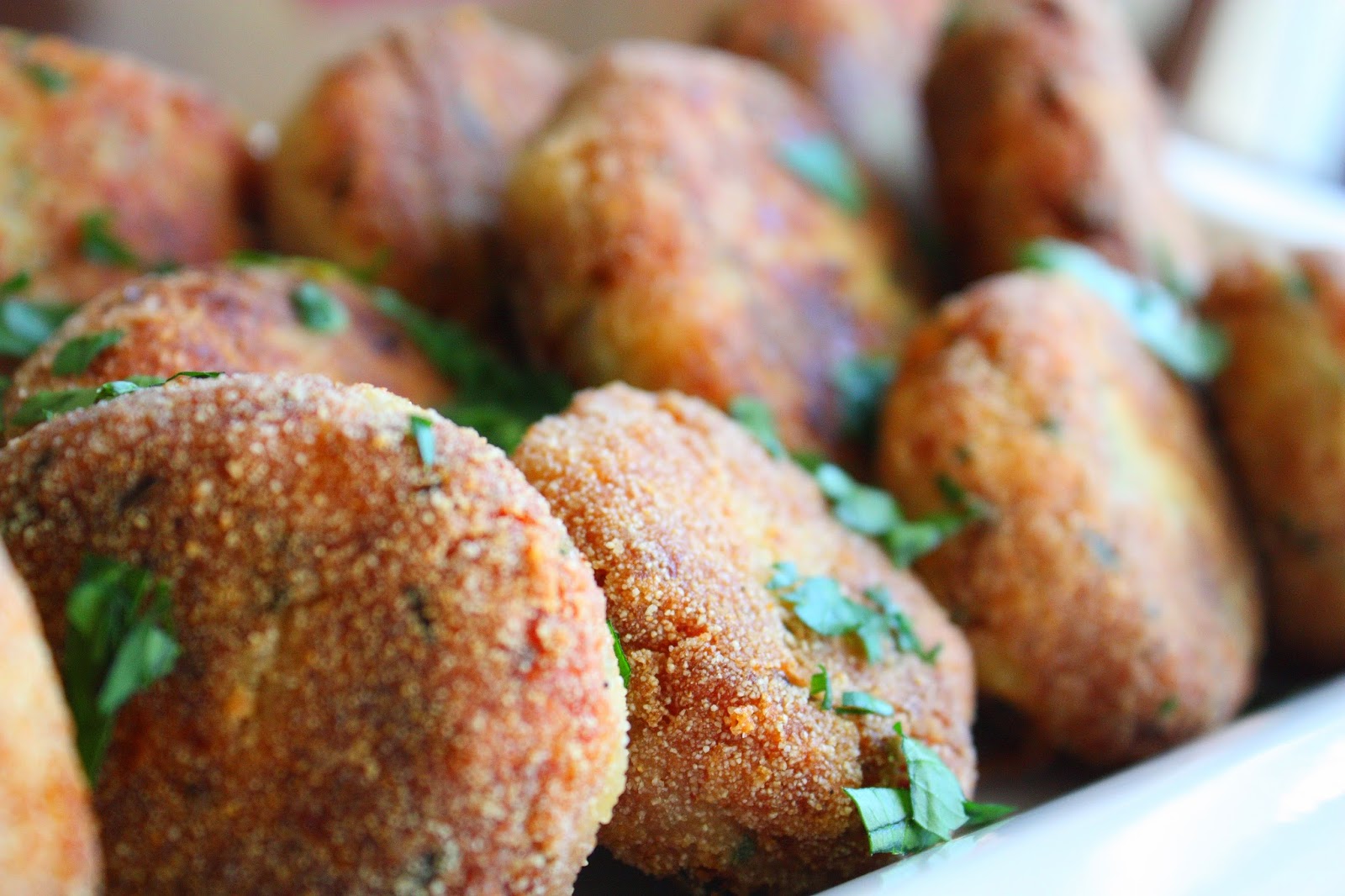
Maltese Pulpetti (Corned Beef Croquettes)

Qagħaq Ta'l-Għasel (Molasses Rings)
Share your favorite food place on Malta!

Picture of Bragioli
- Cook time 10 min
- Prep time 30 min
- Author Jamie
- 10 thin slices of rump steakStuffing:
- 1/2 lb ground beef
- 6 bacon strips
- 2 hard-boiled eggs
- 2 tbsp chopped parsley
- 4 tbsp bread crumbs
- 1 carrot grated
- pepper and salt
- 2 large onions, chopped
- 3 garlic cloves, crushed
- 4 tomatoes, peeled and chopped
- 1 tsp tomato paste
- 2 carrots, scraped and sliced
- 1/2 cup peas
- 2 potatoes, peeled and quartered
- 2 bay leaves
- 1 tsp Worcestershire sauce
- 1/2 cup red wine

- Heritage Malta
- Discussions

Search Hotels in Malta
Check-in date
Check-out date, bragoli – beef rolls or olives in stew.

Leave a Reply Cancel reply
Your email address will not be published. Required fields are marked *
Save my name, email, and website in this browser for the next time I comment.
CAPTCHA Code *
This site uses Akismet to reduce spam. Learn how your comment data is processed .


Home » Info » Malta » Maltese Food: A Guide to the Island’s Tasty Delights
Maltese Food: A Guide to the Island’s Tasty Delights
Last Updated: Jul 30, 2023 Reading Time: 13 minutes By: Shaun
The Maltese cuisine is a reflection of the island’s rich history and culture, blending influences from the nearby Mediterranean countries as well as the British.
The traditional food of Malta is hearty, flavorful, and full of fresh ingredients, making it a must-try for foodies. Whether you are a meat lover or a vegetarian, there is something for everyone in Maltese cuisine. Let’s dive into some of the most famous traditional dishes from Malta.
Street Food

Pastizzi is a traditional Maltese pastry made up of crispy and flaky pastry filled with ricotta cheese or mashed peas. To achieve the flakiness, in the pastizzi, the pastry is stretched and folded with layers of fat spread between the layers of pastry.
While they are typically a savoury snack, there are some sweet variations with fillings such as Nutella or sweet cheese. Pastizzi shops are very common through the islands and provide a cheap snack ideal for when you are on the go.
One renowned to serve some of the best pastizzi across the island is Crystal Palace in Rabat. Make sure you pass by when you are visiting Mdina and Rabat.
Pastizzi shops do not only sell pastizzi, and another popular snack with the locals are Qassatat. They are made of a dough that gets filled with the same ricotta cheese or mashed peas used in pasitizzi and shaped like a large dumpling.
Qassatat, just like pastizzi, are not the healthiest of snacks but are worth trying at least once.

Another popular food option available from Pastizzi shops is Timpana. This is a baked pasta dish that features macaroni pasta, tomato sauce, minced beef, and a layer of pastry on top.
Timpana is believed to have originated in Sicily, where it was known as Timballo. The dish made its way to Malta during the Arab occupation and has since become an integral part of Malta’s cuisine.
Ħobż biż-Żejt

Ħobż biż-Żejt means simply “bread with oil” and is a favourite snack with many locals, especially when consumed by the sea. There are countless variations on how one can make Ħobż biż-Żejt, but you always need to start with some fresh Maltese ftira (flattened sourdough bread), which gets cut in half and both sides get spread with some tomato paste.
The bread then gets filled with a mix of local ingredients like tomatoes, olives, onions, tuna, capers, and a drizzle of olive oil. There is no limit to what else you can add, with some preferring to add pickled onions and even artichoke hearts to the mix.
The significance of Maltese ftira for the local culture was acknowledged in 2020 when it was added to UNESCO’s Intangible Cultural Heritage List .
Savoury Dishes

Rabbit Stew
Fenek (rabbit in Maltese) is probably the food that many Maltese consider the country’s national dish. It is so integral to Maltese culture and family life that it is often served at family gatherings and on special occasions.
Rabbit can be served in a number of ways. The most traditional is Stuffat tal-Fenek (rabbit stew), in which the meat is first marinated in wine and then cooked in a sauce of garlic, onions, tomatoes, and peas, together with a variety of herbs and spices. The stew is left simmering until the meat starts falling off the bone. The sauce can then be mixed with spaghetti to create Spagetti tal-fenek (spaghetti with rabbit sauce), which is often served as a starter.
Alternatively, one can opt for Fenek Moqli (fried rabbit), where the rabbit pieces are pan-fried with garlic and served with a side of roast potatoes.

Bragioli, also known as beef olives, are thin slices of beef that get rolled with a mixture of bacon, onions, hard-boiled eggs, parsley, and breadcrumbs. The beef rolls are then slow-cooked in a thick tomato-based sauce until soft and delicious.
According to the history books, the dish was introduced by the Knights of St. John, who brought with them the food traditions of their home countries when they settled in Malta. The name “Bragioli” comes from the Italian word “braciola”, which translates to a thin slice of meat". Bragioli is another great example of the fusion of Sicilian and Maltese cuisines.
Torta tal-Lampuki
Torta tal-Lampuki (Lampuki Pie) is a pie that, as the name suggests, has as its main ingredient a type of fish called Lampuki, which is the Maltese name for dorado or mahi-mahi. Lampuki are in season during late summer and autumn , when the fish migration path takes them close to Malta.
While lampuki can be cooked in a variety of ways, one of the most traditional is to serve it as a pie. The fish is first boiled and then mixed with onions, tomatoes, peas, and cauliflower, along with herbs and spices. This mix is then used to fill a pastry crust and cooked in an oven.

Aljotta is a traditional soup made with fish that is very common during the period of Lent, when people avoid eating meat. The soup uses whole small fish like rockfish, sprats, sardines, or bogue and adds onion, garlic, tomato, mint, marjoram, and sherry or wine for flavour.
It is usually eaten hot with slices of lemon. Some people prefer to filter the soup to get rid of the fish bones, while others like to chew on them. Aljotta is a simple but tasty dish that reflects the humble and traditional Maltese food culture.
Ross il-Forn
Ross il-Forn, which translates to “rice in the oven” or just “baked rice”, is one of those Maltese dishes that many families love to make for Sunday lunch. The rice gets mixed with minced meat and tomato sauce, and optionally, one can also include vegetables like courgettes or carrots in the sauce. The rice is partly cooked and then combined with minced meat, tomatoes, cheese, and eggs; optionally, one can also include vegetables like courgettes or carrots.
The mixture is then put in a baking dish and covered with more cheese. The casserole is baked until golden and bubbly. Ross il-Forn can be eaten either hot or cold.

Kapunata is the Maltese answer to the Sicilian Caponata or the French Ratatouille. It usually consists of a variety of vegetables, including tomatoes, eggplants, onions, and bell peppers. The vegetable mix is then spiced with a selection of Mediterranean herbs, such as thyme, rosemary, and bay leaves. Some variations also add capers and olives, which add a tangy and salty flavour to the dish.
The mix is then typically cooked slowly over low heat until the vegetables are tender and flavorful. Kapunata can either be eaten as a dip with some Maltese bread, used in a pasta sauce, or served as a side dish to your main course.
Zalzett tal-Malti
Zalzett tal-Malti (meaning Maltese sausage) is a type of sausage that is native to the Maltese islands. The sausage is made from minced pork mixed with a variety of seasonings, including garlic, coriander, fennel, caraway, salt, and pepper.
Zalzett tal-Malti is a versatile sausage that can be enjoyed in a variety of ways. It can be cut into cubes or slices and served as an appetiser accompanied by crackers and cheese. Some even use it as a pizza topping or as an ingredient in their pasta sauce, which adds a unique flavour to their dish.

Bigilla has been a part of Maltese cuisine for centuries. It is believed that the food originated in North Africa and was brought to Malta by the Arabs during their occupation of the island in the 9th century.
The ingredients used in Bigilla are simple and wholesome. The main component is broad beans, which are boiled until soft and then mashed with garlic, olive oil, lemon juice, and a variety of spices such as cumin and paprika. The result is a thick paste that is then left to cool before serving.
The paste is then either used as a dip with galletti (a type of round cracker), a piece of ftira, or some other Maltese bread, or it can be used as an ingredient in Ħobż biż-Żejt.

Ġbejniet is a cheeselet made in Malta and Gozo that is made from sheep’s milk, although some varieties may use goat’s milk as well. It is a small, round cheese that can be consumed fresh or aged. The cheese has a mild, slightly salty flavour that becomes more pronounced with age.
There are several variations of Ġbejniet that can be found across the island. These include fresh, mature, smoked, peppered, and sundried varieties. Ġbejniet can be eaten as a snack, as part of a salad or a pasta dish, or even in pies.
Soppa Tal-Armla
Malta might not get freezing temperatures, but you still need something to warm you up on a cold day, so why not try “Soppa Tal-Armla”, which literally translates from Maltese to “widow’s soup”. This traditional soup is made with fresh vegetables, eggs, and cheese, and it’s a staple in many Maltese households.
Soppa tal-armla is named after the widows who used to make it with cheap and simple ingredients. It’s a great way to use up any seasonal vegetables you have on hand, such as cauliflower, potatoes, carrots, celery, peas, and broad beans. You can also add marrow or courgette for extra flavour and texture.
The soup is flavoured with onion, garlic, parsley, and tomato paste and cooked in vegetable or chicken stock. The secret ingredient is Ġbejniet which melt into the hot soup, creating a creamy and cheesy sauce.
Sweet Treats

Qubbajt is a nougat candy that is made with almonds and honey. It’s a popular treat in Malta and can be found in many local shops and markets. During the traditional festas that get organised in the villages in the summer, it’s very common to find food trucks and stands that sell this delicacy.
The word “qubbajt” comes from the Arabic word “qubbaj” which means “to cook”. The candy is made by cooking honey and sugar together until it reaches the right consistency and then adding roasted almonds and other flavourings.
There are different types of qubbajt, including the soft and chewy kind as well as a harder, more brittle version. Some varieties may also include other ingredients like pistachios or hazelnuts.
Kannoli tal-Irkotta

Kannoli tal-Irkotta are very similar to the Italian cannoli but have some distinctive features that make them uniquely Maltese. They are made of a crispy pastry tube stuffed with a filling made from fresh ricotta cheese, sugar, orange zest, vanilla essence, chocolate chips, cinnamon, and pistachios.
What distinguishes them from their Italian counterparts is that the dough that makes the crust is typically flavoured with wine and cocoa powder, while the filling usually doesn’t have the variety of fruits found in other variations.

This delicious pastry is made from a filling of dates mixed with a few spices, such as cinnamon and cloves. The imqaret are then deep-fried until golden brown.
Imqaret are traditionally served as a dessert or a sweet snack and are usually accompanied by a cup of tea or coffee, which helps to balance out the sweetness of the pastry.
While the traditional Imqaret are made with a date filling, there are variations that add a creative twist to this delicacy. Some people add nuts such as almonds or walnuts to the filling for added texture and flavor, while others add a little bit of honey or maple syrup to the filling for added sweetness. As a final touch, one can also sprinkle powdered sugar on top of the imqaret.
Kwarezimal is a traditional sweet made from a blend of ground almonds, honey, and spices, including cinnamon and cloves. It’s typically shaped into small, oval-shaped biscuits and baked until golden brown.
The name “Kwarezimal” is derived from the Latin “quaranta,” meaning “forty”. This is because Kwarezimal is traditionally made during the forty days of Lent leading up to Easter, when many Maltese people abstain from eating sweets, meat, and dairy products.
Ħelwa tat-Tork

Ħelwa tat-Tork, which translates to “Turkish sweet” is believed to have been introduced to Malta by the Ottoman Empire during the 16th century. Over time, the recipe has evolved and is now a beloved part of Maltese culture. The sweet is often served at celebrations, such as weddings and christenings, and is also a popular souvenir for visitors to take home with them.
Ħelwa tat-Tork is best enjoyed together with a hot cup of tea or coffee. Its nutty flavour and chewy texture make it a satisfying snack, and it is another great way to experience and taste the culture of Malta.

During the Easter season, there is nothing more traditionally Maltese than Figolli. They are a sweet pastry made with almond and vanilla flavours and are shaped into various forms, such as hearts, rabbits, fish, lambs, and other Easter-related shapes. Figolli are usually decorated with colourful icing and sometimes even chocolate.
The tradition of making and eating figolli dates back to the time when Malta was under British rule. During Easter, the British would exchange gifts, including sweet treats. This tradition was adopted by the Maltese, and figolli became a popular gift to give to family and friends during the Easter season.
Qagħaq tal-Għasel

Qagħaq tal-Hħasel is another traditional pastry that many like to enjoy with a cup of tea or coffee. The name itself means “honey ring” in Maltese, and the pastry is known for its sweet and sticky texture.
The pastry dough is made with flour, egg yolks, margarine, and either water or anisette liqueur, and the filling has black treacle, water, sugar, semolina, cocoa powder, aniseeds, orange flower water, and grated citrus zest.
Kinnie is a unique drink that is brewed from bitter oranges and extracts of wormwood, which is a herb that gives it a distinctive bitter taste. It was first introduced in 1952 by the brewery Simonds Farsons Cisk as an alternative to the cola drinks that dominated the post-war European market.
Kinnie has a brown colour and a complex aroma that combines citrus, herbal, and spicy notes. It can be drunk straight or mixed with alcohol, such as gin or vodka, to create a refreshing cocktail. Some people also like to add a slice of lemon or orange to enhance the flavour.
Kinnie is considered Malta’s favourite non-alcoholic beverage and is a must-try for anyone who wants to indulge in the flavours of Malta and Gozo. Apart from the classic taste, one can also find different variants of Kinnie, such as Diet Kinnie, Kinnie Zest (a low-calorie version with a stronger orange flavour), and Kinnie Vita (a version sweetened with stevia leaf extract).

Another drink that is the pride and joy of the locals is Cisk. This beer was launched in 1929 by the same brewery that created Kinnie and takes its name from the founder, who was nicknamed “ic-Cisk”.
Cisk is a golden-coloured lager with a crisp and refreshing taste, a balanced bitterness, and a malty aroma. It has an alcohol content of 4.2%.
Cisk is widely available in Malta and is the perfect companion for all the foods we discussed above. Cisk is also exported to several countries around the world, such as the UK, Italy, Germany, Canada, and Japan.
This beer has won many awards for its excellence and quality, such as the gold medal at the International Brewing Awards in 2013 and 2019. There are also other variants of Cisk, such as Cisk Excel (a low-carbohydrate beer), Cisk Chill (a flavoured beer with lemon or berry), and Cisk Strong (a high-alcohol beer).
To wrap up, Maltese cuisine is a fascinating and delicious blend of Mediterranean flavours and influences from its diverse cultural history. From savoury pastizzi and hearty stews to sweet Qagħaq tal-Għasel and Imqaret, the Maltese kitchen offers a unique culinary experience that is sure to tantalise your taste buds.
So when you are visiting Malta, make it a point to explore some of the food that is synonymous with the Maltese islands.
Frequently Asked Questions
What makes maltese food so unique.
Maltese food is unique because it's a fusion of different culinary traditions. Due to Malta's location at the crossroads of the Mediterranean, its food has been influenced by Italian, Arabic, North African, and British flavours and techniques. This has resulted in a rich culinary culture that's full of flavor and variety.
What are some must-try dishes in Malta?
Some must-try dishes in Malta include rabbit stew, beef olives, and kapunata. For street food, be sure to try pastizzi, qassatat, and ħobż biż-żejt. And for dessert, imqaret, ricotta kannoli, and ħelwa tat-tork are all delicious options.
Are there any vegetarian or vegan options in Maltese cuisine?
Yes, there are plenty of vegetarian and vegan options in Maltese cuisine. Vegetable stews like kapunata and soups like minestra are often vegetarian, and many pastries and sweets are made without meat or animal products. Be sure to ask at restaurants and cafes for vegetarian or vegan options.
What are some popular seafood dishes in Malta?
Given Malta's location in the Mediterranean, seafood plays a big role in its cuisine. Some popular seafood dishes in Malta include aljotta (a fish soup), lampuki pie (a fish pie), and grilled calamari. Be sure to try some fresh fish at a seaside restaurant for a true taste of Maltese seafood.
What is the national dish of Malta?
While there is no official national dish of Malta, rabbit stew (stuffat tal-fenek) is often considered to be a quintessential Maltese dish. Rabbit is a common meat in Malta, and the stew is typically made with onions, garlic, tomatoes, and wine.
What are some typical ingredients found in Maltese food?
Typical ingredients in Maltese food include fresh seafood, rabbit, pork, tomatoes, onions, garlic, olive oil, octopus, capers, and olives. Herbs and spices like parsley, thyme, mint, and cinnamon are also commonly used in Maltese food.
About Shaun
Shaun is a passionate traveller from Malta who loves sharing his experiences with others. With a deep-seated wanderlust and a desire to explore new places.
This blog serves as a platform to inspire and motivate fellow travellers who are also searching for bliss in their lives through travel.
More About Malta


20 traditional Maltese foods and where to eat them
January 25, 2024 | Posted in: Malta
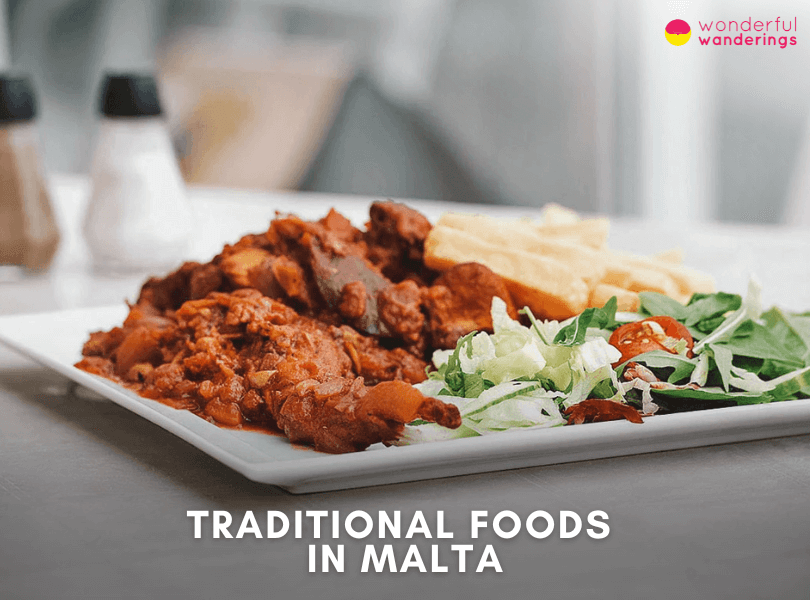
Malta, an archipelago in the Mediterranean, boasts a culinary tradition that reflects its diverse history and cultural influences. Valletta, the capital of Malta, offers an array of traditional Maltese foods. In Malta, one can savor Ftira at numerous eateries, each presenting its unique take, incorporating potatoes, onions, cheese and more. Pastizzi, small pastries with flaky filo dough, are another Maltese staple. These pastries, filled with ricotta or spiced meat, are best enjoyed fresh and can be found in local cafes and street vendors across Malta. The Maltese cuisine offers a wide array of traditional dishes, each telling a story of the island's heritage. Visitors must explore the various local eateries and restaurants scattered across the islands, where these traditional dishes are prepared with authenticity and passion. Each restaurant and café in Valletta adds its unique touch to these classic recipes, inviting locals and visitors alike to experience the authentic tastes of Malta.
Listed below are the traditional Maltese foods.
- Ftira. Ftira is a traditional Maltese flatbread with a thick crust and airy interior featuring large holes. Ftira is commonly used for sandwiches with Mediterranean ingredients like olive oil, tomatoes, tuna, capers, olives and herbs. Variations include artichoke hearts, hard-boiled eggs, anchovies or pickled vegetables. Ftira fillings vary widely, including options like potatoes, onions, tomatoes, local cheese, sausage, eggs, vegetables and seafood.
- Pastizzi. Pastizzi are small Maltese pastries with a flaky filo dough, encasing fillings like ricotta cheese, mushy peas or spiced meat. Best enjoyed freshly baked, they offer a contrast of crispy exterior and soft filling. They can be complemented with lemon, vinegar, harissa or bigilla. Main ingredients include flour, water, olive oil and various fillings.
- Hobz biz-zejt. This Maltese street food consists of crusty bread, brushed with olive oil and rubbed with sweet tomato paste, then topped with tuna, capers, olives, onions and herbs. Toppings vary, including artichoke hearts, eggs, anchovies, pickled vegetables, sausage or cheese. It's often seasoned with lemon, vinegar, harissa or bigilla. Key ingredients are crusty bread, tomato paste, olive oil and fresh herbs.
- Qassatat. Qassatat is Maltese pastries with a soft, bread-like dough and fillings like ricotta, peas, spinach or anchovies. L'Accademia in Valletta is recommended for its fresh qassatat. Variations include tuna, sausage, spinach, cheese, pumpkin or sweet fillings. Complementary flavors can be added with lemon, vinegar, harissa or bigilla.
- Timpana. A hearty Maltese dish, timpana consists of pasta in tomato sauce, encased in a pastry crust. Variations include different meats, vegetables or seafood in the sauce. It can be brightened with lemon or vinegar or enhanced with harissa or bigilla. The dough is made from flour, butter or oil, salt and water, while the filling includes a tomato or meat sauce, pasta, egg and cheese.
- Kapunata. Kapunata is Malta's version of the Mediterranean vegetable stew caponata, combining bell peppers, eggplant, tomatoes, onions, olives, capers and herbs. Kapunata's versatility allows for the inclusion of various seasonal vegetables and it can be brightened with lemon or red wine vinegar or spiced up with harissa paste or bigilla, a Maltese fava bean condiment.
- Fenek moqli. Fenek moqli, a traditional Maltese dish, features rabbit meat marinated in white wine, garlic and herbs, then fried in olive oil. Variations include different marinade spices, with additions like capers or preserved lemon, enhancing the dish's flavor. Served without sauce, it pairs well with lemon, vinegar, harissa paste or bigilla for added depth.
- Bragioli. Bragioli or beef olives, are a Maltese classic comprising thin beef slices stuffed with eggs, bacon, cheese, breadcrumbs and herbs, then braised in tomato or meat sauce. Variations in bragioli include different stuffing or sauce types, with additions like olives, anchovies or raisins. The combination of beef, stuffing, tomatoes, vegetables and herbs, slowly braised, transforms these ingredients into a cherished Maltese specialty.
Ftira is a traditional Maltese flatbread baked on the islands for centuries. It has a thick crust and a light, airy interior texture with large, irregular holes. Ftira is made from a sourdough starter and is flatter and baked at a higher temperature than other Maltese breads. It is often cut in half horizontally and filled with Mediterranean ingredients like olive oil, tomatoes, tuna, capers, olives and herbs to make a sandwich. Ftira is best served as a sandwich filled with ingredients like tuna, tomatoes, capers, onions and olives. The combination of the savory tuna and briny capers and olives perfectly complements the lightly charred, olive oil-brushed ftira bread. Some also like to add artichoke hearts, hard-boiled eggs, anchovies or pickled vegetables for extra flavor and crunch. Ftira sandwiches can be made ahead, wrapped in plastic with a weight on top, allowing the bread to soak up the delicious flavors.
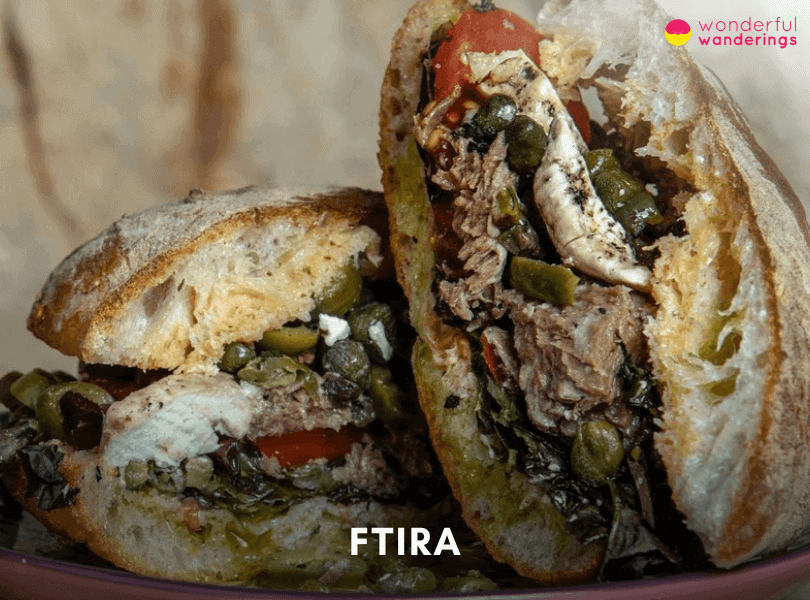
One of the best places to eat ftira in Valletta is 67 Kapitali. It is located on a side street near the Upper Barrakka Gardens, this small family-run cafe serves what many call the best ftira sandwich in Valletta. Made with high-quality ingredients on freshly baked ftira, it's a favorite of both tourists and locals alike. Ftira can be considered healthy, as it is made from simple, natural ingredients like flour, water, salt and olive oil. There are many variations of ftira fillings beyond the classic tuna, tomato and olive version. In Gozo, ftira is often topped with thinly sliced potatoes, onions and tomatoes before baking like a pizza. Ftira can also be stuffed with local ġbejniet cheese, Maltese sausage, eggs, vegetables or different types of seafood and fish. The possibilities are endless.
Maltese ftira sandwich would be complete without a drizzle of fruity, peppery, extra virgin olive oil and a sprinkling of fresh herbs like parsley, basil or oregano. Spicy harissa, tangy lemon juice or a spread of bigilla, a thick dip made of mashed fava beans, garlic and olive oil, also make excellent condiments for ftira. The simple and humble ingredients needed to make ftira include flour, water, salt, olive oil and time for the dough to slowly ferment and rise using a sourdough starter before being baked to crusty, chewy perfection.
2. Pastizzi
Pastizzi are a Maltese snack – small, diamond or round-shaped pastries with flaky, crispy filo dough encasing fillings like ricotta cheese, mushy peas or spiced meat. Pastizzi are best enjoyed freshly baked and served warm, with the crispy exterior giving way to the hot, soft filling inside. The sweet, creamy ricotta filling paired with the buttery, baked dough makes for the perfect contrast of flavors and textures. One of the most famous places to eat pastizzas in Valletta is the Crystal Palace Bar. Tucked away on a side street across from Mdina, this local spot serves what many hail as the best pastizzi on the island, with a stellar ricotta filling and pastry baked perfectly crisp.
Pastizzi would not be considered the healthiest of Maltese foods. The combination of refined carbs from the dough and high-fat cheeses or creamy fillings add to the calories. Those looking for a healthier option can find versions made with whole grain doughs or lighter fillings like chicken or vegetables. There are countless variations on fillings for pastizzi beyond the classic cheese and pea versions. Some popular options include spiced beef, tuna, caponata, spinach and cheese, pizza or Nutella for a sweet take. The dough can also be played with – instead of the iconic filo, some make pastizzi with puff pastry, brioche dough, pizza dough or a gluten-free option.
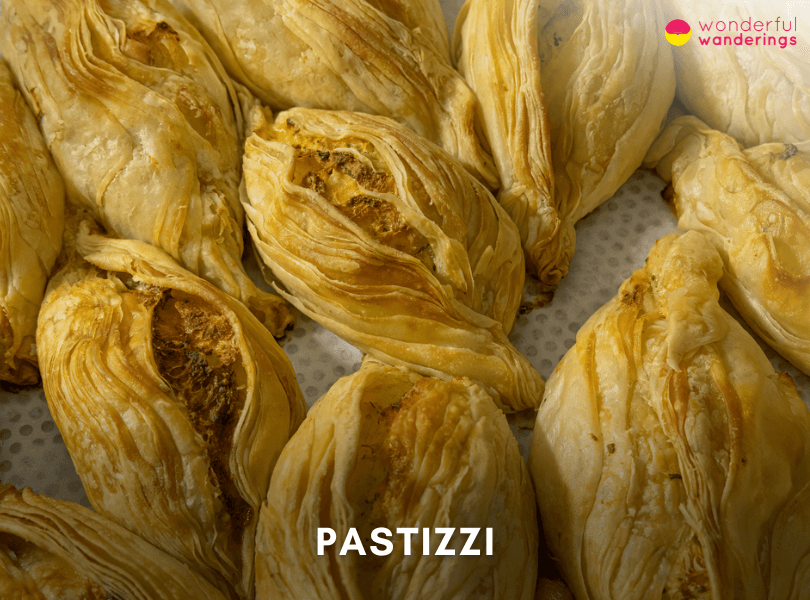
No sauce is served alongside plain pastizzi, they can be nicely complemented by a squeeze of lemon or a drizzle of vinegar for some brightness. Spicy harissa paste or the classic Maltese condiment, bigilla, a thick pate of mashed fava beans, garlic and olive oil, also make tasty dips for pastizzi. The main ingredients for making the pastry dough include flour, water, olive oil and salt. Fillings vary, but usually involve fresh soft cheeses like ricotta or ingredients like peas slow-cooked into a thick paste as the base.
3. Hobz biz-zejt
Hobz biz-zejt or “bread with oil” in English is a beloved Maltese street food consisting of crusty, olive oil-brushed bread that is rubbed with sweet and tangy tomato paste known as kunserva helwa and then topped with ingredients like tuna, capers, olives, onions and herbs. The combination of the hearty bread, fruity tomato paste, briny capers and olives and quality olive oil makes this simple open-faced sandwich extremely craveable.
Hobz biz-zejt is best served as soon as it's assembled, while the bread is still warm and crunchy on the outside but soft and chewy on the inside. The capers, olives and olive oil soak into the bread, allowing all the Mediterranean flavors to meld together. It can be eaten as a snack, appetizer or even a light meal, especially if bulked up with tuna, sausage or cheese.
One excellent place to sample hobz biz-zejt in Valletta is the Is-Suq Tal-Belt food market. This market in the town center features various small eateries and stalls selling traditional Maltese street food like pastizzi and hobz biz-zejt made with high-quality, local ingredients. Locals and visitors rave about the market's simple but delicious hobz biz-zejt sandwiches. Hobz biz-zejt is high in carbs from the bread, it can be a relatively healthy snack or meal when enjoyed in moderation and made with quality olive oil and vegetables or fish. There are many variations of hobz biz-zejt toppings to try. Some add artichoke hearts, hard boiled eggs, anchovies, pickled onions or bell peppers, Maltese sausage or local goat cheese.

No sauce is served with hobz biz-zejt, the sandwich can be nicely complemented by a squeeze of lemon or red wine vinegar for some brightness. Spicy harissa paste or the classic Maltese condiment bigilla, a thick spread made of fava beans, garlic and olive oil, enhances the flavors. The main ingredients needed to prepare hobz biz-zejt are crusty bread like ftira, tomato paste, extra virgin olive oil, capers, olives, onions and fresh herbs like parsley or basil. High-quality ingredients, especially the olive oil and tomatoes, are key.
4. Qassatat
Qassatat are small savory pastries that are a popular street food and snack in Malta, similar to the more well-known pastizzi. Qassatat have a soft, bread-like dough folded over fillings like ricotta, mushy peas, spinach or anchovies. They are best served warm right after baking, when the exterior is still crisp and the filling is hot and gooey. The sweet, creamy ricotta filling paired with the soft, olive oil-brushed dough makes for a contrast of flavors and textures. One excellent spot to sample qassatat in Valletta is the small bakery and cafe L'Accademia. Tucked away on Old Theater Street, this family-run cafe bakes fresh qassatat daily to be enjoyed alongside coffee by tourists and locals alike.
Qassatat would not be considered the healthiest of snacks given their refined carbs and high-fat cheese fillings. Those looking for a healthier take can find qassatat made with whole grain doughs or lighter fillings like vegetables. Fillings for qassatat can vary beyond the usual ricotta or mushy peas. Some popular alternatives include tuna, caponata, sausage, spinach and cheese, pumpkin or sweet options like chocolate or Nutella. The dough can also be adapted – instead of the traditional soft dough, some make qassatat with flaky filo, puff pastry, pizza dough or gluten-free options.
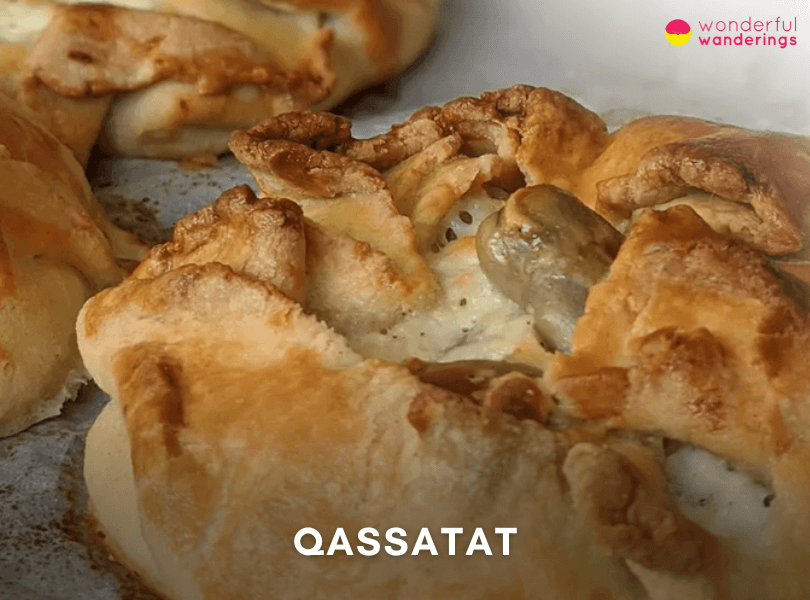
No sauce is traditionally served with a qassatat, but they can be nicely complemented by a squeeze of lemon or red wine vinegar for some brightness. Spicy harissa paste or the classic Maltese condiment bigilla, made of mashed fava beans, garlic and olive oil, also enhances the flavors. The main ingredients needed to make qassatat are bread dough, a filling like ricotta or mushy peas, olive oil for brushing and herbs for garnish. Using quality, fresh ingredients is key, especially for the dough and cheese.
Timpana is a Maltese baked pasta dish consisting of macaroni or penne tossed in a meaty tomato sauce, all encased in a crisp pastry crust. It is an extremely hearty and filling meal, essentially combining carbs with more carbs. The sweet tomato sauce soaks into the al dente pasta and complements the buttery, flaky pastry crust. Timpana is best served straight from the oven, piping hot. As cut into the crispy pastry shell, waves of steam carrying the rich scent of tomato and meat sauce billow out. The first bite yields the shattering crust and chewy pasta soaked in the flavorful ragu.
Made with quality ingredients and perfectly baked, locals and visitors rave about the timpana here, particularly the classic version with a hearty meat sauce. Timpana would not be considered the healthiest dish given the refined carbs and high fat content. Some healthier variations substitute the meat sauce with vegetables or chicken. There are endless variations on timpana fillings beyond the standard ground meat sauce. Some alternatives include tuna, sausage, caponata, seafood, pumpkin or sweet options like chocolate or Nutella. The pasta can also be adapted, using penne, ziti, gluten-free pasta or even replacing it entirely with layers of roasted vegetables for a meatless version.
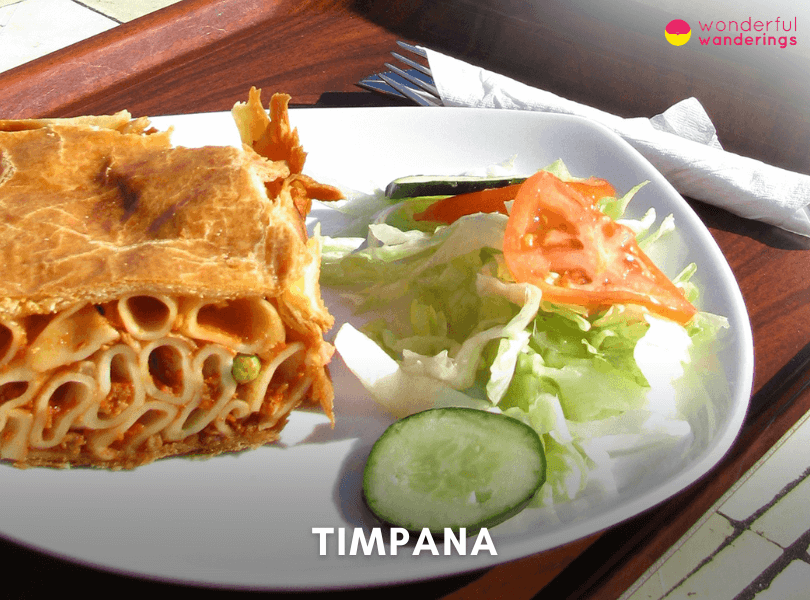
No sauce is served with timpana, the pie can be nicely complemented by a squeeze of lemon or vinegar for brightness. Spicy harissa paste or the classic Maltese condiment bigilla, made of mashed fava beans, garlic and olive oil, enhances the flavors beautifully. The humble ingredients needed to make the pastry dough for timpana include flour, butter or oil, salt and water. The filling starts with a tomato or meat sauce made from ingredients like onions, garlic, ground meat, tomato paste and spices. The sauce is then tossed with cooked pasta, egg and cheese before being encased in pastry and baked to golden perfection.
6. Kapunata
Kapunata is the Maltese take on the popular Mediterranean vegetable stew caponata. It features bell peppers, eggplant, tomatoes, onions, olives, capers and herbs sautéed together into a delicious sweet, sour and salty medley. Kapunata is best served warm, with the vegetables at the peak of flavor and the bread still crusty on the outside. A spoonful of the chunky vegetable mixture can be enjoyed as is or piled high on a thick slice of traditional ftira or ħobż bread. The combination of the bread and the flavorful vegetable relish is heavenly. Kapunata would not be considered the healthiest of dishes given the olive oil and sodium content. Using less oil when sautéing the vegetables or serving smaller portions helps decrease the fat and calorie count.
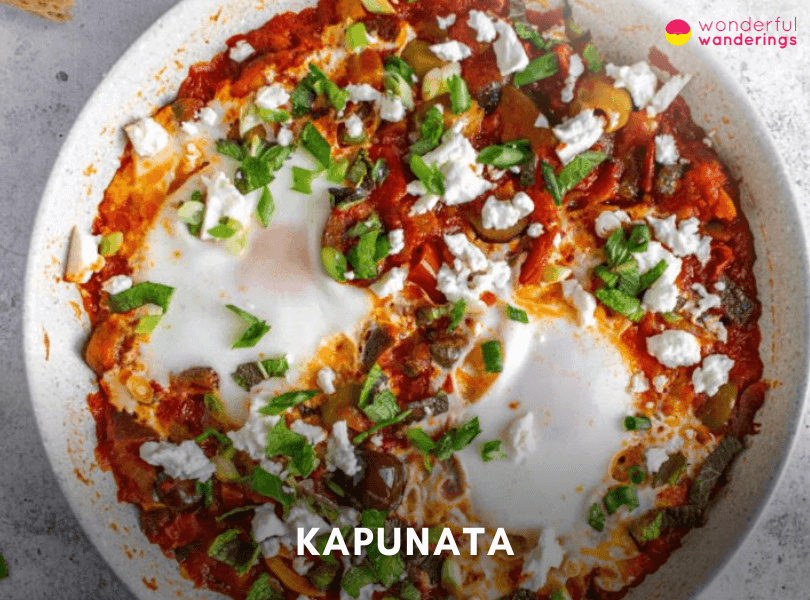
There are endless variations on kapunata ingredients beyond the standard vegetables. Some add cubed potato or carrot for extra bulk and sweetness. Courgette, pumpkin, spinach or other greens also make tasty additions. The possibilities are endless – the beauty of kapunata is flexibility with what is fresh and in season. No sauce is traditionally served with kapunata, the medley can be nicely complemented by a squeeze of lemon or red wine vinegar for some brightness. Spicy harissa paste or the classic Maltese condiment bigilla, made of mashed fava beans, garlic and olive oil, enhances the flavors.
The main ingredients needed to prepare kapunata include olive oil, onions, garlic, tomatoes, bell peppers, eggplant, olives, capers and herbs like mint or parsley. Allowing the vegetable medley to cook down slowly brings out the flavors. Using ripe, high quality vegetables, especially the summer produce, is key for the best results.
7. Fenek moqli
Fenek moqli is a Maltese dish consisting of rabbit meat that is marinated in white wine, garlic and herbs before being fried in olive oil. The tender, succulent rabbit absorbs the garlic and herb flavors while developing a crispy exterior when fried. Fenek moqli is best served immediately after frying while the exterior is still crispy and the rabbit meat is piping hot and juicy on the inside. The fried rabbit is served with french fries or roasted potatoes and garnished with lemon wedges and parsley. An excellent place to sample fenek moqli in Valletta is Rubino., a Michelin Bib Gourmand restaurant tucked away on a side street. The rabbit is marinated to perfection in garlic and red wine before being fried crisp in olive oil. Served with roasted root vegetables, the fenek moqli at Rubino draws consistent praise.
Fenek moqli would not be considered the healthiest of dishes given its high fat and sodium content. When occasionally enjoyed in moderation as part of an healthy Mediterranean diet, fenek moqli can have a place. There are some variations of fenek moqli ingredients, with different herbs and spices used in the marinade. Some recipes call for additions like capers, olives, lemon zest or preserved lemon to the fried rabbit. Meats like chicken or beef can also be prepared in the same style as fenek moqli. The possibilities are endless, but high-quality, fresh ingredients are key, especially for the rabbit meat.
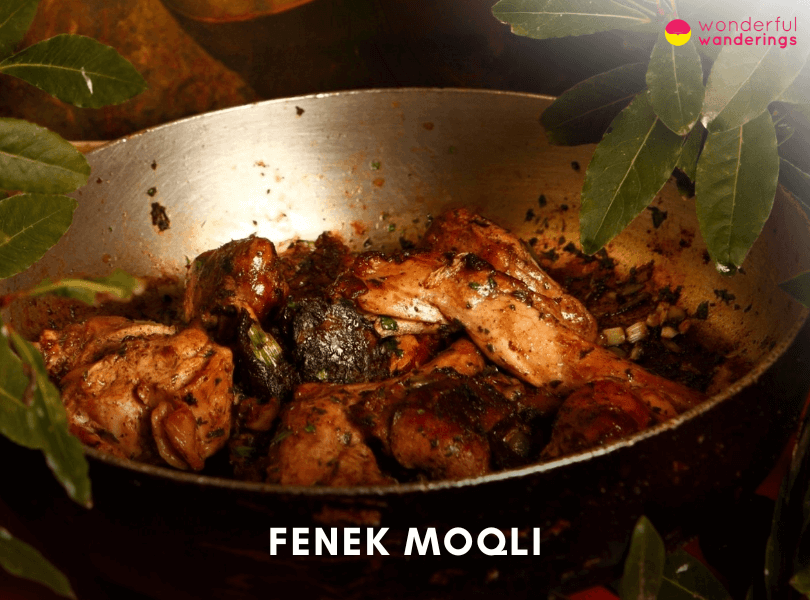
No sauce is served with the crispy fried rabbit, fenek moqli can be nicely complemented by a squeeze of lemon or red wine vinegar for some brightness. Spicy harissa paste or the classic Maltese condiment bigilla, made of mashed fava beans, garlic and olive oil, enhances the deep flavors beautifully. The ingredients needed to prepare fenek moqli include rabbit joints, white wine, garlic, herbs like thyme or rosemary, olive oil for frying and salt and pepper for seasoning. A simple marinade and quick fry transforms these basic components into an iconic, delicious Maltese specialty.
8. Bragioli
Bragioli, also known as beef olives, is a beloved traditional Maltese dish consisting of thin slices of beef stuffed with ingredients like eggs, bacon, cheese, breadcrumbs and herbs. The stuffed beef rolls are then braised in a tomato or meat sauce until tender. Bragioli is best served hot straight from the oven, allowing the beef to soak up the rich sauce flavors. An excellent restaurant in Valletta to sample bragioli is Luciano. This small, family-run spot tucked away on a side street is known for its high-quality, homemade Maltese dishes like the bragioli, which locals and visitors rave about.
Bragioli would not be considered the healthiest of dishes given its high fat and calorie content. A 200g serving contains about 400 calories and over half come from fat. Using leaner cuts of beef and minimal added oil helps decrease fat and calorie count. There are some small variations in bragioli recipes in terms of stuffing ingredients or type of sauce. Some recipes call for additions like olives, capers, anchovies, pine nuts or raisins to the stuffing mixture. The sauce may range from a simple tomato sauce to a more complex meat gravy.
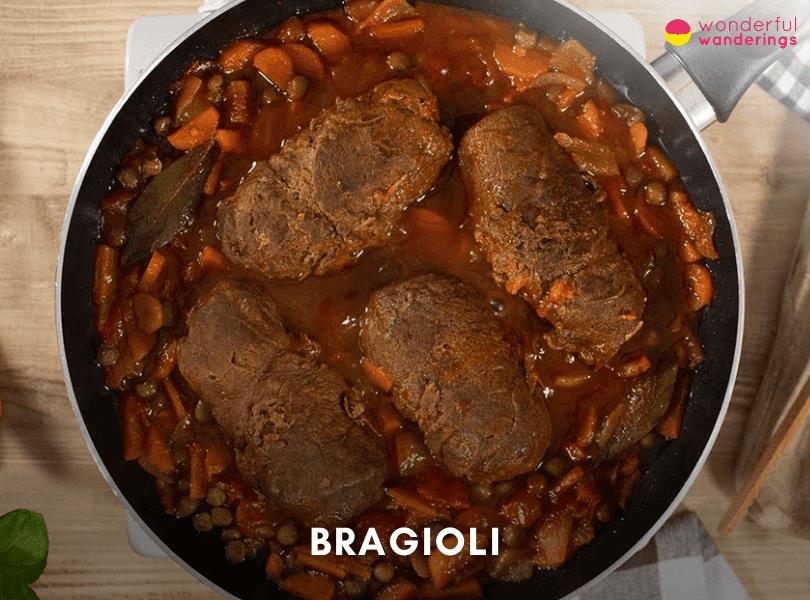
No sauce is served with bragioli, the rolls can be nicely complemented by a squeeze of lemon or vinegar for brightness. Spicy harissa paste or the classic Maltese condiment bigilla, made of mashed fava beans, garlic and olive oil, enhances the deep, hearty flavors. The main ingredients needed to prepare bragioli include thin slices of beef, stuffing ingredients like eggs and bacon, tomatoes and vegetable for the sauce and herbs. The stuffed beef to slowly braise builds complex flavors from these humble components into a beloved Maltese specialty.
Aljotta is a fish soup that has been a staple in Maltese cuisine for centuries. It features fish simmered in a broth of tomatoes, garlic, onions, olive oil, herbs and often rice. The soup is typically made with small whole fish like rockfish, allowing the heads and bones to impart flavor. Aljotta can have many variations but is best served piping hot, allowing the rice to soak up the rich flavors. Valletta offers a traditional take on aljotta made with quality ingredients. Aljotta would not be considered the healthiest soup given its carb, fat and sodium content. Lighter versions use less oil, smaller portions or more vegetables. There are endless variations on aljotta's ingredients beyond the standard fish, tomatoes and herbs.
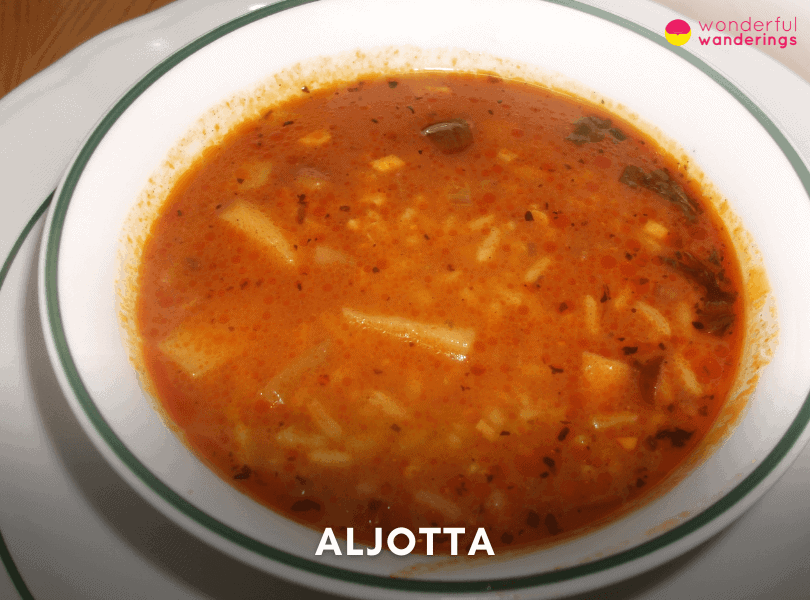
Some add root vegetables in Aljotta like potato or carrot for sweetness and heft. Courgette, pumpkin, spinach or shellfish also make tasty additions. The possibilities are based on the catch of the day. No sauce is traditionally served with aljotta, but the soup can be nicely complemented by a squeeze of lemon or vinegar. Spicy harissa paste or the classic Maltese condiment bigilla, made of fava beans, garlic and olive oil, enhances the flavors. The main ingredients needed to prepare aljotta include small whole fish, tomatoes, onions, garlic, olive oil, herbs like marjoram or mint and often rice.
10. Soppa tal-armla
Soppa tal-armla, also known as “widow's soup”, is a hearty and comforting Maltese soup made with vegetables like potatoes, carrots, kohlrabi, peas, beans and cauliflower. It gets its name from being an inexpensive soup originally made by widows using ingredients they had on hand. Soppa tal-armla is served warm with a poached egg and small fresh goat cheese called gbejna floating in each bowl. The soup is quite healthy as it contains many vegetables and gets creaminess from the egg and cheese rather than cream. One of the best places to sample authentic soppa tal-armla is Aaron's Kitchen on St Lucia Street.
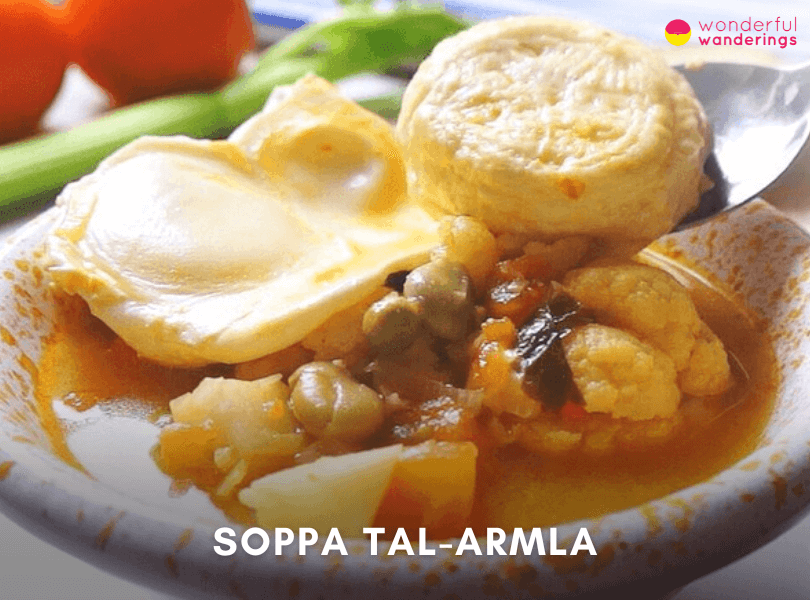
Modern versions vary in ingredients in Soppa tal-armla. Some cooks add chopped greens like spinach or Swiss chard. Others mix in tomato sauce or red wine for depth of flavor. Occasionally the soup is enriched with a spoonful or two of grated Parmesan or pecorino cheese. A few traditional sauces complement soppa tal-armla are salsa verde, gremolata and skordalia. Salsa verde is an Italian green sauce made with parsley, capers, garlic and olive oil that adds a bright herbal note. Gremolata is a garnish of lemon zest, garlic and parsley that provides a citrusy punch. Soppa tal-armla is simple to prepare at home. The base is olive oil, onion, garlic, celery, carrots, potatoes and tomato paste cooked down into a rich vegetable broth. Beans, cauliflower, peas and any other vegetables can be added to taste. The soup is piping hot with a final garnish of fresh parsley or chives. Soppa tal-armla truly brings out the fresh, garden-like flavors of Malta through humble ingredients elevated into comforting soup.
11. Stuffat tal-fenek
Stuffat tal-fenek, also known as “rabbit stew”, is a Maltese dish made by braising rabbit meat in a tomato and red wine sauce along with vegetables like potatoes, carrots, peas and sometimes pasta. It is considered the national dish of Malta. Traditionally, stuffat tal-fenek is served warm in deep bowls, often with the rabbit liver and kidneys included in the stew or served separately. The sauce also goes well ladled over pasta like spaghetti. Rubino's version contains high quality rabbit slow-cooked to tenderness in a sauce perfumed with garlic, bay leaves and red wine. The stew is packed with carrots, onions and potatoes and finished with imported Romano pecorino cheese.
Stuffat tal-fenek is reasonably healthy as the protein comes from lean rabbit meat instead of other fattier meats. The large amount of vegetables further increases the nutrition. Modern riffs on the stew sometimes include greens like chard or kale. The most common variations are cooking the rabbit with more garlic, adding capers, olives or chopped tomatoes to the sauce, using spaghetti instead of potatoes or switching out the rabbit for chicken or octopus. A few sauces that match the deep, wine-laced flavors of stuffat tal-fenek are salsa verde, gremolata and skordalia. Salsa verde, an Italian parsley and caper sauce, perks up the stew with herbal freshness.
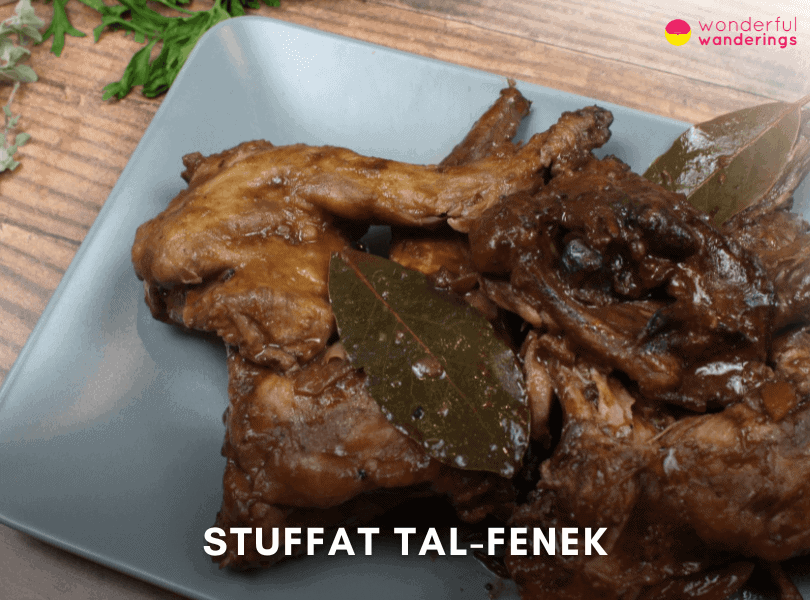
Stuffat tal-fenek starts by braising rabbit pieces in a garlic and wine marinade. Then onions, carrots, potatoes and tomato paste are added and slowly simmered until tender. Bay leaves, peas and other vegetables round out the ingredients. Simple to make but packed with the classic flavors of Malta, stuffat tal-fenek is a singular stew that represents the country in a bowl.
Kusksu is a Maltese soup made with broad beans, peas, small pasta beads called kusksu and often eggs and goat cheese. The small pasta pieces give kusksu its distinctive texture.
Kusksu is served warm in deep bowls with a poached egg and a small piece of tangy goat cheese called gbejna floating in each serving. The soup is quite healthy, getting creaminess from the egg and cheese rather than heavy cream. Some modern versions mix in greens like spinach or add tomato sauce for extra flavor. Kusksu is also sometimes served over spaghetti for a heartier meal.
One of the best places in Valletta to sample excellent kusksu soup is at Rubino. This restaurant overlooking the Grand Harbor uses high quality ingredients like fresh broad beans, housemade chicken stock and imported Italian pasta beads to create an authentic version. Some popular variations include adding fish, bacon, pumpkin or more vegetables like cabbage. The most “authentic” version remains kusksu bil-ful or “kusksu with broad beans”. No matter what ingredients are used, the small pasta pieces and poached egg finish are essential.
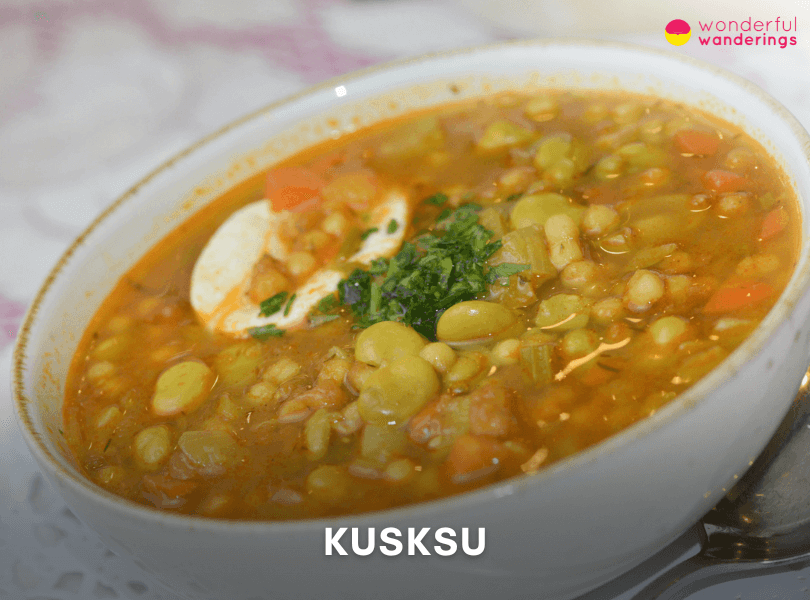
Some traditional Mediterranean sauces that perfectly match the flavors of kusksu are salsa verde, gremolata and skordalia. Kusksu starts by sautéing onions and garlic in olive oil before adding broad beans, tomato paste, chicken stock, pasta beads and herbs like bay leaves or mint. The soup simmers until the beans are tender before briefly cooking the pasta. Fresh parsley or chives finish this tasty Maltese specialty.
13. Imqarrun il-forn
Imqarrun il-forn, sometimes called “baked macaroni”, is a beloved Maltese dish made by baking tubular pasta like penne or rigatoni in a rich, tomato-based meat sauce. The pasta absorbs the flavors of the sauce and develops a crispy, golden crust on top when baked.
Traditionally, imqarrun il-forn is served warm straight from the oven in individual ramekins or a large baking dish for sharing. The crispy top layer contrasting with the soft, saucy pasta below is part of its appeal. Some modern versions incorporate eggs, peas or greens into the dish.
One excellent place in Valletta to sample authentic imqarrun il-forn is at Rubino. Their dish emerges from the oven bubbling hot with a crusty, cheesy top. Locals recommend pairing it with a robust Maltese red wine. Imqarrun il-forn contains lean meats, tomatoes, pasta, eggs and cheese for nutrition. Some vegetable-focused modern riffs incorporate more greens like spinach or chard into the baked pasta. Common variations on imqarrun il-forn include using spaghetti instead of rigatoni, adding pancetta or sausage to the meat sauce, incorporating chopped hard boiled eggs, mixing in frozen peas and finishing it with more grated cheese or breadcrumbs on top. The basic tomato-based meat sauce and tubular pasta remain constants.
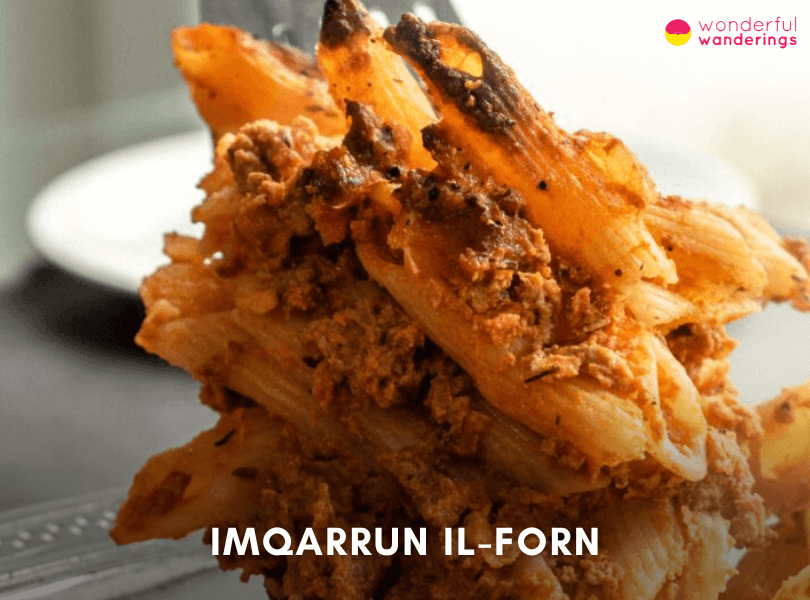
A few sauces that match imqarrun's deep, savory flavors are salsa verde, gremolata and skordalia garlic sauce. These punchy, herbal sauces cut through the rich dish. Drizzled over individual servings, they provide brightness. Imqarrun il-forn starts by browning meats like beef and pork with aromatics and then simmering in tomato sauce and seasonings. Tubular pasta is cooked before mixing everything together, adding eggs, baking and finishing with cheese on top until browned. This iconic Maltese comfort food brings people together over its simple, hearty flavors.
14. Helwa tat-Tork
Helwa tat-Tork, which translates to “Turk's Sweet”, is a Maltese confection made from sesame paste, sugar, eggs, vanilla and nuts like almonds or pistachios. It likely has its roots in Middle Eastern sweets and arrived in Malta during Arab rule. Helwa tat-tork is cut into small cubes or rectangles and served on tiny plates alongside Turkish coffee. Its crumbly, fudgy texture and sweet nutty flavor make it an ending to a meal. Some modern riffs mix cocoa powder or chocolate chips into the sesame halva base for extra decadence.
One excellent place in Valletta to sample quality helwa tat-tork is Nenu the Artisan Baker. Nenu's version is studded with whole roasted almonds and has a soft, sliceable texture balanced by just the right sweetness. The shop also sells other traditional Maltese sweets like honey rings, almond macaroons and nougat. Helwa tat-tork contains protein from the sesame paste and nuts. Using good quality tahini and less refined sugar would increase its nutritional value. Some updated versions incorporate dark chocolate or swap sugar for honey.
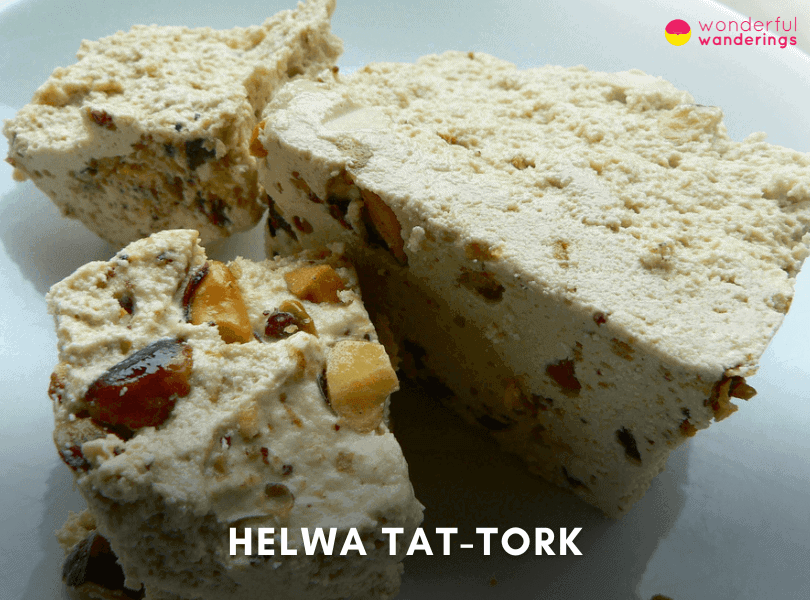
Common variations on helwa tat-tork include pistachio or hazelnut instead of almonds, mixing in cocoa powder, using honey as the sweetener and forming it into truffles or cupcakes for a modern twist. Making helwa tat-tork starts by boiling sugar syrup to soft ball stage. Separately, tahini is mixed with nuts and vanilla. The hot syrup gets poured over the tahini and rapidly stirred together until thickened then left to set up.
15. Ġbejniet
Ġbejniet (pronounced jeb-AY-nyet) are small, tangy cheeselets famous in Maltese cuisine. They are made by curdling sheep or goat's milk with rennet and ladling the curds into little reed baskets to drain, which gives them their distinctive basket-markings. Ġbejniet have a salty, lemony flavor reminiscent of feta or ricotta salata. They are served in a variety of forms – fresh (friski), sundried (moxxa), salt-cured (maħsula) or rolled in black peppercorns (tal-bżar). The way to eat ġbejniet in Malta is straight from the basket, still warm and milky. Locals also enjoy them grated over pasta or pizza, crumbled into salads and soups or paired with crackers and olives as an appetizer.
Gbejniet are packed with protein, calcium and good bacteria from the raw milk. Some chefs make modern riffs, like mixing in herbs, chili flakes or cocoa powder. But traditionalists insist simple salt-cured gbejniet show off the sweet, grassy flavors of the milk best.
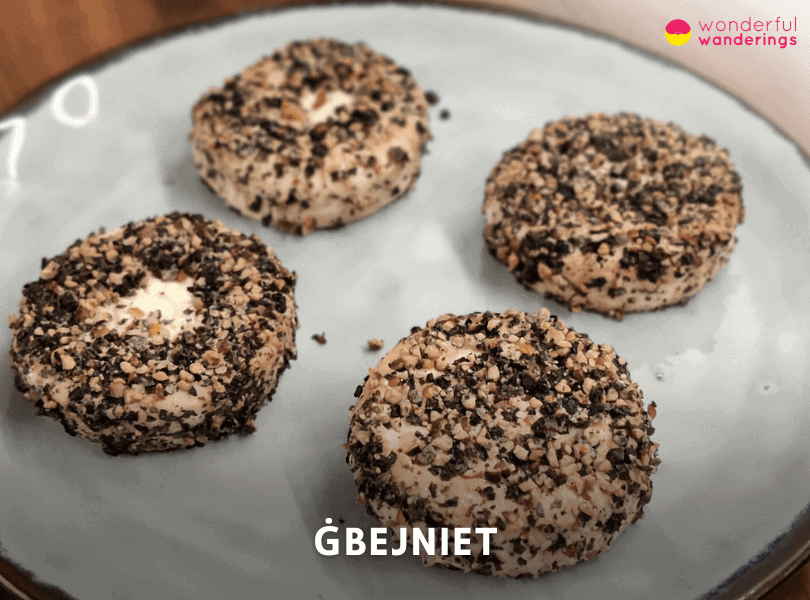
Salsa verde, gremolata and skordalia garlic sauce are some condiments that perfectly accent ġbejniet’s tang. Their herbal notes contrast the rich, salty cheese. Drizzled over a cheese board or individual portions, these sauces provide brightness. Making ġbejniet starts by warming milk and adding rennet to separate the curds, which get scooped into baskets to drain overnight. Then they are salted, dried and possibly cured or peppered before eating fresh or preserving in oil or vinegar. Requiring just a few ingredients and techniques passed down through generations, ġbejniet encapsulate the timeless, farm-to-table flavors of Malta.
16. Bigilla
Bigilla is a tangy, spicy bean dip that is ubiquitous in Maltese cuisine. It is made by mashing up dried fava or broad beans with olive oil, garlic, herbs like mint or marjoram, lemon juice and chili flakes for heat. Bigilla is served as a spread on crusty local Hobż bread, an accompaniment to cheese and cured meat platters or even mixed into pasta. It can be found in most cafes and restaurants across Malta. Excellent bigilla can be sampled at Nenu the Artisan Baker. Their version contains whole roasted almonds studded throughout the dip. The tanginess of the beans pairs with Nenu's housemade galletti crackers.
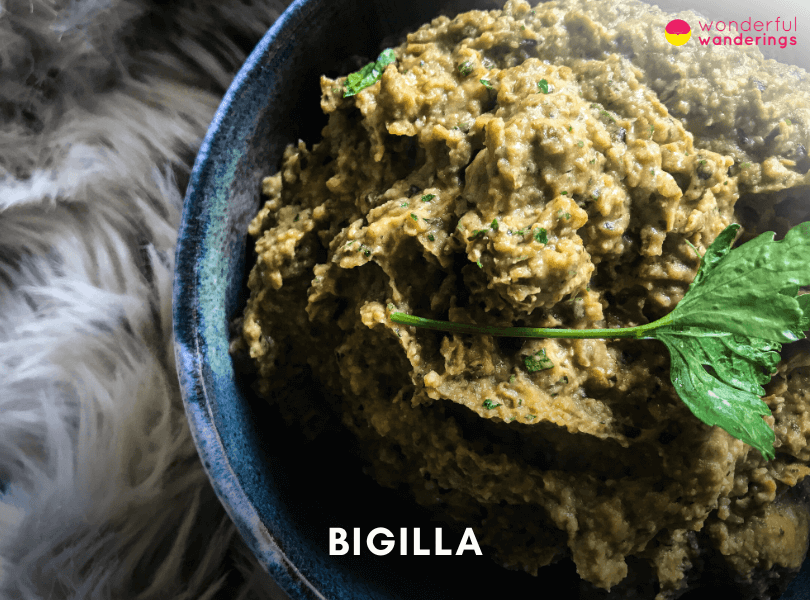
Bigilla provides protein and fiber from the beans. Using high quality extra virgin olive oil and less refined sea salt increases its health value. Some chefs make modern riffs, mixing in greens like spinach or sun-dried tomatoes. Making bigilla begins by soaking fava beans overnight before simmering into a mush. Then beans are mashed smooth with olive oil, garlic, lemon juice and herbs, allowing flavors to meld. Easy to prepare yet distinctly Maltese, humble bigilla encapsulates the fresh, garden flavors of this Mediterranean island.
17. Qargħa hamra
Qargħa hamra is the orange-fleshed pumpkins commonly grown and used in Maltese cooking. These pumpkins feature heavily in traditional dishes like minestra soup, pumpkin risotto, pumpkin pies (torta tal-qargħa ħamra) and even pumpkin tea cakes. The pumpkin's sweet, earthy flavor pairs wonderfully with Malta's fresh ingredients. Qargħa hamra often features in hearty soups or baked into savory pies (torta tal-qargħa ħamra).
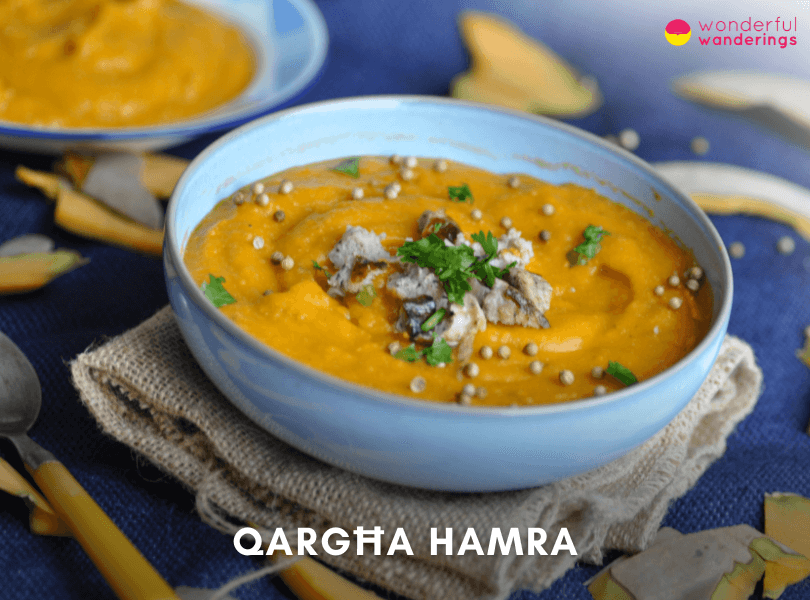
No special sauces are served with qargħa hamra, as dishes featuring this pumpkin tend to have bold flavors. Preparing qargħa hamra begins with roasting or boiling the pumpkin before incorporating into soups, risottos, pasta dishes and pies. Sugar and spices gently enhance its natural sweetness in desserts. Easy to grow in Malta's climate, the versatility of qargħa hamra makes it an iconic ingredient that graces the tables of locals and restaurants alike.
18. Kunserva
Kunserva is a sweet, thick, concentrated tomato paste that is famous in Maltese cuisine. It is made by slow-cooking ripe tomatoes for hours to reduce them down into a rich, sweet paste that keeps for months. Kunserva gets its distinctive sweet-tart flavor from the naturally sweet Maltese tomatoes used and the addition of sugar during the cooking process. Kunserva is served as a spread slathered on slices of crusty Maltese bread called hobz, topped with ingredients like olives, capers, onions or tuna to make hobz biz-zejt, a popular snack. It also frequently appears stirred into Maltese pasta sauces, stews like stuffat tal-fenek (rabbit stew) and soups for added richness and flavor.
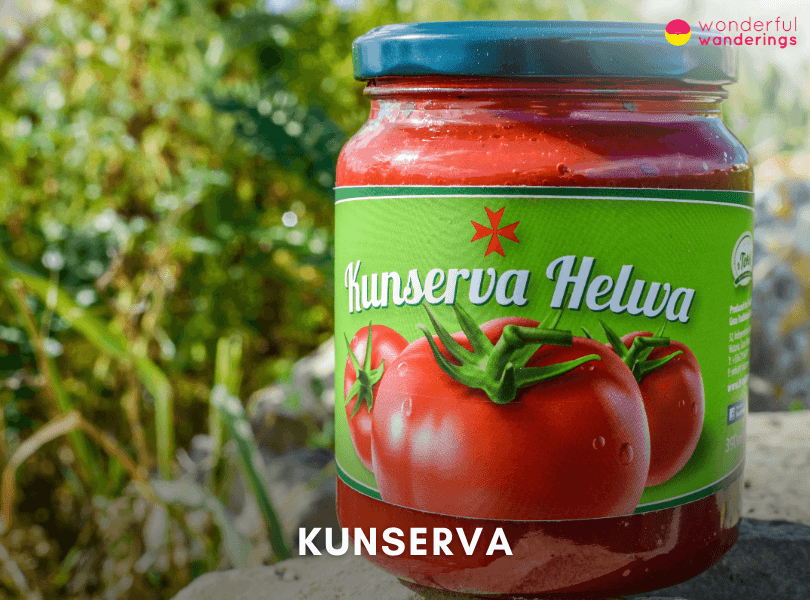
Kunserva provides beneficial lycopene, antioxidants and vitamins from the tomatoes. Using less refined sugar would increase its health value. Some chefs make modern, lighter versions using less sugar or mixing in greens, but traditionalists believe simple kunserva best showcases the sweet tomato flavor. There are no special sauces paired with kunserva, but the punchy herbal notes of salsa verde, gremolata or skordalia balance its sweetness wonderfully. Making kunserva begins by cooking chopped tomatoes with sugar and olive oil for hours until thickened to a paste. The paste is then canned or jarred for preservation. Easy to make at home, kunserva encapsulates the sweet, ripe tomato flavor of Malta in each jar.
19. Ftjal tat-tin mimli
Ftjal tat-tin mimli are small, crescent-shaped pastries stuffed with a sweet or savory filling. The name translates to “stuffed pastry pockets” in Maltese. These pastries likely originated from Arabic cuisine and feature in Maltese snacks and desserts. Common fillings include ricotta, chocolate, dates, spinach, ground meat, tuna or vegetables. Ftjal tat-tin mimli are served warm, straight from the oven. Sweet ricotta or chocolate-filled versions make an ideal snack with a cup of coffee.
Ftjal tat-tin mimli provide protein from cheese or meat fillings. Some vegetable-focused modern recipes add more greens to the filling. There are many possible variations on ftjal tat-tin mimli's fillings. Both sweet and savory versions exist. Common stuffings include ricotta, chocolate, spinach, ground meat, tuna, tomato sauce, olives, onions, nuts or roasted vegetables.
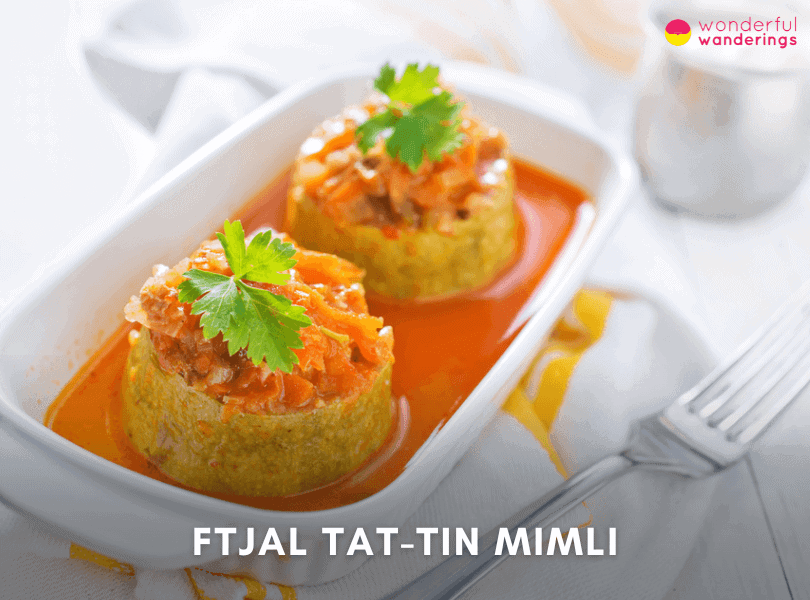
No special sauces are usually served with ftjal tat-tin mimli. Skordalia's pungent garlic also complements spinach or vegetable-stuffed pastries nicely. Making ftjal tat-tin mimli starts by preparing the filling, whether sweet or savory. The filling gets enclosed in a half-moon of dough that is sealed and baked until golden. These petite stuffed pastries encapsulate Malta's diverse culinary influences in one tasty, handheld bite.
Fenech is a Maltese vegetable stew often enjoyed by vegans and vegetarians. It contains a medley of seasonal vegetables like potatoes, carrots, kale and cauliflower cooked down in a rich tomato and wine sauce. Fenech exemplifies the traditional Maltese style of slow-cooked vegetable dishes, offering comforting flavors in an animal-product free preparation. Fenech is served warm, ladled over slices of crusty local Hobż bread to soak up the vegetable juices. The stew is quite healthy as the vegetables provide fiber, vitamins and minerals. Some modern riffs on the stew incorporate pasta shells, chickpeas or additional greens.
Excellent fenech can be found at the vegetarian restaurant Greens on St Ursula Street. Their version contains eggplant, zucchini, peppers and spinach in the chunky, herb-infused tomato sauce. Locals recommend pairing it with a robust Maltese red wine that can match the stew's depth of flavor. Some variations on fenech include using different vegetables depending on the season – artichokes, fava beans or mushrooms. The most “authentic” versions tend to stick to potatoes, tomatoes, carrots and cauliflower. No matter the exact vegetable medley, the slow-cooked tomato sauce and wine base tie it together.
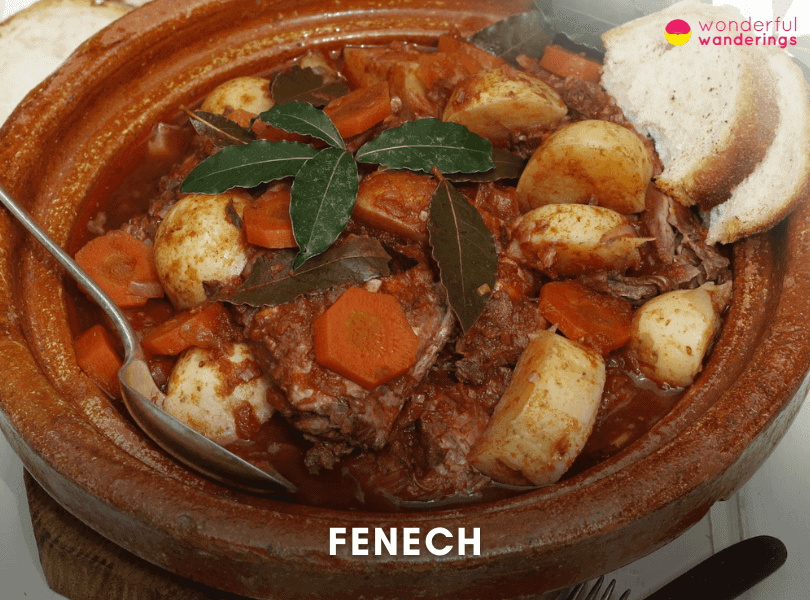
A few sauces that perfectly cut through fenech's richness are salsa verde, gremolata and skordalia garlic sauce. Their bright herbal notes provide acidity and brightness to balance the stew. Fenech begins by slowly cooking onions and garlic in olive oil before adding wine, tomatoes, vegetables and herbs. Simple to prepare at home yet distinctly Maltese in its ingredients, fenech encapsulates the fresh flavors of this Mediterranean island in one hearty stew.
What are the signature dishes of Malta that every visitor should try?
Listed below are the signature dishes of Malta that every visitor should try.
- Pastizzi. Pastizzi is a culinary dish, essential for every visitor. These small, savory pastries boast a flaky texture and are filled with ricotta cheese or mushy peas. Pastizzi has evolved into a symbol of Maltese culture, often paired with tea or coffee.
- Ġbejna. Ġbejna, a traditional Maltese cheese, is a must-try for anyone visiting Malta. Made from sheep's or goat's milk, this small, round cheese is versatile, served fresh, dried or peppered. The fresh variety offers a mild, creamy flavor, while the dried and peppered versions provide a more intense taste.
- Stuffat tal-Fenek. Malta's national dish, Stuffat tal-Fenek (rabbit stew), is a culinary experience visitors should not miss. This slow-cooked stew, infused with garlic, wine and herbs, highlights the tender, flavorful rabbit meat, a staple in Maltese cuisine.
- Hobz biz-zejt. Hobz biz-zejt, a traditional Maltese sandwich, is a simple yet flavorful dish every visitor should try. Made with crusty Maltese bread, this sandwich is typically filled with tomatoes, olives, capers and tuna, then drizzled with olive oil. Hobz biz-zejt represents Malta's use of fresh creating a light, nutritious meal that encapsulates the island's culinary ethos of simplicity and freshness.
- Timpana. Maltese culinary experience, visitors must try Timpana. This baked pasta dish, often made for special occasions, consists of macaroni, Bolognese sauce, eggs and cheese, encased in a crispy pastry. Timpana showcases Malta's fusion of Italian influences with local tastes, creating a hearty, comforting dish that epitomizes the Maltese love for pasta and baked goods and their skill in combining these elements into satisfying, flavorful meals.
What foods are a must-try for first-time visitors to Malta?
Listed below are the must-try foods for first-time visitors to Malta.
- Pastizzi. Malta's iconic snack, Pastizzi, is a must-try for first-time visitors. These flaky pastries, filled with ricotta or mushy peas, offer a delightful combination of a crunchy exterior and a soft, savory interior. Pastizzi is commonly enjoyed as a quick snack or a light meal, reflecting the island's culinary heritage and the locals' love for simple, flavorful food.
- Fenek (Rabbit Stew). Fenek, a traditional Maltese rabbit stew, represents a central part of Malta's culinary identity. The dish involves slow-cooking rabbit in wine, garlic and herbs, resulting in tender meat with a rich, aromatic sauce. This stew exemplifies the Maltese approach to cooking – making the most of local ingredients and infusing them with Mediterranean flavors.
- Ġbejniet. Ġbejniet, a type of Maltese cheese, is integral to the local gastronomy. Made from sheep or goat's milk, this small, round cheese can be found fresh, dried or peppered. It allows it to be used in various dishes, from simple snacks to elaborate meals, showcasing the Maltese people's resourcefulness and culinary creativity.
- Timpana. Timpana, a baked pasta dish, is a comfort food in Malta. It consists of macaroni, Bolognese sauce and a layer of pastry on top, baked until golden. This dish reflects the Italian influence on Maltese cuisine and offers a blend of pasta, meat and pastry, combining different textures and flavors in one dish.
- Lampuki Pie. Lampuki Pie, featuring the lampuki fish (also known as dorado or mahi-mahi), is a seasonal specialty in Malta. The pie, filled with spinach, olives and capers, encased in a crispy crust, captures the essence of Maltese cooking – the use of fresh, local seafood and the blending of various Mediterranean flavors.
What are the traditional desserts in Malta?
Listed below are the traditional desserts in Malta.
- Kannoli. Kannoli stands out as a traditional dessert. This sweet treat consists of fried pastry tubes filled with a creamy ricotta mixture, often enhanced with chocolate chips, candied peel or nuts. Kannoli has become a beloved part of Maltese confectionery, symbolizing the blend of Italian and Maltese culinary traditions.
- Imqaret. Imqaret, a date-filled pastry, is a famous Maltese dessert. These deep-fried pastries are made with a dough infused with aniseed and orange flower water, enveloping a sweet date filling. Often found at street vendors and local festivals, Imqaret is a testament to Malta's ability to create simple yet flavorful desserts.
- Helwa tat-Tork. Helwa tat-Tork, a dense, sweet confection, is deeply rooted in Malta's dessert culture. Made primarily from tahini (sesame paste), this dessert is often enriched with almonds, vanilla and sometimes chocolate, resulting in a rich, nutty flavor. Traditionally served during social gatherings and religious feasts, Helwa tat-Tork showcases the Maltese love for communal desserts.
- Qaghaq tal-Ghasel (Honey Rings). Qaghaq tal-Ghasel or honey rings, are a traditional Maltese dessert especially popular during the Christmas season. These sweet, ring-shaped pastries are filled with a treacle mixture that includes honey, orange peel and spices, offering a blend of sweetness and subtle spiciness.
- Figolli. Figolli are a staple Maltese dessert during the Easter season. These almond-filled pastries, shaped into symbolic figures like fish or hearts, celebrate spring and rebirth. The combination of a sweet pastry crust, a rich almond filling and a topping of icing or chocolate makes Figolli a delightful treat.
- Pudina tal-Hobz (Bread Pudding). Pudina tal-Hobz, a traditional Maltese bread pudding, is a testament to the island's resourcefulness in the kitchen. This dessert is made by repurposing stale bread, soaking it in milk and mixing it with raisins, cocoa and spices, creating a moist, dense pudding.
What are the best starters or snacks to eat in Malta?
Listed below are the best starters or snacks to eat in Malta.
- Pastizzi. Pastizzi are a known Maltese snack, perfect for those seeking to experience the island's traditional starters. These small, savory pastries are famous for their flaky texture and are filled with either ricotta cheese or mushy peas. They are commonly enjoyed with tea or coffee and are an ideal choice for visitors looking to indulge in authentic Maltese street food.
- Ġbejna. Ġbejna, a traditional Maltese cheese, is a must-try starter for anyone visiting Malta. Made from sheep or goat's milk, these small, round cheeses come in various forms, including fresh, dried or peppered. Each type offers a unique flavor, with the fresh variety being mild and creamy and the dried and peppered ones being more intense.
- Hobz biz-zejt. Hobz biz-zejt is a traditional Maltese sandwich and a perfect snack for visitors exploring Maltese cuisine. This dish is made with crusty Maltese bread, typically filled with tomatoes, olives, capers and tuna and then drizzled with olive oil. Hobz biz-zejt represents the Maltese use of fresh, Mediterranean ingredients, creating a light yet satisfying snack that reflects the island's culinary ethos of simplicity, freshness and local produce.
- Bigilla. Bigilla, a Maltese bean dip, is a flavorful starter and an integral part of Malta's snack culture. Made primarily from mashed broad beans, garlic and herbs, this dip is both hearty and aromatic. Often served with Maltese bread or crackers, Bigilla provides a taste of Malta's rustic culinary traditions.
- Qassatat. Qassatat are a popular Maltese snack, ideal for those seeking a taste of the island's traditional savory pastries. These small, circular pies are filled with ricotta, spinach or a mix of peas. The crust is soft and slightly crumbly, contrasting the creamy or savory filling.
- Timpana. Timpana is a Maltese dish, often served as a hearty snack or starter. This baked pasta dish consists of macaroni, Bolognese sauce, eggs and cheese, all encased in a crispy pastry. Timpana offers into Malta's fusion of Italian and local culinary influences, creating a dish that is both comforting and indulgent.
What are the best foods to eat for breakfast in Malta?
Listed below are the best foods to eat for breakfast in Malta.
- Hobz biz-Zejt. Hobz biz-Zejt is a top choice for breakfast traditions. This traditional Maltese sandwich is made with crusty Maltese bread, slathered with tomato paste and topped with ingredients like olives, capers, onions and tuna, then drizzled with olive oil.
- Pastizzi. Pastizzi are a beloved breakfast option in Malta, perfect for those seeking a quick, flavorful start to their day. These small, flaky pastries, filled with ricotta or mushy peas, are a staple in Maltese snack culture. Pastizzi have become synonymous with Maltese cuisine, providing a taste of the island's culinary heritage.
- Ftira. Ftira, a type of Maltese bread, is a popular breakfast food in Malta. This dense, sourdough bread is often cut open and filled with similar ingredients to Hobz biz-Zejt, like tuna, capers and olives. Ftira can be enjoyed as a sandwich or on its own, offering a unique taste and texture that sets it apart from other breads.
- Qaghaq tal-Ghasel. Qaghaq tal-Ghasel is a top choice in Malta. These ring-shaped, honey-filled pastries offer a delightful blend of sweetness and spice. Traditionally enjoyed during the Christmas season, they have become a year-round treat for many.
- Timpana. Timpana, a baked pasta dish, is a unique but popular breakfast choice in Malta. This dish offers a comforting start to the day, showcasing the Maltese love for combining Italian-inspired pasta dishes with local baking techniques.
- Ġbejna. Ġbejna, traditional Maltese cheese, is a common breakfast food in Malta. These small, round cheeses, made from sheep or goat's milk, are served fresh, dried or peppered. Ġbejna is often enjoyed with bread or crackers, offering a simple yet satisfying breakfast.
What are the best street foods in Malta?
Listed below are the best street foods in Malta.
- Pastizzi. Pastizzi is an best choice of street food for any visitor. These small, savory pastries boast a flaky, crispy crust, filled with either ricotta cheese or mushy peas. They are deeply embedded in Maltese culture, often served at cafes and street vendors across the island. Their popularity among locals and tourists makes them a symbol of Maltese gastronomy.
- Qassatat. Qassatat is a popular Maltese street food, similar to Pastizzi but with a thicker pastry crust. These small pies are filled with ricotta, spinach or a mix of peas, providing a heartier alternative to Pastizzi. They reflect the Maltese penchant for combining Mediterranean flavors in their traditional snacks.
- Hobz biz-zejt. Hobz biz-zejt, a traditional Maltese sandwich, is a known street food item. It consists of a crusty Maltese bread loaf or ftira, slathered with kunserva (a sweet tomato paste), topped with ingredients like olives, capers, onions and tuna and often seasoned with salt, pepper and a drizzle of olive oil. It's a testament to the island's rich culinary heritage, blending Mediterranean influences with its unique tastes.
- Timpana. Timpana, a baked pasta dish, is a unique Maltese street food often found in bakeries and stalls. It consists of macaroni in a rich tomato meat sauce, often mixed with eggs and cheese and encased in a crispy pastry shell. This dish is a prime example of Maltese comfort food, offering a delicious, filling meal that combines Italian-inspired pasta with the local penchant for baking.
- Ftira. Ftira is a distinctive Maltese bread, often served as street food with various fillings like tuna, olives, capers and tomatoes. It's a circular, semi-flat bread that's crusty on the outside and soft inside, often compared to ciabatta. They are commonly found at local snack bars and vendors, offering a versatile, portable meal option deeply rooted in Maltese culture.
- Lampuki Pie. Lampuki Pie, featuring the seasonal lampuki fish (dorado or mahi-mahi), is a traditional Maltese street food in autumn. This pie is made with a savory pastry crust filled with lampuki, spinach, olives and capers, offering a delicious blend of local seafood and Mediterranean flavors.. Lampuki Pie is a must-try for those seeking a genuine taste of Malta's culinary traditions.
What are the top vegan foods in Malta?
Listed below are the top vegan foods in Malta.
- Bigilla. Bigilla is a top choice, offering a taste of traditional Maltese flavors. This thick, flavorful dip is made from mashed broad beans, garlic and herbs. Bigilla is commonly served with Maltese bread or crackers and is a staple in Maltese cuisine.
- Hobz biz-Zejt. Hobz biz-Zejt, a traditional Maltese sandwich, can be easily adapted to a vegan diet. This dish consists of crusty Maltese bread, rubbed with ripe tomatoes and filled with ingredients like olives, capers and fresh herbs, then drizzled with olive oil.
- Kapunata. Kapunata is Malta's version of the classic Mediterranean ratatouille and is a fantastic vegan option. This dish is a savory blend of bell peppers, eggplant, capers, olives and tomatoes, often served cold or at room temperature. Kapunata is produce and the Mediterranean diet, showcasing the island's love for colorful, vegetable-based dishes that are both healthy and flavorful.
- Soppa tal-Armla. Soppa tal-Armla, also known as “widow's soup”, is a traditional Maltese soup that can be easily adapted for a vegan diet. The soup contains a variety of vegetables like carrots, peas and potatoes, along with a base of garlic and tomatoes. Soppa tal-Armla represents the Maltese culinary tradition of creating hearty, comforting soups, perfect for those looking to enjoy a warm, nourishing meal.
- Stuffed Artichokes. Stuffed artichokes are a vegan-friendly dish in Malta. The artichokes are typically stuffed with a mixture of breadcrumbs, garlic, herbs and sometimes capers or olives, then baked or stewed. This dish highlights the Maltese approach to cooking, where simple ingredients are transformed into flavorful, satisfying meals, reflecting the island's resourcefulness and the Mediterranean diet's emphasis on plant-based foods.
- Fenech. Fenech, a Maltese vegetable stew, is an excellent vegan option. Fenech exemplifies the traditional Maltese style of slow-cooked stews, offering a comforting, flavorsome meal deeply rooted in the island's culinary traditions. This dish demonstrates how Maltese cuisine can be simple and deeply satisfying, making it a must-try for vegan visitors.
What are the dining customs or etiquette in Malta?
There are three main dining customs or etiquette in Malta. Firstly, Maltese culture tends to be more relaxed and casual regarding punctuality and timekeeping, referred to as “island time”. If invited to dinner in someone's home, guests are still expected to arrive on time, as punctuality shows respect. Secondly, dinner is usually the largest meal with multiple courses. It often starts with soup, followed by a pasta or risotto dish, then meat or fish and finishing with fruit and desserts. Using utensils properly, keeping elbows off the table and waiting to be served rather than helping yourself are basic manners. Placing fork and knife parallel across plate indicates to have finished eating. Lastly, as a predominantly Catholic country, saying a prayer before meals is still commonly practiced, especially in family settings. Guests should remain silent and respectful during the blessing. Making the sign of the cross along with the family members shows engagement in the custom.
What local ingredients are commonly used in Malta?
Listed below are the local ingredients that are commonly used in Malta.
- Rabbit (Fenek). In Malta, rabbit, locally known as ‘fenek', is a staple ingredient and is central to traditional Maltese cuisine. The most famous dish using rabbit is ‘Stuffat tal-Fenek', a slow-cooked stew that highlights the meat's tender, flavorful nature. Rabbit farming in Malta dates back centuries, showcasing the island's agricultural heritage. This ingredient is a symbol of Maltese culinary identity, reflecting the island's history and cultural influences.
- Capers. Capers are a widely used local ingredient in Malta, known for their distinctive tangy and salty flavor. They are often used as a garnish or a key ingredient in various Maltese dishes, including salads, pasta and the traditional ‘Hobz biz-zejt'. Capers are pickled, which enhances their unique taste. The caper bush is commonly found in the Mediterranean region and its presence in Maltese cuisine highlights the island's use of fresh, locally sourced ingredients.
- Olive Oil. Olive oil is a fundamental ingredient in Maltese cuisine, reflecting the island's Mediterranean roots. Locally produced olive oil is prized for its quality and flavor, often used in cooking, dressings and dips. The use of olive oil in Maltese cooking not only adds a distinct flavor but also represents the health-conscious aspect of the Mediterranean diet.
- Maltese Sausage. Maltese sausage, known as ‘Zalzett tal-Malti', is a unique local ingredient characterized by its seasoning with coriander, garlic and parsley. These sausages are often consumed raw, air-dried or cooked in a variety of dishes. The sausage's flavor and aromatic spices showcase the Maltese approach to charcuterie, highlighting the blend of local and foreign influences over centuries.
- Ġbejniet. Ġbejniet is a traditional Maltese cheese made from sheep's or goat's milk. These small, round cheeses can be found fresh, dried or peppered and are often used in Maltese dishes, salads and as snacks. The versatility and distinct taste of Ġbejniet make it a beloved ingredient in Malta, reflecting the island's pastoral traditions and dairy production.
- Fresh Seafood. Malta, being an island nation, has a rich tradition of using fresh seafood in its cuisine. Common catches include lampuki (dorado), tuna and octopus, which are used in various traditional dishes like Lampuki Pie, grilled fish and seafood stews. The use of fresh, locally caught seafood is a testament to Malta's connection to the sea and its maritime heritage. This ingredient category is crucial in understanding the diversity and freshness of Maltese culinary offerings.
- Broad Beans (Ful). Broad beans or ‘ful' in Maltese, are a commonly used ingredient, especially in traditional dishes like ‘Bigilla', a bean paste. These beans are valued for their earthy flavor and nutritional benefits. They are often cooked in stews, soups or mashed into spreads. The cultivation and use of broad beans in Malta reflect the island's agricultural practices and the importance of legumes in the local diet.
How do the local spices and flavors differ from those in other regions?
Listed below are the reasons why local spices and flavors differ from those in other regions.
- Influence of Maritime Trade. Malta's position in the Mediterranean has historically made it a hub for maritime trade, significantly influencing its local spices and flavors. This crossroads position led to a fusion of tastes from Europe, North Africa and the Middle East. Unlike many other regions, Maltese cuisine includes spices like cumin, coriander and cinnamon, reflecting its historical interactions with various cultures. This blend of spices gives Maltese food a profile, combining the warmth of North African flavors with the subtlety of European cuisine. The result is a distinctive palette that stands out from its Mediterranean neighbors.
- Use of Fresh Local Produce. Malta's reliance on fresh, locally sourced produce differentiates its flavors from other regions. The island's fertile soil and favorable climate allow for cultivating various fresh herbs and vegetables, which are staples in Maltese cooking. Herbs like mint, basil and marjoram are more prominent in Maltese dishes compared to other Mediterranean cuisines. This emphasis on fresh, home-grown ingredients imparts a distinct freshness to Maltese dishes, setting them apart from the heavier use of dried or imported herbs in other regional cuisines.
- Historical Influence of Rulers. Malta's diverse history of rulers, including the Phoenicians, Romans, Moors, Knights of St. John, French and British, has left a lasting impact on its culinary palette, each ruling period introduced new spices and cooking techniques. This historical layering of culinary influences has made Maltese cuisine more complex and varied compared to other regions that experienced less cultural intermingling.
- Seafood Varieties and Preparation. The surrounding Mediterranean Sea provides Malta with a unique variety of seafood, influencing its local flavors. Maltese recipes often feature fish like lampuki (dorado), tuna and swordfish, prepared with local herbs and spices. The way Maltese cuisine incorporates seafood with local ingredients like capers, olives and tomatoes differs from other Mediterranean regions, where seafood might be prepared more simply with olive oil and lemon.
- Artisanal Cheese and Meat Products. Maltese cuisine is characterized by its artisanal cheese and meat products, such as Ġbejniet (small sheep or goat's milk cheeses) and Maltese sausage. These products are often seasoned with local herbs and spices, differentiating them from similar products in other regions. Ġbejniet, for example, can be found peppered, a feature less common in other Mediterranean cheeses.
Are there any traditional cooking methods in Malta?
Yes, Maltese cuisine has been influenced by the many cultures that have ruled the islands over the centuries, including Phoenician, Roman, Arab, Norman, Sicilian, French and British. One long-standing technique is slow cooking or braising meat and vegetables in a pot for hours over a fire or stove. The traditional Maltese rabbit stew called stuffat tal-fenek is prepared this way, simmering the rabbit with onions, tomatoes, wine, herbs and spices to create a flavorful dish that is considered the national dish of Malta. Slow cooking was necessary before modern kitchen appliances, but remains popular for intensifying flavors. Stewing fish in an herb-infused broth is also traditional in dishes like aljotta, a fish soup combining ingredients like tomatoes, garlic, chili peppers, parsley or mint, sometimes thickened with rice or bread. The flavors meld during long simmering times, creating hearty and comforting soups and stews. Baking is another pillar of Maltese cooking, seen in pastries like pastizzi, filled with ricotta or mushy peas and qassatat, shells of sweet pastry dough with a ricotta filling. Savory pies and timpana (baked macaroni) also employ traditional baking techniques. Locals often used communal wood-fired ovens to bake breads and dishes in centuries past.
Are there any regional variations in Maltese cuisine?
Yes, Maltese cuisine have variations primarily influenced by the geographical and historical factors unique to certain areas, particularly between the main island of Malta and its sister island, Gozo. In Gozo, the cuisine tends to incorporate more rustic, hearty flavors, reflecting the island's agricultural heritage and slower pace of life. Dishes like Gozitan cheese (Ġbejna tal-Għawdex) are a prime example. Gozitan cuisine also makes extensive use of sourced ingredients, such as honey and olive oil, which are characterized by their unique flavors influenced by the island's particular terroir. In Malta, the influence of foreign rule throughout history, notably by the Knights of St. John, the French and the British, has led to a more diverse culinary scene. This is evident in the variety of pasta dishes, a legacy of Italian influence and the popularity of British-influenced foods like pies and fish and chips. The main island also shows a greater incorporation of international ingredients and cooking styles, reflecting its role as a cultural and commercial hub.
What are the best Maltese dish recipes to cook yourself?
There are three best Maltese dish recipes to cook oneself. Firstly, Stuffat Tal-Fenek is a classic Maltese dish, known for its rich flavor and tender rabbit meat. To cook this dish, marinate the rabbit pieces in red wine, garlic and bay leaves overnight. The next day, brown the rabbit in a large pot, then remove and set aside. In the same pot, sauté chopped onions, carrots and garlic until softened. Return the rabbit to the pot, add the wine marinade and enough water to cover the meat. Include chopped tomatoes, peas and potatoes, seasoning with salt, pepper and a pinch of sugar to balance the acidity. Simmer for about an hour, until the rabbit is tender and the sauce thickens. This stew is often served with Maltese bread or pasta, offering a hearty and traditional Maltese meal. It showcases the Maltese way of using local ingredients and slow cooking methods to develop deep, robust flavors. Secondly, Timpana, a baked pasta dish, is a Maltese favorite, combining pasta with a rich meat sauce and a pastry crust. Begin by preparing a Bolognese sauce with ground beef, onions, garlic, tomatoes and herbs. Cook macaroni pasta until al dente, then mix it with the meat sauce and beaten eggs, which help bind the mixture. Line a baking dish with puff pastry, fill it with the pasta mixture and cover with another layer of pastry. Brush the top with egg wash for a golden finish. Bake in a preheated oven at 180°C (356°F) for about 45 minutes, until the pastry is crisp and golden. This indulgent dish is a testament to Italian influences in Maltese cuisine, offering a unique and delicious combination of pasta and pastry. Lastly, Hobz biz-Zejt is a simple yet flavorful Maltese snack. Start with a crusty loaf of Maltese bread or ciabatta. Cut it open and rub the inside with ripe tomatoes or spread with tomato paste. Drizzle with good quality olive oil. Add slices of onions, capers, olives and canned tuna. For extra flavor, include some anchovies, fresh basil or mint. Season with salt and pepper. This dish can be customized with additional ingredients like sun-dried tomatoes or hard-boiled eggs. Hobz biz-Zejt is a perfect example of how Maltese cuisine combines fresh, Mediterranean ingredients to create dishes that are both easy to prepare and delicious.
Are there any traditional drinks that complement the local food in Malta?
Listed below are the traditional drinks that complement the local food in Malta.
- Kinnie. Kinnie is a traditional Maltese soft drink that complements the local cuisine. This bittersweet beverage is made from a blend of oranges and aromatic herbs, creating a taste unlike any other soft drink. Introduced in the 1950s, it has become a beloved national beverage, embodying the Maltese knack for creating distinctive, flavorful drinks that reflect the island's culinary landscape.
- Ċisk Lager. Ċisk Lager, Malta's award-winning beer, is a popular accompaniment to many Maltese dishes. It is known for its light, crisp taste and golden color, Ċisk perfectly balances the rich, savory flavors of Maltese food This lager is not just a beer, it's a part of Malta's social fabric, enjoyed in cafes and bars across the island.
- Maltese Wine. Maltese wine, though less known internationally, is an excellent companion to the island's cuisine. These wines, ranging from light and crisp whites to full-bodied reds, pair with the diverse flavors of Maltese food. The local wine industry, while small, reflects Malta's long history of winemaking and its ability to produce high-quality wines that capture the essence of the Mediterranean terroir.
- Liqueur tal-Bajtra. Liqueur tal-Bajtra, a traditional Maltese liqueur, is made from the prickly pear cactus fruit, which is native to the island. This sweet liqueur has a flavor reminiscent of the fruit's subtle, melon-like taste. Often served as an after-dinner drink, it complements the richness of Maltese desserts and pastries. Liqueur tal-Bajtra not only offers a taste of Malta's indigenous flora but also showcases the Maltese talent for crafting distinctive, locally inspired spirits.
- Imbuljuta tal-Qastan. Imbuljuta tal-Qastan, a traditional Maltese drink, is particularly popular during the Christmas season. This warm, spiced beverage is made from chestnuts, cocoa, cloves and citrus zest, creating a comforting, aromatic concoction. Imbuljuta tal-Qastan reflects the island's seasonal culinary traditions and the Maltese love for rich, flavorful drinks that bring warmth and cheer.
- Lemon Cello. Lemon Cello has found a special place in Malta's beverage scene. This zesty, lemon-flavored liqueur is enjoyed as a digestive and is known for its sweet, tart flavor. It pairs well with Maltese seafood dishes and lighter fare, offering a refreshing, citrusy contrast to the flavors of the food.
- Tea with Milk (Te fit-Tazza). Tea with milk or Te fit-Tazza, is a simple yet beloved beverage in Malta, often enjoyed alongside snacks or light meals. This British-influenced drink is a part of Malta's colonial legacy and has become a staple in Maltese households. Te fit-Tazza represents the blend of British and Mediterranean influences in Maltese culture and cuisine, offering a familiar yet distinctly Maltese tea experience.
What are the best restaurants to eat in Valletta as a visitor?
Listed below are the best restaurants to eat in Valletta as a visitor.
- Risette. Risette is a notable dining destination in Malta, located at Casa Ellul, 81, Old Theatre Street, Valletta. This informal fine dining restaurant is set within the elegant Casa Ellul, in the heart of Valletta. Led by Chef Steve Scicluna, who has experience working in Michelin star restaurants, Risette offers a unique culinary experience. The menu, which changes weekly, is a creative blend of French cuisine with Japanese technicalities and ingredients, reflecting Chef Scicluna’s passion for flavors. The restaurant emphasizes using the freshest produce, ensuring each dish is a culinary delight. Set under the iconic Lady of Mount Carmel Church, Risette promises not just a meal but a wholesome dining experience.
- Bahia. Bahia is a known restaurant at Corinthia Palace Hotel, De Paule Avenue, San Anton, Balzan, Malta. This restaurant is named after a prestigious navel orange and is known for its innovative and creative cuisine. After five years in Lija, Bahia moved to the Corinthia Palace Hotel, built in the early 1900s. The restaurant's design is inspired by the four stages of growth of an orange tree. Seed, Growth, Blossom and Harvest, each represented in different sections of the restaurant. Bahia offers a comfortable and contemporary space, both indoors and outdoors. The menu features a seasonal à la carte selection and tasting menus, catering to various dietary preferences, including plant-based options.
- The Fork and Cork. The Fork and Cork is a fine dining restaurant at 20, Telgha Tas-Saqqajja, Rabat, Malta. It offers a unique dining experience, characterized by a cozy interior and a relaxing atmosphere. Dishes are prepared daily using the freshest ingredients. The restaurant is known for its personable Chef Patron Carl Zahra, who remains loyal to Rabat’s prime culinary destination. The restaurant offers a surprise tasting menu that champions local ingredients, including dishes like glazed beef brisket with cauliflower, porcini mushroom pickled rutabaga carpaccio and a lamb rump served with white bean cassoulet, kalamata olives and harissa jus. The restaurant also features an extensive wine list, expertly paired with the dishes.
- Tal-Petut Restaurant. Tal-Petut Restaurant in Birgu, Malta, offers a unique dining experience with a focus on local dishes with a creative twist. It provides a private dining concept, where patrons can discuss and decide on a customized menu with the cook patron, Donald Caligari Conti and his team. This approach gives a personalized touch to celebrations or reservations. The restaurant caters to a range of events, including weddings, engagements, baptisms and other functions. Tal-Petut is known for its exceptional service and mouthwatering food, with vegetarian, vegan and gluten-free options. The restaurant operates Monday to Saturday for dinner and Sunday for lunch by reservation.
What are the best food tours in Valletta?
Four of the best food tours in Malta are Valletta Street Food tour, Valletta Food Tour, Malta Highlights Food Tour or Offbeat Malta Food Trails. Firstly, the Valletta Street Food and Culture Walking Tour is a top choice. This 3-hour tour takes through the sights and flavors of Malta's capital, with stops to sample local dishes like ftira sandwiches, pastizzi and traditional desserts. Secondly, the Valletta Food Tour offered by City Walking Tours Malta is excellent. On this walking tour, visitors can taste delicacies from bakeries, restaurants and food stalls while exploring Valletta's main landmarks and hidden back streets. Thirdly, consider the Malta Highlights Food Tour from City Walking Tours Malta. This 8-hour private tour with a guide and vehicle takes you to Valletta, Mdina and Marsaxlokk. Visitors can sample local foods and learn about Maltese culture, history and traditions along the way. Lastly, Offbeat Malta Food Trails gets exceptional reviews for its passionately guided walking tours of Valletta. The 3-hour tour features family-run eateries and artisanal producers. These top-rated walking and private tours offer delicious local flavors and an authentic cultural experience.
What are the most unique facts about Malta and Valletta?
There are four most unique facts about Malta and Valletta. Firstly, Valletta, the capital city of Malta, holds the distinction of being one of the smallest national capitals in Europe. This small size belies its rich history and cultural density, offering a unique blend of experiences within a confined space. Secondly, Valletta's origin dates back to the 16th-century, founded in 1566 by the Order of St. John as a refuge for soldiers returning from the Crusades. This historical context is visible in its architecture and urban planning. The city was named after its founder, Grand Master Jean Parisot de la Valette and was the first planned city in Europe, with a grid-like street system that was revolutionary for its time. Thirdly, the city is a UNESCO World Heritage Site, recognized for its historical and cultural significance. Its architecture is a mix of Baroque, Mannerist and Modern styles, reflecting various periods of its history. Key landmarks include St. John's Co-Cathedral, an example of high Baroque architecture and the Grandmaster's Palace, the seat of the Maltese government. Lastly, Valletta has been a location for several films and TV shows, thanks to its authentic and well-preserved historical setting. Its streets and buildings have featured in productions like ‘Gladiator,' ‘Troy,' and the famous TV series ‘Game of Thrones,' showcasing its versatility and appeal as a filming location.
What are the most fun things to do in Malta?
Listed below are the most fun things to do in Malta .
- Exploring Valletta. One of the most fun activities in Malta is exploring Valletta, the capital city, a UNESCO World Heritage Site. Valletta is known for its historical and architectural richness, including the St. John's Co-Cathedral and the Grandmaster's Palace. Visitors can admire the mix of medieval and baroque architecture, visit numerous museums and enjoy the cafes and shops. The city also offers views of the harbor and a cultural scene with frequent festivals and events.
- Visiting the Blue Lagoon. A trip to the Blue Lagoon on Comino Island is a fun and unforgettable experience in Malta. This natural lagoon features crystal-clear, azure waters and is perfect for swimming, snorkeling and diving. The cliffs and caves provide a backdrop and opportunities for exploration. The Blue Lagoon is a small paradise, offering an escape from the busy main islands and a chance to indulge in the island's natural beauty.
- Touring the Megalithic Temples. Exploring Malta's Megalithic Temples is a fascinating activity for history and archaeology enthusiasts. These UNESCO World Heritage Sites, including Ħaġar Qim and Mnajdra, are among the oldest free-standing structures in the world. Touring these ancient temples offers insight into the island's prehistoric past and the mysterious civilization that built them
- Enjoying Traditional Maltese Nights. Participating in a Traditional Maltese Night is a fun way to experience Malta's culture. These events, often held in village squares or local restaurants, include folk music, dancing and traditional Maltese cuisine. Visitors can enjoy themselves in the island's customs and traditions, enjoying the atmosphere and warm hospitality.
- Diving in Malta's Waters. Diving in Malta offers an exciting adventure, with the island famous for its excellent diving spots. The clear Mediterranean waters provide high visibility, revealing a rich world of reefs, caves and wrecks. Dive sites like the Blue Hole and the Santa Maria Caves cater to divers of all levels, offering a chance to explore Malta's diverse marine life and underwater landscapes.
What is the best time to visit Malta and Valetta?
The best time to visit Malta and its capital, Valletta, is during the late spring and early autumn months, specifically from April to June and September to October. During these periods, the weather in Malta is ideally warm and pleasant, with average temperatures ranging from 17℃ to 25℃ (63℉ to 77℉) in the spring and slightly warmer in the early autumn. This climate is perfect for exploring Valletta's rich historical sites, such as the St. John's Co-Cathedral and the Grandmaster's Palace, without the discomfort of the intense summer heat. Early autumn is equally appealing, as the summer crowds diminish, offering a more relaxed atmosphere. The sea remains warm, ideal for swimming and diving, with temperatures around 23℃ (73℉). This season also hosts notable events like the Notte Bianca in Valletta, a night-long celebration of arts and culture, providing a vibrant experience of local life.
Are there any food festivals in Malta?
Yes, there are several food festivals in Malta . Firstly, the Malta International Food Festival is the largest food event on the islands, spanning 7 days in July and attracting over 50,000 visitors. Held in Valletta's Pjazza Tritoni, it celebrates cuisine from over 42 countries with over 1,000 dishes to taste. Visitors purchase tokens to sample global flavors from food trucks and vendors while enjoying live entertainment. Secondly, the Valletta Local Food Festival takes place each October at the Valletta Design Cluster. It showcases the diversity of Maltese cuisine through tasting stations of traditional foods like pastizzi, kwareżimal pasta and ftira sandwiches. Cooking demonstrations and talks provide a cultural immersion into local culinary traditions. Thirdly, the Qormi Bread Festival held each September highlights Malta's most iconic baked good – crusty, freshly baked bread. Bakers use traditional wood ovens to demonstrate breadmaking techniques. Attendees can sample a variety of breads and other baked goods that are a dietary staple. Lastly, Ħamrun's Chocolate Festival is a sweet celebration of all things chocolate held each May. Professional chocolate sculpting demonstrations and tempting chocolate-based treats like cannoli and nougat delight attendees.
Who are the best Maltese chefs?
Listed below are the best Maltese chefs .
- Robert Cassar. Robert Cassar is considered one of Malta's top chefs and a leading figure on the island's culinary scene. He is the chef-patron of the acclaimed restaurant Root 81 in Rabat which has earned praise locally and abroad. Cassar's style combines modern techniques with the best of Maltese traditions and seasonal ingredients. His innovative dishes have garnered him Malta's Chef of the Year award in 2019. Cassar is admired for his constant strive for perfection and ability to balance complex flavors.
- Marvin Gauci. Marvin Gauci has made a name for himself as one of Malta's celebrity chefs with his restaurants popular among locals and tourists alike. He is the talented chef behind four successful eateries on the island focusing on different cuisines from Italian to Thai. Gauci has introduced contemporary dining concepts like pop-up restaurants and private chef table experiences. His flagship restaurant Tarragon has won multiple awards and he was runner-up for Malta's Chef of the Year in 2019. Marvin Gauci is admired for his versatility in various cooking styles and continuously raising the bar of Malta's dining scene.
- Walter Atzori. Walter Atzori is the head chef of Il-Kartell, a top-rated restaurant in Gozo incorporating creative Mediterranean cuisine with Maltese influences. He has over 15 years of culinary experience, including international work. Atzori is known for presented, seasonal dishes that celebrate the freshness of local ingredients. Walter Atzori has a reputation for delivering exceptional dining experiences through his combination of technical skills and passion for food.
- Janine Camilleri. Janine Camilleri is the talented head chef at L'Artiglio, one of Malta's fine dining gems in Valletta's historic center. Her style focuses on modern French cuisine prepared with precision and artistry. Camilleri's dishes feature quality ingredients she selects from trusted suppliers and local producers. Janine Camilleri represents a new generation of female chefs in Malta at the helm of top kitchens serving sophisticated, contemporary cuisine.
- Michael Debono. Michael Debono is an acclaimed Maltese chef who has worked in leading hotel and resort kitchens both locally including the Hilton Malta and internationally like Shangri-La Dubai. He specializes in Mediterranean and Middle Eastern cuisine with a flair for creative flavors and visual appeal. Debono recently opened his restaurant B14 in Mellieha, showcasing his signature modern style coupled with the freshest seasonal ingredients.
How do the country's geographic and climatic conditions influence Maltese cuisine?
Malta's climate and geography define the crops grown, preservation techniques used, architecture supporting food preparation and the ultimate flavors of its cuisine. Firstly, Malta's mild Mediterranean climate with hot, dry summers and short, cool winters allows for extensive cultivation of fruits, vegetables and herbs that define much of its cuisine. Ingredients like tomatoes, eggplants, zucchini, olives, grapes, prickly pears, oranges, lemons, wild thyme and mint all thrive. Secondly, Malta's islands have very thin, rocky topsoil and limited fresh water supplies, necessitating special growing techniques to maximize crop yields. Farmers often build stone walls to create terraces that prevent soil erosion and capture rainwater runoff. Thirdly, Malta's dry climate lends itself perfectly to traditional preservation methods that concentrate flavors for later use. Sun-dried tomatoes, vegetables, figs and grapes intensify taste. Olives and capers are cured in sea salt or vinegar. Cheeses like ġbejniet keep longer in the heat. Lastly, the hot climate influenced architecture and communal ovens play a role in Maltese cuisine. Most village homes lack kitchens, so large dishes were often walked to a local bakery to cook slowly in wood-fired ovens overnight. Baking breads, stews like stuffat tal-fenek or timpana pasta bakes works well with this arrangement. The oven's consistent heat and stone walls distribute temperature evenly for delicious dishes.
How do seasonal changes affect the availability and variety of dishes in Malta?
There are several factors affect the availability and variety of dishes in Malta. Firstly, Malta's mild climate allows cultivating fruits, vegetables and herbs most of the year. Some crops like tomatoes, eggplants, zucchini, chili peppers, sweet corn, peas and asparagus thrive during spring and summer months. In autumn and winter, locally grown produce includes artichokes, cauliflower, spinach, leeks, olives, fennel, broccoli, endives and citrus fruits.
Secondly, seasonal availability directly impacts ingredients used in Maltese cuisine. Spring and summer provide bountiful produce enjoyed fresh or preserved by sun-drying, pickling or turning into jams to use year-round. Hearty winter stews and soups utilize preserved tomatoes, vegetables, figs and grapes. Seasonal seafood like lampuki is celebrated as a delicacy when abundant in autumn. Thirdly, festivals and religious traditions feature dishes connected to seasons and harvests. Easter's symbolic foods include roast lamb and seasonal first fruits. Christmas desserts highlight winter citrus, nuts and dried fruits. Village feasts celebrate patron saints with special harvest breads and seasonal sweets in summer and autumn. Lastly, restaurants adapt menus to highlight seasonal ingredients and local specialties. Tourists flock to seaside eateries for fresh lampuki in autumn. Bakeries tempt with hot cross buns during Lent or fig cakes in winter. Food tours and markets offer tastes that capture a season's essence, from new olive oils to sun-ripened produce.
PIN FOR LATER
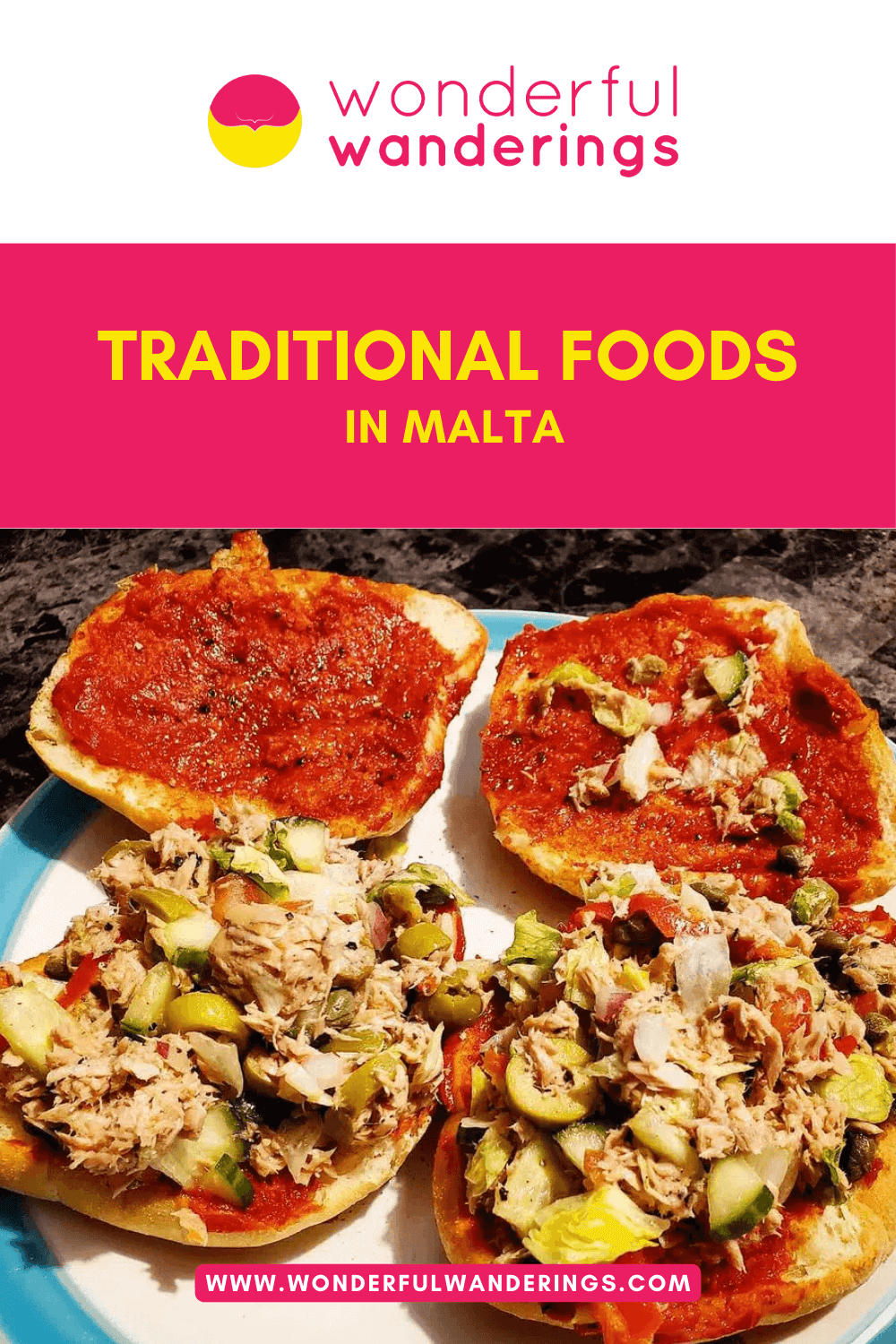
Find below the best Malta guides from WonderfulWanderings.

18 Top Festivals to Attend in Malta for 2024

Driving in Malta: Road Safety, Driving Etiquette and How to Rent a Car

Dates of Holidays in Malta 2024 [Annually updated]

Renting a car in Malta: 34 important tips (2024)

14 Best Beaches to Visit in Malta

Transportation Guide in Malta: Which One Is Best for You?

24 Interesting Facts about Malta

12 Best Castles to Visit in Malta

Prices in Malta: Is Malta expensive?

31 Most Famous Maltese people: Artists, Chefs and Scientists!

16 Amazing Places to Visit in Malta all year round!

21 Amazing Things to do in Malta, Museums and History

Malta Travel Guide
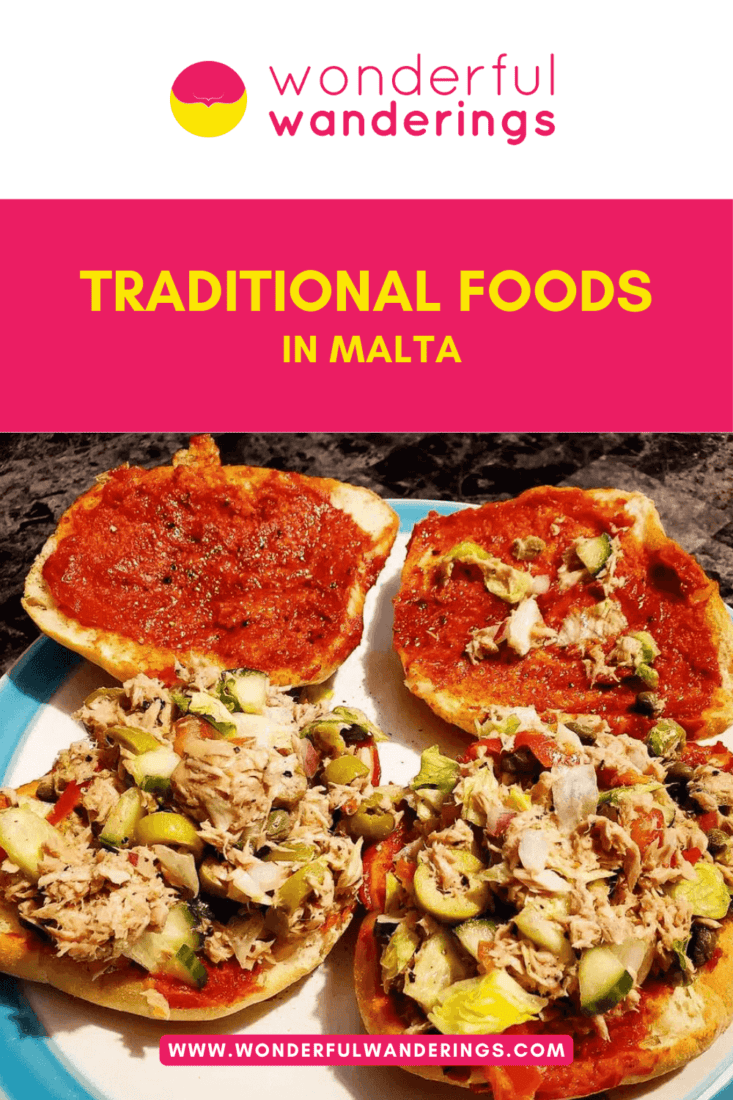
The editorial team at Wonderful Wanderings brings together travel experts with backgrounds in travel writing, web development and digital marketing. The team, through their collaborative effort, provides readers with relevant travel experiences and up-to-date digital content. The vast expertise within the team ensures an informative blend of travel stories and useful online travel guides and trip experiences, built on a foundation of both industry recognition and hands-on global adventures. Learn more about Wonderful Wanderings
Your email address will not be published. Required fields are marked *
Join 58,000+ other Wonderful Wanderers!
As an Amazon Associate I earn from qualifying purchases.

13 x Traditional Maltese Food You Should Definitely Try
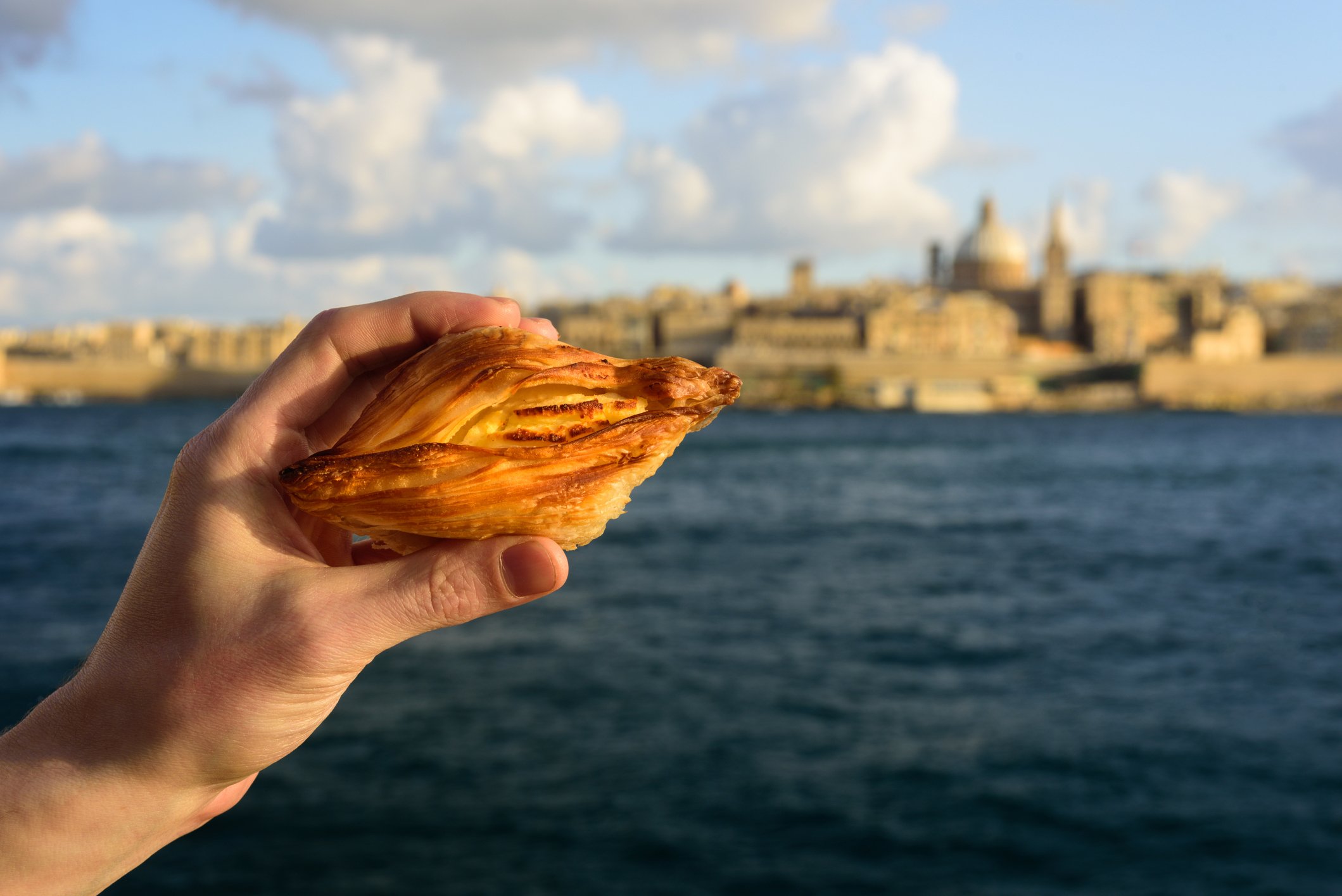
Let’s face it, one of the main highlights of travelling is tasting authentic local food. Whether it is the favorite go-to street food or the traditional dish which narrates the history and culture, tasting and trying out the food completes your trip.
And just like any island destination, a holiday in Malta is not complete without having a bite on their scrumptious and tasty meals. So as you pack your bags for your Malta journey, make sure you allocate a decent portion of your budget to food. Here are the foods that you need to try when visiting Malta.
1. Stuffat Tal-Fenek (Rabbit stew)
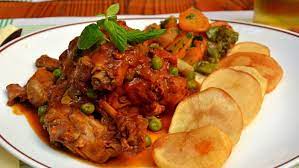
The first thing that you must tick off of your food list is Malta’s national food. This savoury dish made out of rabbit meat is best served after simmering it for an hour and a half. It is served in a thick, hearty sauce made out of liver and kidney (politely check whether they are using liver & kidney in the dish, if you don’t like it), with a splash of red wine, and filled with vegetables, potatoes, and tomatoes.
There may be many renditions of this dish, with families from long ago adding a twist or a secret ingredient or two to make it their own. But Stuffat Tal-Fenek has been a staple among the locals, and it has been a must-try for those visiting Malta for the first time.
Be a bit daring and try out this traditional Maltese dish.
2. Pastizzi (traditional savoury pastry)
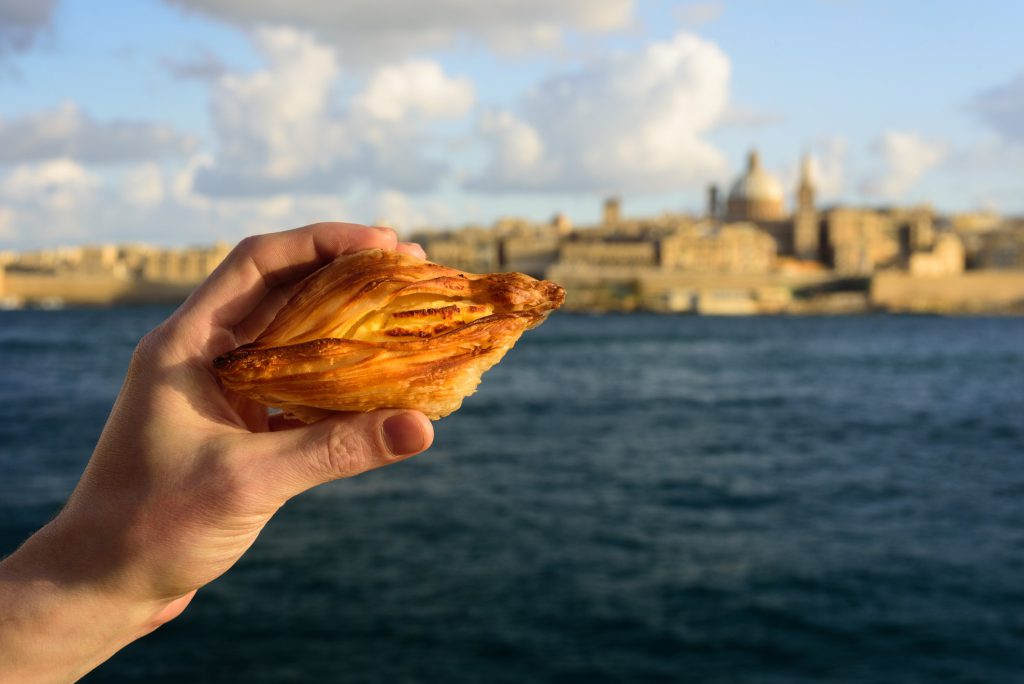
Light, cheesy, and delicious, the pastizzi is a favourite snack among Maltese. It is a local delicacy made out of glistening gold puff pastry and stuffed with ricotta cheese or mushed peas . Other versions of pastizzi are stuffed with onions and anchovies. Whichever your choice, it will easily be your favourite Maltese snack.
Since everyone loves it, the pastizzi is readily available to almost anywhere in Malta. But if you want to taste the best, the locals profess that the best pastizzi they have ever tasted come from Is-Serkin Crystal Palace Bar in Rabat. So grab a bite or two of pastizzi as you rummage through the cities of Malta.
3. Ħobż biż-żejt (open sandwich)
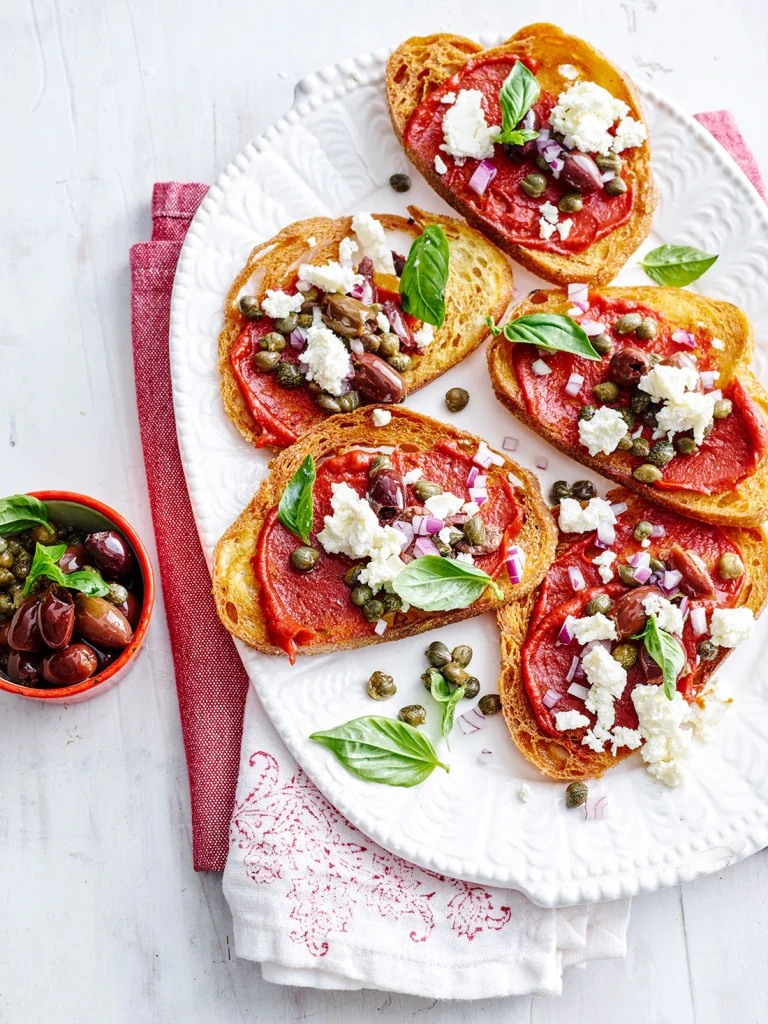
Want to enjoy the real taste of Mediterranean pastries? This crusty sourdough bread is topped with their local tomatoes and drizzled with some olive oil is a delectable treat. Literally, the word actually means ‘bread with oil’… Similar to the tomato bruschetta, this Maltese “open-faced sandwich” can also be enjoyed by a variety of toppings. Whether it is anchovies, tuna, sheep cheese, the Hobz biz-zejt will surely be a delight to munch on.
4. Lampuki (seafood)
Nota bene: when in Malta, do not miss out on the seafood. As the island is surrounded by the beautiful Mediterranean Sea, you can expect that Malta can only offer the freshest catch of the day. Lampuki, which is also known as dorado, has long been a staple dish in Malta. There are many innovative ways to cook Lampuki, but one of the most traditional cooking methods is to pan-sear it, living the sides a little blackened for some kick. Another favourite is to make the fish a pie filling.
Whichever way it is prepared, Lampuki dishes are something you definitely do not want to miss. Head down south to take a bite on this delicious traditional Maltese fish.
5. Kwareżimal (traditional Maltese biscuit)
Since almonds are one of the favourites of Maltese, you should take a bite of Kwarezimal. This traditional spongy cake made of orange rind and topped with almonds. It is a hit during the lent season. The traditional Kwarezimal is also vegan as it does not contain dairy or animal protein. So with that, this almond cake is an excellent food for anyone who is fasting during the lent.
Aside from Kwarezimal, there are also other tasty desserts that make use of almonds. Among these is the Biskuttini Tal-Lewz, or traditional almond cookies. These cookies are usually baked and served during the Christmas holidays or Easter, or just plain afternoon tea.
6. Bebbux (edible land snails)
What is a memorable trip without trying out exotic food? Although some cultures, like southern Europe, eat land snails, it may be a new thing for you to try. The snails re first cleansed by fasting. Home cooks usually cook these land snails by boiling it in salted water before tossing in tomatoes, garlic, and a variety of spices.
Bebbux is commonly served as an appetizer in most Maltese restaurants. You can also expect modern renditions on the Bebbux by using red or white wine. If you can take the daring in you a notch higher, there are other restaurants that offer snail dishes. The Bebbux il-Aljoli is a dish where the snail is smothered in aljoli sauce, which is primarily made out of day-old bread and biscuits.
7. Bragioli (Beef olives)
If you prefer hearty, thick, and rustic beef stews, the Bragioli is the Maltese take. And while it is also called as “beef olives,” there are no olives in the recipe. It is only called like that because Bragioli is prepared by stuffing the beef and somewhat resembling the shape of an olive. Nevertheless, despite the absence of olives in the ingredients, Bragioli is still a mouthwatering and delectable dish. The beef is served tender, thanks for at least two hours of being simmered in wine. The viand is best paired with mashed potatoes and pea.
For those who want to taste Bragioli or beef olives, many restaurants serve the beef stew dish. Cafe Jubilee in Valletta serves a traditionally cooked Bragioli. With its cosy atmosphere, you are sure to enjoy that food trip.
8. Imqaret (traditional Maltese sweets)
Those who have a sweet tooth must try Imqaret, a golden pastry stuffed with sweet fillings. These diamond-shaped pastries are also among the favourites of the locals, and with that, it is a guarantee that you will delight in it as well. Whether you like to try out the original with powdered sugar or with ice cream on top of it, Imqaret is sure to blow your tastebuds away. These Imqaret are readily available anywhere in Malta. If you are looking for a recommendation, you should try out Imqaret served at L’aroma at Tas-Sliema.
9. Gozitan Ftira (traditional flatbread)
If you are a big foodie, then obviously, pizza is a go-to for you. And if you are not much on the daring side and want to eat something familiar, then Gozitan Ftira is the traditional Maltese dish for you. Although somewhat similar to the pizza or the beautiful mosaic-esque focaccia, Gozitan Ftira uses bread dough instead of the pizza dough. Topped with anchovies, tuna, tomatoes, onions, potatoes, herbs, and spices, the Gozitan Ftira then slides into a firewood oven to bake.
As you go island hopping to Gozo, Malta’s sister island, you must try out Gozitan Ftira there. The island is home to many traditional bakeries that make Gozitan Ftira.
10. Patata il-Forn (Maltese Style Oven-Baked Potatoes)
Another traditional staple from Malta is this potato dish. The Patata il-Forn is usually served as a side dish. The potatoes are cut into thick wedges, where they are drizzled in olive oil, herbs, and spices. It is popped in the oven and baked until golden and crispy. There are innovative takes on the Patata il-Forn, and it is usually done so by adding more ingredient to elevate the taste. Diced onions, tomato paste, and other spices are added for a more flavourful kick. Either way, Patata il-Forn is best eaten as a side dish to hearty and savoury dishes.
11. Timpana (a baked pasta pie)
Mediterranean countries often boast of their sumptuous pasta dishes. You may have had your usual spaghetti at home, but don’t even dare miss out on the pasta dishes of the Mediterranean islands. And Malta’s Timpana, a casserole-cooked penne, is a must-try. Timpana is a dish cooked in a casserole with the pasta covered by puff pastry, and ingredients such as beef, bacon, onion, garlic, cheese, and tomatoes, stuffed in between, The sauce is made out of plump tomato puree doused with grated cheese and beaten eggs. For the best experience, you should eat Timpana with a refreshing, light salad on the side.
If you are looking for a delightful and authentic experience as you take a bite off of that timpana, locals and tourists love eating Timpana at Raffael. The restaurant with outdoor tables is somewhere along the lively and busy streets of St. Julian’s.
12. Pixxispad Mimli (Grilled swordfish)
Of course, it is mandatory to include more than one fish dish since we are talking about an island surrounded by the Mediterranean waters. Pixxispad, or the swordfish, is a favourite fish best served grilled. Most chefs marinate the fish in basil and fresh mint, adding a squeeze of lemon for a tangy taste. Others may opt pesto or white wine before searing it over the pan in olive oil. Pixxispad Mimli is best eaten when it is freshly cooked. It is not available the whole year-round, and if you are dying to taste Pixxispad Mimli, you better schedule your trip durinummertime.
13. Kinnie (Maltese soft drink)
Last but not least, a nice Maltese soft drink: Kinnie.
Tast & discover!

Want to add some other delicious maltese foods? Let me know in the comments!
Hi I'm Steven! As a frequent traveller from Belgium, Malta is one of these island that captured my attention. Amazing country! This is the site where i will share everything to make your next trip to Malta wonderful!
Leave a Reply Cancel reply
Your email address will not be published. Required fields are marked *
Save my name and email in this browser for the next time I comment.
Recent Posts
Where Do Families Stay in Malta?
Sure, the lush, rich island of Malta is the best choice for a honeymoon destination. With its crystal clear waters and majestic historical landmarks and fortified cities, Malta sure does look like a...
Car Rental in Malta
A vacation in the small and intimate island of Malta is one of the best you could ever have. With its pristine beaches, stunning coastlines, and radiating rock formations, Malta can give you the...
Best Maltese Bragioli
Important Note: When you buy through our links, we may earn a commission. As an Amazon Associate we earn from qualifying purchases. Content, pricing, offers and availability are subject to change at any time - more info .

Ingredients
- 1 lb. top sirloin
- 1 onion
- 1 carrot
- 3 slices stale bread
- 2 hard-boiled eggs
- 4 slices bacon
- 1 bunch parsley
- Ground black pepper
- 1 tbsp olive oil
- 3 garlic cloves
- 2 bay leaves
- 1 cup red wine for braising
Instructions

- Peel the onion and finely chop. Chop the carrot. Set aside.

- Cut the hard-boiled eggs into thin slices.

- Remove the meat rolls from the skillet and place in a deep pot.
- Place the bay leaves in the pot as well.
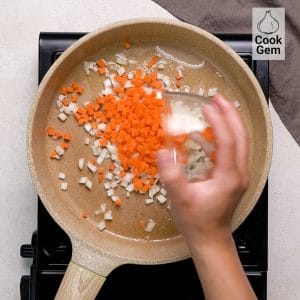
- The beef olives will be done when the meat is soft and very tender.

Maltese bragioli is also called beef olives because the finished structure is supposed to resemble an olive. If I’m completely honest with you, I don’t see it. They look more like Greek dolmas to me. Malta is relatively close to Greece, though it is closer to Italy. Malta is an island in the Mediterranean Sea that is just below the lowest point of Italy.
Despite looking visually complex, maltese bragioli is actually quite simple to make. It requires very little experience or skill, which is great because it is such a unique, fancy looking dish. All you really need to do is chop a few things, pound the meat, and roll it up. After that it’s a quick braise and then cooking over low heat for an hour and a half. Because of the cook time, make sure you start earlier in the day.
Notes & Tips
- If you have leftovers, store the beef olives and sauce in a container with a lid. Keep for up to a week and reheat in a microwave.
- If you do not have stale bread, you can achieve the same result by toasting bread before crumbling it.
- The cut of beef doesn’t have to be particularly high quality because it gets beaten and braised, which helps tenderize even the toughest of meats.
Substitutions
If you do not have bread for any reason, you can use panko. Panko is, essentially, bread crumbs anyway. I find that panko is a bit crunchier than normal bread crumbs, but it is not an ingredient I keep on hand all the time.
Olive oil can be replaced by another oil such as vegetable or grapeseed oil. Olive oil has a stronger taste that I like, but feel free to use an alternative if you do not like olive oil.
Serving Suggestions
Because Maltese bragioli is quite heavy, I like to serve it alongside some healthy greens. It helps balance out the nutrition and really brightens up the plate. Asparagus is an excellent side dish and if you use this easy asparagus recipe , it’s quick and simple.
Another good serving idea is a simple salad. It adds color and crunch to the rich flavor of the Maltese bragioli. You can even use some of the beef olive sauce as dressing.
What Wine to Use?
Any red wine will do. Because it soaks into the beef and simmers for over an hour, I usually use a cheaper wine, so I’m not wasting money on something I don’t get to fully enjoy. While it is best to use cooking-quality red wine, you definitely do not want to use red wine vinegar. That is totally different, but it is an easier mistake to make than you might think.
When it comes down to the wire, you might think that the white wine you have in the back of the fridge will work in a pinch, but it won’t. Red wine brings out flavors in meat in the way white wine does not.
If you’re able to go out of your way for a specific wine, the most recommended wines for beef are cabernet sauvignon and pinot noir. Honestly though, I use merlot a lot and things are always delicious! If you want to kill two birds with one stone, get a wine you’ll enjoy drinking alongside your delicious Maltese bragioli.
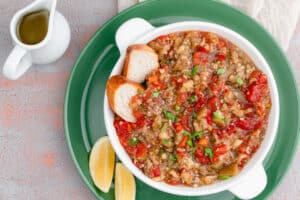
Best Turkish Babagannus
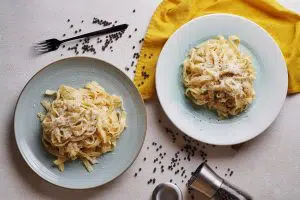
Best Bavette Cacio e Pepe

Best Bulgarian Stuffed Peppers Palneni Chushki

Best Turkish Cookbooks
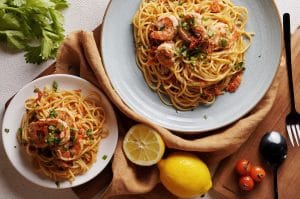

Best Gamberoni Pasta
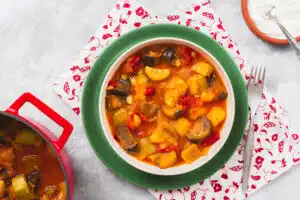
Best Turkish Vegetable Stew

Haitian Lambi
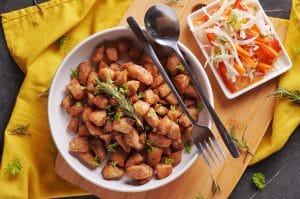
Best Homemade Haitian Griot

Best Mexican Deviled Chicken
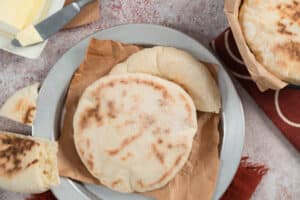
Best Turkish Flatbread (Bazlama)

The 20 Best Italian Coffee Brands
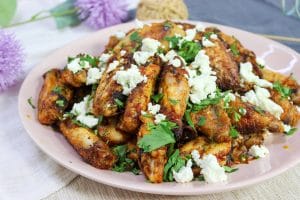
Super Simple Mediterranean Chicken Wings
Recent recipes.
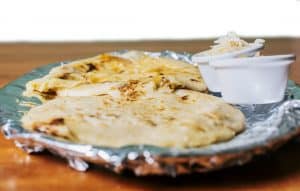
Homemade Loroco Pupusa
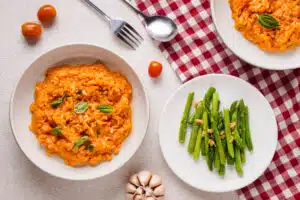
Simple Risotto Alla Pizzaiola

Homemade Cocktail Sauce without Horseradish

Homemade Guyanese Fruit Cake

Easy Low FODMAP Vegan Chocolate Cake Recipe
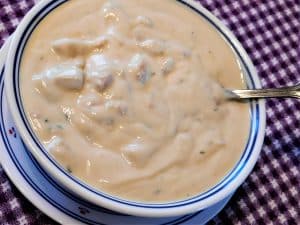
Homemade Captain Parker’s Clam Chowder
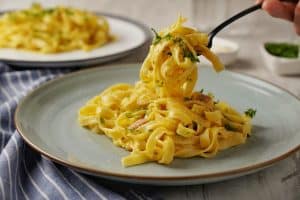
Homemade Pappardelle Carbonara
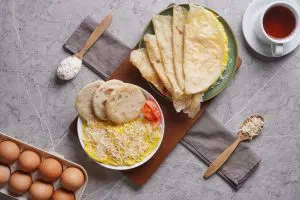
Easy Omani Bread (Khubz Ragag)

Easy Crocchè Di Patate (Potato Croquettes)

Simple Spam Musubi With Egg

Best Boom Boom Shrimp
Important Disclaimer: We may get commissions for products or services purchased via links on our site. cookgem.com is a participant in the Amazon Services LLC Associates Program, an affiliate advertising program designed to provide a means for sites to earn advertising fees by advertising and linking to Amazon.com. Product prices and availability are accurate as of the date/time indicated and are subject to change. Any price and availability information displayed on Amazon at the time of purchase will apply to the purchase of this product. Content, discounts, offers, images, prices and availability are subject to change or removal at any time. Amazon, any store or brand displayed on this website does not support, sponsor or endorse this website or its content. CERTAIN CONTENT THAT APPEARS ON THIS SITE COMES FROM AMAZON SERVICES LLC. THIS CONTENT IS PROVIDED ‘AS IS’ AND IS SUBJECT TO CHANGE OR REMOVAL AT ANY TIME. The third-party product names, logos, brands, and trademarks are the property of their respective owners and not affiliated with cookgem.com. These parties not support, sponsor or endorse this website or its content, or services.
Rate This Recipe

A guide to Maltese food and where to find it
Jump to chapter.
- What to know

Multiple invaders and rulers eyeing Malta for their strategic military support have attracted people of all ethnicities and nations. Through the ages, Malta had to adapt in living with the French, British and Arabs among others. With this mix between people came the influence in language, culture and more importantly for the purpose of this article, food.
The Maltese cuisine is immensely vast, especially when considering the tiny piece of land we live in. And the Maltese, like many other Mediterranean countries, are big eaters. A Maltese would want his plate full to the brim and will not be satisfied until his belly is full and taste buds are done with their craving. In this feature, we will look at what food you can enjoy while on holiday in Malta and where is the best place to eat it.
Read also our guide to: Malta Vegan Food .
Fresh off the street
Ok so let’s start with food which you can easily find in every village and without having the need to sit down quietly in a restaurant to enjoy it.
- Pastizzi. Fast food in Malta has a slightly different meaning to anywhere else in the world. When the Maltese want to eat something good and fast, they head to a Pastizzeria. The word is derived from Pastizzi, this is the one item you should definitely try while in Malta. The Pastizzi are made of puffy pastry in an awkward oval shape, usually filled with ricotta or peas. Over the years the fillings changed and now you can find pastizzi with chicken, tuna and even Nutella.
- Qassatat. The Qassatat are like a pie filled with similar fillings to pastizzi although, even here, variations are on the rise. Their pastry is different from the pastizzi, it’s less puffy. They’re a good snack and very cheap too.
- The Maltese Ftira
Malta is a country of bakers and the Maltese bread is something quite spectacularly unique. One of the most common, cheapest things you can get while on the road is the Maltese ftira. The ftira is basically bread filled with tomato, olive oil, tuna chunks, olives, vegetables and more. In fact, you can fill it up with whatever you like. The bread on its own is already a delight. It’s cheap and very filling. Best to have it next to some amazing beach in Malta!
Home delights
- Rabbit. The Maltese rabbit is perhaps one of the best culinary experiences you’ll experience on the island. Its meat is incredibly tasty. Rabbit is usually either cooked fried in garlic or as stuffat (stew) with potatoes and vegetables.
- Variety of fish. Being an island Malta is no short of fishermen. Head to places like Marsaxlokk or Saint Paul’s Bay to experience some of the freshest, tastiest fish the Mediterranean has to offer. Try the Awrat or octopus, a freshly caught lampuka or swordfish.
- Bragioli. Meat lovers will definitely want to try the Maltese Bragioli, a combination of beef meat, wrapped around a slice of bacon, egg and more meat stuffing usually cooked in some nice red wine.
- Imqarrun il-forn (Oven-baked pasta). A very similar dish to the Italian/American baked macaroni. Here in Malta you’ll find it crusty with cheese on top and tomato sauce. It’s a very good dish for pasta lovers, satisfying and delicious.
- Spagetthi Octapus. Because of Italian influence, the Maltese love their pasta too. So a dish emerged which combines the love for seafood and pasta, spaghetti with octopus and octopus ink. A local favourite, especially in summer when the octopus is freshly caught.
- Stuffed Marrow. As one can easily observe, the Maltese like big portions and like to stuff and mix dishes with no reservations. A stuffed marrow from a traditional Maltese restaurant is a thing you can’t miss. As its’ name suggests, it’s a simple marrow filled with minced meat and red sauce. Sometimes they put melted cheese on top and it’s great.
- Stuffed Aubergines. If you can stuff meat and marrow, why not stuff a nice, juicy aubergine? The same principle as the stuffed marrow, the aubergine provides a unique taste to this dish alteration. Look for it in its local name ‘brungiel mimli’.
- Tuna and spinach pie. The Maltese sure like their oven. Pies are one of the most common things families like to cook to see their relatives happy and with a full belly. The tuna and spinach pie is perhaps one of the most popular and also a slightly healthier option.
- Patata l-forn (oven potatoes). It’s more of a side dish, of course, but baking some thick potatoes in the oven is one thing the Maltese like to include with most of their meals. They usually put onions and garlic on top and let them absorb the taste in the oven.
- Il-Minestra (Minestrone). A thick broth with a beautiful mix of colourful vegetables usually served in winter with a nice slice of Maltese bread on the side.
- Soppa tal-Armla (The Widow’s soap). The name of this particular dish carries some history with it. It literally refers to widows who don’t have much food to put in their soup and so leave it as simple as possible. It’s a simple soup with potatoes, carrots, garlic and cauliflower. Sometimes gbejniet (goat cheese) are added into the mix.
- Aljotta (Fish stew). Accompanied with tomatoes, garlic and rice, the aljotta is a great use of Maltese love for fish in combination with stew.
- Horse meat. Normally taken as a starter and immersed in red sauce, horse meat is one of the most traditional dishes you can find. It’s not healthy for those suffering from high blood pressure, but it’s tasty as.
Fill you platter
The Maltese cuisine provides an excellent source for nibbles and snacks to fill a nice platter.
- Bigilla. The Bigilla is a dip or paste made out of broad beans. Sometimes garlic and parsley are added on top. With bread and olive oil, the bigilla is an addictive item on your platter.
- Maltese sausage. One true, incredibly tasteful element of the Maltese cuisine, is the Maltese sausage. It’s salty attack on your taste buds will make you want more and more. The sausage is normally cooked with coriander and other herbs giving it a unique punch to the taste.
- Gbejniet (Goat cheese). Another essential element you have to include is the Maltese Gbejna. It’s goat cheese served either dried with black peppers (Tal-Bzar) or soft and fresh (friski).
- Stuffed olives. Another stuffed item on the menu, folks. This time, it’s Maltese tasty olives filled with tuna paste. Olive oil and garlic is sometimes added on top. Why not!
- Galletti. The Maltese like to have bread on the side with most of their dishes and platters. Alternatively, they use some Galletti (crackers) to dip in the bigilla. Local companies produce some Galletti with various tastes including gbejna or tomatoes.
- Tadam Imqadded (Sundried tomatoes). The Sundried tomatoes are a colourful addition to your platter and unique. Sundried tomatoes offer a unique texture and taste that does not resemble anything else you’ve tried.
Sweets and desert
- Imqaret. By far our favourite dessert on the Maltese islands. An oily pastry filled with a thick layer of dates paste. They are a true delight and, like the pastizzi, are also cheap and found in most local pastizzerias.
- Kannolli. A slight imitation of the Sicilian cannolli, Malta has adopted it’s freshly filled ricotta or sweet cannolli and transformed it into one of the most popular delights of the Maltese cuisine.
- Qaghaq tal-Ghasel (honey rings). Malta produces some of the best honey in the world. It’s thick, tasty and very healthy. The honey rings, or as they are known locally, Qaghaq tal-Ghasel, are best accompanied with a nice coffee or tea.
- Figolli. Easter in Malta comes with a lot of tradition which includes food and sweets. The figolla (singular) is a flat cake usually in the form of a lamb or rabbit filled with almond filling. It’s covered in different colours and they sometimes put a tiny Easter egg on top. Nowadays they make them in all colours, shapes and sizes.
- Kwarezimal. Ironic to hear about a sweet during lent season. Well, we do have a sweet tooth, even when we’re supposed to be fasting. Kwarezimal is a biscuit with sugar on top, to be put simply. It was introduced by the Knights of Malta when sugar was not considered as something sweet, but rather as a spice.
- Prinjolata. The prinjolata is a traditional item on the Maltese cuisine which basically celebrates sweets during carnival. It comes in the shape of a tiny mountain full of sugar coating, pine nuts, cherries and more.
- Ghadam tal-Mejtin. Literally translated into The Bones of the Dead, Ghadam tal-Mejtin are usually found on sale in the first week of November, when the Christian calendar celebrates the all saints and all spirits day. They have similar fillings as the figolli only this time they have the shape of a bone. Eating a lot of these and you’ll find yourself struggling to locate any of your bones!
- Qaghaq tal-Hmira. Not really related to their lon lost cousin of Qaghaq tal-Ghasel described above, but equally delicious. The Maltese have adopted some of the best pastries to accompany your coffee break and Qaghaq tal-Hmira, are an amazing alternative. They are soft sweet bread with yeast. Pass next to a bakery as they’re just coming out of the oven and you’ll end up buying dozens.
- Biskuttini (Biscuits). Biscuits in Malta are made with a delicious and interesting twist especially when you try the once with almonds sticking out. You’ll have a delightful surprise when you dip it in your coffee.
- Qubbajt. If you head to one of the local village feasts in any village in Malta or Gozo, you’ll find a kiosk selling qubbajt. They are a sugary, sticky sweet sometimes having almonds and cherries into it.
Drinks, anyone?
The culinary influence of foreign nationals has also managed to filter through to the drinks which are popularly consumed in Malta.
- Cisk Lager. The tiny island nation of Malta has its own lager and it’s incredibly popular with locals and tourists alike. It is exported to other countries too and the company is still one of the most successful.
- Kinnie. Kinnie is Malta’s national soft drink. It’s a brownish, bittersweet and fuzzy soft drink which has also gained international recognition.
- Tea with honey. A lot of senior citizens in Malta still take a glass of tea with honey before they go to bed. It apparently helps digestions, similar to camomile. The honey in Malta is exceptionally genuine and good. Make sure you taste some.
- Prickly pear liquor. The prickly pear (Bajtar tax-xewk) in Malta is a really popular fruit which grows in abundance on the Maltese islands. Lately, local producers have started to sell liquor made of these prickly pears and it has become really popular.
Where to eat some of the best local dishes
Traditional Maltese restaurants are popping up everywhere and many restaurants would still serve most of the dishes we mentioned above. However, there are restaurants which are specifically set up for traditional Maltese food.
Here’s a few of notice:
- Balzunetta Restaurant : a local place with a chill atmosphere and very tasty food with great local dishes. Located in Floriana at 5 minutes walk from the city gate of Valletta . Here is on the Map . Better book your table before on www.balzunetta.mt
- Ta’ Nenu bakery: Some good old traditional food and also Maltese pizza located in Valletta .
- Djar il-Bniet: Set in the beautiful town of Dingli , Djar il-Bniet offers some amazing home-cooked dishes like the bragioli and imqarrun il-forn.
- Crystal Palace: This is the most popular spot in Malta to taste your Pastizzi, located in Mdina . It’s famous not only for the taste but also because it opens literally 24 hours a day, seven days a week, non-stop.
- United Bar and Restaurant: This restaurant serves some of the best rabbit on the island. It’s in Mgarr of Malta Island, the place synonymous with rabbit eating!
- Maxokk bakery: Maxokk in Nadur of Gozo , serves traditional ftira with a difference. It’s more like an immensely stuffed pizza with potatoes and local gbejna on top. It’s oily but delicious.
The list of restaurants where you can have some good old traditional Maltese food is really endless. Restaurant owners now realise the importance of serving genuine food and because the competition is high, food is getting better and more authentic.

Explore the Maltese coasts on board of our sailing yacht on a private charter: visit Gozo, Comino and Blue Lagoon .
#daycruises #privatedaytrips #sailing
Watch the Video
Worth a visit when in valletta.

Visit a local restaurant just at 5 minutes walk away from the capital city. Balzunetta Restaurant will blow your mind with their quality food and atmosphere. Check their menu and book your table here .
Location on the Map .
Holidays in Malta
Explore malta.
- Nature In Malta
- Travel Information
- Valletta Guide
- Maltese Climate
- Malta's Top Attractions
- What To Do In Malta
- Maltese Cuisine
- More Things to Know
Book your Trip
- Yacht Charter
- Airport Transfer
Get in touch
For bookings or queries: Telephone & WhatsApp: +35699705230 Email: [email protected]
2024 © All rights are reserved by Holidays in Malta Limited Reg. No: C76917 VAT: MT23629318

Privacy Overview
About Maltese food
The rocky island of malta is home to some beautiful rustic recipes that sing of mediterranean flavour and freshness. maltese cuisine is peasant cuisine, using vegetables in season, homemade cheeses, and cheaper cuts of meat. these are cooked slowly with fresh tomatoes, parsley and garlic to create tender stews with lots of flavour..

Maltese Food Safari recipes

Beef olives (bragioli)
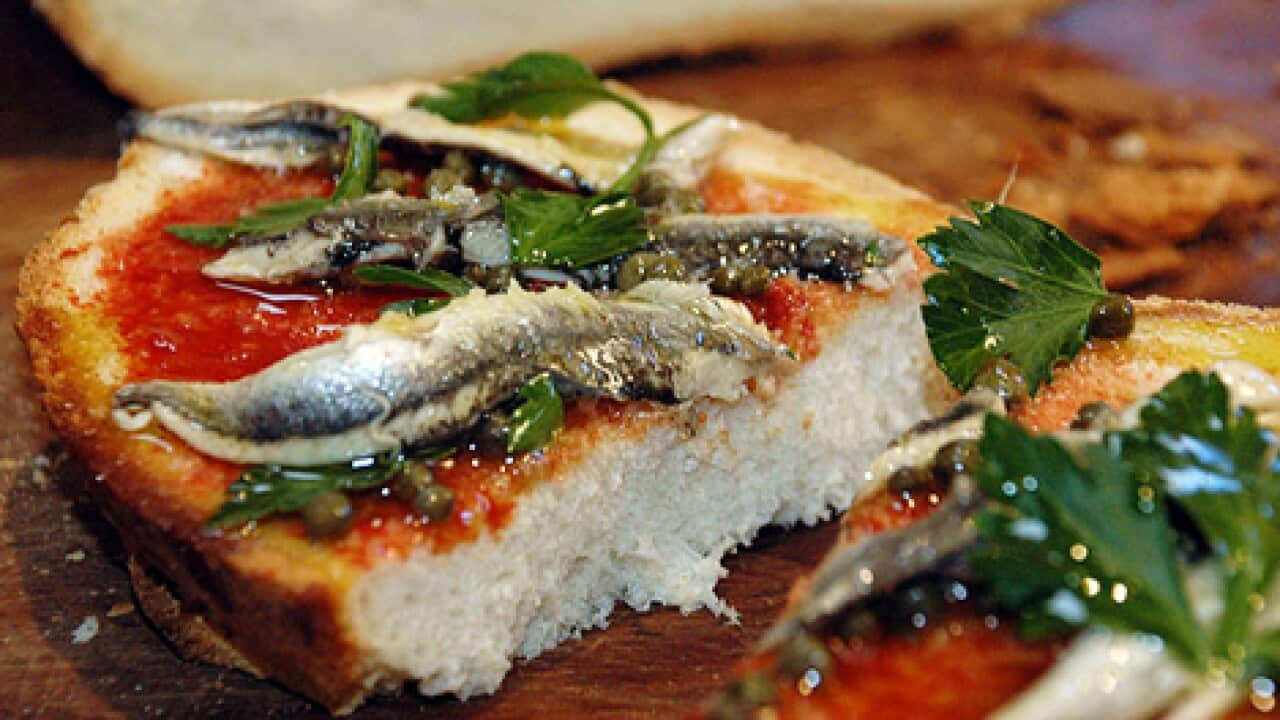
Open sandwich (hobz biz-zejt)

Bread and butter pudding (puddina)
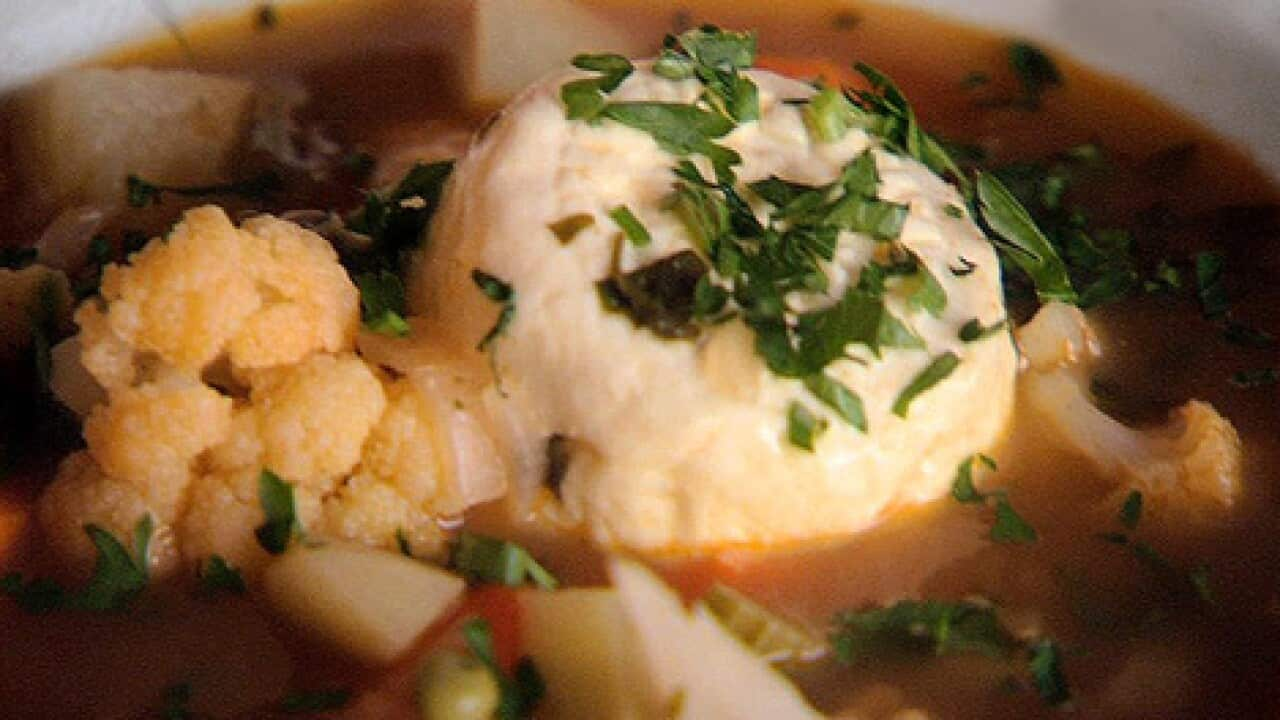
Widow's soup (soppa tal-armla)
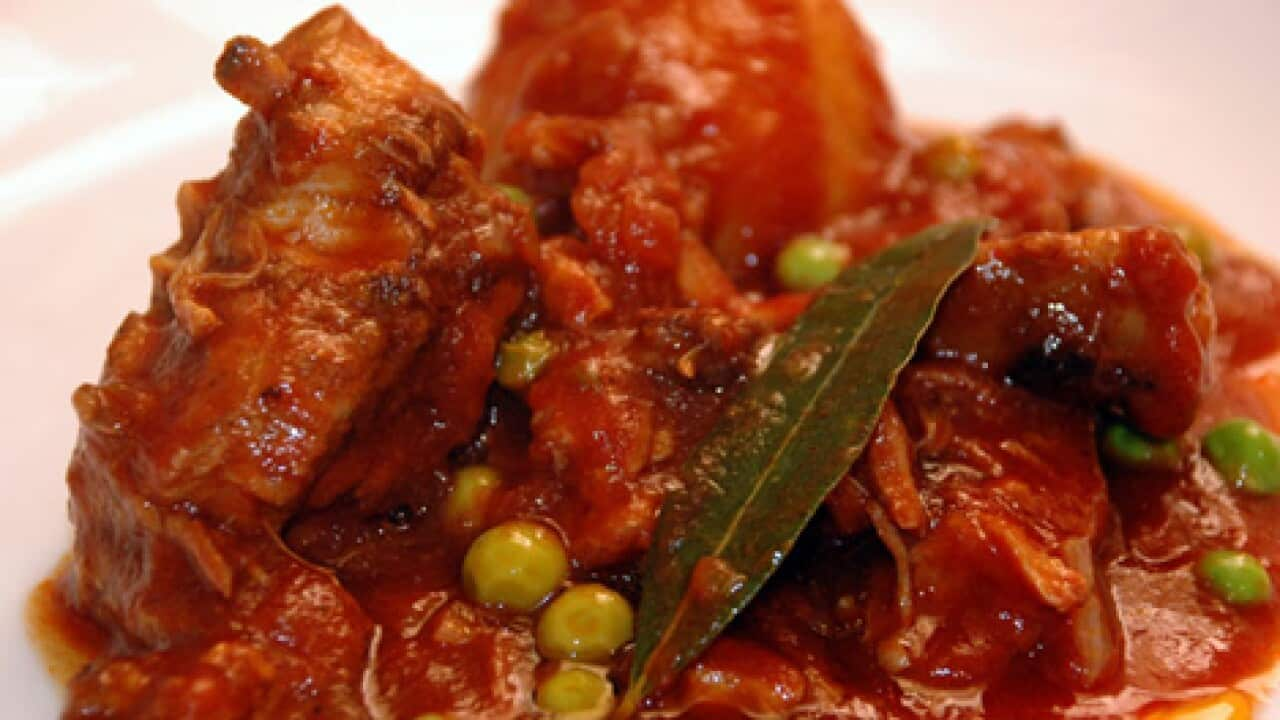
Rabbit stew (stuffat tal-fenek)

Food Safari's timpana
Maltese essentials

Key ingredients: Maltese

Utensils: Maltese
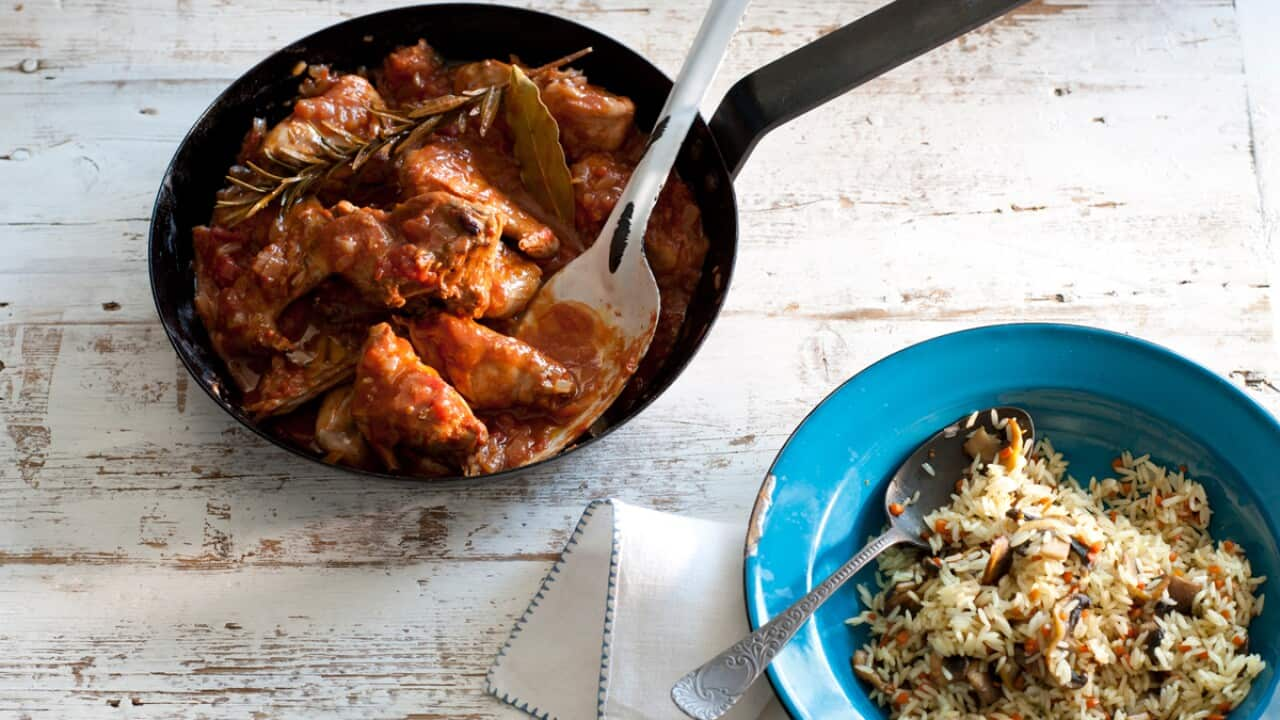
Tips: Maltese

Featured businesses: Maltese
Have a story or comment? Contact Us
Share this with family and friends
SBS Food Newsletter
Get your weekly serving. what to cook, the latest food news, exclusive giveaways - straight to your inbox..
By subscribing, you agree to SBS’s terms of service and privacy policy including receiving email updates from SBS.
Bring the world to your kitchen
Ainsley’s Taste of Malta: release date, episode guide, recipes, locations and everything we know
Ainsley’s Taste of Malta is an ITV series following TV chef Ainsley Harriott around the Maltese archipelago.

Ainsley’s Taste of Malta sees bubbly TV chef Ainsley Harriott bring us his usual joyful energy and some much-needed sunshine for a five-part series.
Located in the Mediterranean Sea between Sicily and the North African coast, Malta has been influenced by Arabic, Italian, French and even British culture, which is all expressed in the holiday hotspot’s delicious cuisine.
"The stunning islands that make up the Maltese archipelago are a melting pot of different cultures," says Ainsley Harriott whose previous shows have included Ainsley's Coronation Kitchen and will be hosting Ainsley’s National Trust Cook Off later in 2024.
"Sat at the crossroads of Europe and the Middle East everyone from the Greeks and the Romans to the Moors and the Crusaders have left their mark here, even us Brits. You can almost taste the history in the food!"
Across five episodes of Ainsley’s Taste of Malta , the chef criss-crosses the archipelago, taking in the ancient city of Mdina and the idyllic island of Gozo, while also cooking his take on Maltese dishes.
Here's everything you need to know about Ainsley’s Taste of Malta on ITV1 and ITVX...
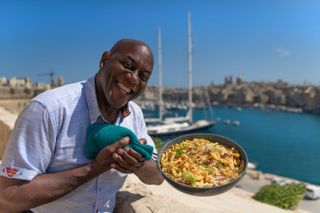
Ainsley’s Taste of Malta release date
Ainsley’s Taste of Malta is a five-part series that runs daily across the week on ITV1 from Monday, February 5 2024 at 2 pm to Friday, February 9.
Episodes will also become available on streaming service ITVX.
Ainsley’s Taste of Malta — what happens, recipes and our episode guide
Here's where Ainsley heads for in each episode of Ainsley’s Taste of Malta ...
Episode 1 First up, he’s in Malta’s capital, Valletta, where he falls in love with Imqaret, a traditional fried pastry with dates, and enjoys the popular Maltese sausages, known as Zalzett tal-Malti. He cooks al fresco, making Maltese stuffed aubergine, casarecce pasta with sausage and fennel and a seafood platter with a spiced tartare sauce. But his highlight is bell ringing at Valetta’s stunning St John’s Co-Cathedral, built by crusading knights, and home to two priceless paintings by Caravaggio!
"I’ve always wanted to try bell ringing and it was the most amazing experience," says Ainsley. ‘It’s hard not to fall in love with Valletta. There’s just so much to see and do – and eat!
"Valletta is known as ‘the fortress city’ and I can certainly see why. The impressive defenses were built by the crusading knights of Saint John way back in the 16th century. The knights ruled for 250 years until Napoleon took a fancy to the island and invaded. But from it was 1814 to 1964 it was governed by Britain. There’s just so much history here and it shows in the food, which combines Arabic, French, Italian and British influences."
Wandering Valletta’s cobbled streets, Ainsley enjoys popular Maltese sausages, known as Zalzett tal-Malti, and falls in love with a fried pastry called Imqaret, a tasty reminder of the island’s Arabic past, packed with dates, cinnamon, aniseed and cloves. He also cooks al fresco, making Maltese stuffed aubergine, casarecce pasta with sausage and fennel, and a seafood platter with a spiced tartar sauce.
"It’s all about getting fresh beautiful ingredients and in Malta you’re guaranteed that – just the size of the lemons is incredible!’ says Ainsley. "They like their food to be rustic and seasonal, but the North African influence really comes across in their cuisine with spices like cayenne pepper, cinnamon and nutmeg."
Episode 2: The South Heading south to the fishing harbour of Marsaxlokk, Ainsley checks out a local fish market. He also explores a nearby vineyard, a potato farm and meets a bakery making a traditional Maltese sweet treat.
Episode 3: Central Ainsley explores the ancient city of Mdina, learns the art of glass blowing and gets a culinary masterclass in making ring-shaped Maltese bread, known as ftira. He also visits a tiny eatery called Crystal Palace famous for flaky parcels of pastry known as pastizzi.
Episode 4: The North Ainsley’s journey takes him to an olive grove owned by the so-called godfather of Maltese olive oil. He also tries a traditional rabbit stew, considered Malta’s national dish.
Episode 5: Gozo As his adventure nears its end, Ainsley heads to the idyllic island of Gozo. There’s a visit to a farm to find out how Maltese cheese is made, while he also learns the secrets behind Maltese beef bragioli, translated as beef olives!

Is there a trailer for Ainsley’s Taste of Malta?
There's no trailer for Ainsley’s Taste of Malta available just yet, but if and when it becomes available we'll post it on here.
Get the What to Watch Newsletter
The latest updates, reviews and unmissable series to watch and more!
I'm a huge fan of television so I really have found the perfect job, as I've been writing about TV shows, films and interviewing major television, film and sports stars for over 25 years. I'm currently TV Content Director on What's On TV, TV Times, TV and Satellite Week magazines plus Whattowatch.com. I previously worked on Woman and Woman's Own in the 1990s. Outside of work I swim every morning, support Charlton Athletic football club and get nostalgic about TV shows Cagney & Lacey, I Claudius, Dallas and Tenko. I'm totally on top of everything good coming up too.
- Hannah Davies Writer
Piglets: cast, plot, first look and everything we know
Devastation for one character in EastEnders tonight
Wallace & Gromit: Vengeance Most Fowl cast, plot, trailer and everything we know
Most Popular
- 2 Peter Kay to feature in BBC One's new Wallace and Gromit film
- 3 The Bold and the Beautiful recap for June 6, 2024: Finn questions Steffy
- 4 Reasonable Doubt season 2: release date, cast, plot and everything we know about the legal drama
- 5 The Hunger Games: Sunrise on the Reaping — release date and everything we know about the Hunger Games prequel

40 Facts About Elektrostal
Written by Lanette Mayes
Modified & Updated: 01 Jun 2024
Reviewed by Jessica Corbett

Elektrostal is a vibrant city located in the Moscow Oblast region of Russia. With a rich history, stunning architecture, and a thriving community, Elektrostal is a city that has much to offer. Whether you are a history buff, nature enthusiast, or simply curious about different cultures, Elektrostal is sure to captivate you.
This article will provide you with 40 fascinating facts about Elektrostal, giving you a better understanding of why this city is worth exploring. From its origins as an industrial hub to its modern-day charm, we will delve into the various aspects that make Elektrostal a unique and must-visit destination.
So, join us as we uncover the hidden treasures of Elektrostal and discover what makes this city a true gem in the heart of Russia.
Key Takeaways:
- Elektrostal, known as the “Motor City of Russia,” is a vibrant and growing city with a rich industrial history, offering diverse cultural experiences and a strong commitment to environmental sustainability.
- With its convenient location near Moscow, Elektrostal provides a picturesque landscape, vibrant nightlife, and a range of recreational activities, making it an ideal destination for residents and visitors alike.
Known as the “Motor City of Russia.”
Elektrostal, a city located in the Moscow Oblast region of Russia, earned the nickname “Motor City” due to its significant involvement in the automotive industry.
Home to the Elektrostal Metallurgical Plant.
Elektrostal is renowned for its metallurgical plant, which has been producing high-quality steel and alloys since its establishment in 1916.
Boasts a rich industrial heritage.
Elektrostal has a long history of industrial development, contributing to the growth and progress of the region.
Founded in 1916.
The city of Elektrostal was founded in 1916 as a result of the construction of the Elektrostal Metallurgical Plant.
Located approximately 50 kilometers east of Moscow.
Elektrostal is situated in close proximity to the Russian capital, making it easily accessible for both residents and visitors.
Known for its vibrant cultural scene.
Elektrostal is home to several cultural institutions, including museums, theaters, and art galleries that showcase the city’s rich artistic heritage.
A popular destination for nature lovers.
Surrounded by picturesque landscapes and forests, Elektrostal offers ample opportunities for outdoor activities such as hiking, camping, and birdwatching.
Hosts the annual Elektrostal City Day celebrations.
Every year, Elektrostal organizes festive events and activities to celebrate its founding, bringing together residents and visitors in a spirit of unity and joy.
Has a population of approximately 160,000 people.
Elektrostal is home to a diverse and vibrant community of around 160,000 residents, contributing to its dynamic atmosphere.
Boasts excellent education facilities.
The city is known for its well-established educational institutions, providing quality education to students of all ages.
A center for scientific research and innovation.
Elektrostal serves as an important hub for scientific research, particularly in the fields of metallurgy , materials science, and engineering.
Surrounded by picturesque lakes.
The city is blessed with numerous beautiful lakes , offering scenic views and recreational opportunities for locals and visitors alike.
Well-connected transportation system.
Elektrostal benefits from an efficient transportation network, including highways, railways, and public transportation options, ensuring convenient travel within and beyond the city.
Famous for its traditional Russian cuisine.
Food enthusiasts can indulge in authentic Russian dishes at numerous restaurants and cafes scattered throughout Elektrostal.
Home to notable architectural landmarks.
Elektrostal boasts impressive architecture, including the Church of the Transfiguration of the Lord and the Elektrostal Palace of Culture.
Offers a wide range of recreational facilities.
Residents and visitors can enjoy various recreational activities, such as sports complexes, swimming pools, and fitness centers, enhancing the overall quality of life.
Provides a high standard of healthcare.
Elektrostal is equipped with modern medical facilities, ensuring residents have access to quality healthcare services.
Home to the Elektrostal History Museum.
The Elektrostal History Museum showcases the city’s fascinating past through exhibitions and displays.
A hub for sports enthusiasts.
Elektrostal is passionate about sports, with numerous stadiums, arenas, and sports clubs offering opportunities for athletes and spectators.
Celebrates diverse cultural festivals.
Throughout the year, Elektrostal hosts a variety of cultural festivals, celebrating different ethnicities, traditions, and art forms.
Electric power played a significant role in its early development.
Elektrostal owes its name and initial growth to the establishment of electric power stations and the utilization of electricity in the industrial sector.
Boasts a thriving economy.
The city’s strong industrial base, coupled with its strategic location near Moscow, has contributed to Elektrostal’s prosperous economic status.
Houses the Elektrostal Drama Theater.
The Elektrostal Drama Theater is a cultural centerpiece, attracting theater enthusiasts from far and wide.
Popular destination for winter sports.
Elektrostal’s proximity to ski resorts and winter sport facilities makes it a favorite destination for skiing, snowboarding, and other winter activities.
Promotes environmental sustainability.
Elektrostal prioritizes environmental protection and sustainability, implementing initiatives to reduce pollution and preserve natural resources.
Home to renowned educational institutions.
Elektrostal is known for its prestigious schools and universities, offering a wide range of academic programs to students.
Committed to cultural preservation.
The city values its cultural heritage and takes active steps to preserve and promote traditional customs, crafts, and arts.
Hosts an annual International Film Festival.
The Elektrostal International Film Festival attracts filmmakers and cinema enthusiasts from around the world, showcasing a diverse range of films.
Encourages entrepreneurship and innovation.
Elektrostal supports aspiring entrepreneurs and fosters a culture of innovation, providing opportunities for startups and business development .
Offers a range of housing options.
Elektrostal provides diverse housing options, including apartments, houses, and residential complexes, catering to different lifestyles and budgets.
Home to notable sports teams.
Elektrostal is proud of its sports legacy , with several successful sports teams competing at regional and national levels.
Boasts a vibrant nightlife scene.
Residents and visitors can enjoy a lively nightlife in Elektrostal, with numerous bars, clubs, and entertainment venues.
Promotes cultural exchange and international relations.
Elektrostal actively engages in international partnerships, cultural exchanges, and diplomatic collaborations to foster global connections.
Surrounded by beautiful nature reserves.
Nearby nature reserves, such as the Barybino Forest and Luchinskoye Lake, offer opportunities for nature enthusiasts to explore and appreciate the region’s biodiversity.
Commemorates historical events.
The city pays tribute to significant historical events through memorials, monuments, and exhibitions, ensuring the preservation of collective memory.
Promotes sports and youth development.
Elektrostal invests in sports infrastructure and programs to encourage youth participation, health, and physical fitness.
Hosts annual cultural and artistic festivals.
Throughout the year, Elektrostal celebrates its cultural diversity through festivals dedicated to music, dance, art, and theater.
Provides a picturesque landscape for photography enthusiasts.
The city’s scenic beauty, architectural landmarks, and natural surroundings make it a paradise for photographers.
Connects to Moscow via a direct train line.
The convenient train connection between Elektrostal and Moscow makes commuting between the two cities effortless.
A city with a bright future.
Elektrostal continues to grow and develop, aiming to become a model city in terms of infrastructure, sustainability, and quality of life for its residents.
In conclusion, Elektrostal is a fascinating city with a rich history and a vibrant present. From its origins as a center of steel production to its modern-day status as a hub for education and industry, Elektrostal has plenty to offer both residents and visitors. With its beautiful parks, cultural attractions, and proximity to Moscow, there is no shortage of things to see and do in this dynamic city. Whether you’re interested in exploring its historical landmarks, enjoying outdoor activities, or immersing yourself in the local culture, Elektrostal has something for everyone. So, next time you find yourself in the Moscow region, don’t miss the opportunity to discover the hidden gems of Elektrostal.
Q: What is the population of Elektrostal?
A: As of the latest data, the population of Elektrostal is approximately XXXX.
Q: How far is Elektrostal from Moscow?
A: Elektrostal is located approximately XX kilometers away from Moscow.
Q: Are there any famous landmarks in Elektrostal?
A: Yes, Elektrostal is home to several notable landmarks, including XXXX and XXXX.
Q: What industries are prominent in Elektrostal?
A: Elektrostal is known for its steel production industry and is also a center for engineering and manufacturing.
Q: Are there any universities or educational institutions in Elektrostal?
A: Yes, Elektrostal is home to XXXX University and several other educational institutions.
Q: What are some popular outdoor activities in Elektrostal?
A: Elektrostal offers several outdoor activities, such as hiking, cycling, and picnicking in its beautiful parks.
Q: Is Elektrostal well-connected in terms of transportation?
A: Yes, Elektrostal has good transportation links, including trains and buses, making it easily accessible from nearby cities.
Q: Are there any annual events or festivals in Elektrostal?
A: Yes, Elektrostal hosts various events and festivals throughout the year, including XXXX and XXXX.
Elektrostal's fascinating history, vibrant culture, and promising future make it a city worth exploring. For more captivating facts about cities around the world, discover the unique characteristics that define each city . Uncover the hidden gems of Moscow Oblast through our in-depth look at Kolomna. Lastly, dive into the rich industrial heritage of Teesside, a thriving industrial center with its own story to tell.
Was this page helpful?
Our commitment to delivering trustworthy and engaging content is at the heart of what we do. Each fact on our site is contributed by real users like you, bringing a wealth of diverse insights and information. To ensure the highest standards of accuracy and reliability, our dedicated editors meticulously review each submission. This process guarantees that the facts we share are not only fascinating but also credible. Trust in our commitment to quality and authenticity as you explore and learn with us.
Share this Fact:

- Bahasa Indonesia
- Eastern Europe
- Moscow Oblast
Elektrostal
Elektrostal Localisation : Country Russia , Oblast Moscow Oblast . Available Information : Geographical coordinates , Population, Altitude, Area, Weather and Hotel . Nearby cities and villages : Noginsk , Pavlovsky Posad and Staraya Kupavna .
Information
Find all the information of Elektrostal or click on the section of your choice in the left menu.
- Update data
Elektrostal Demography
Information on the people and the population of Elektrostal.
Elektrostal Geography
Geographic Information regarding City of Elektrostal .
Elektrostal Distance
Distance (in kilometers) between Elektrostal and the biggest cities of Russia.
Elektrostal Map
Locate simply the city of Elektrostal through the card, map and satellite image of the city.
Elektrostal Nearby cities and villages
Elektrostal weather.
Weather forecast for the next coming days and current time of Elektrostal.
Elektrostal Sunrise and sunset
Find below the times of sunrise and sunset calculated 7 days to Elektrostal.
Elektrostal Hotel
Our team has selected for you a list of hotel in Elektrostal classified by value for money. Book your hotel room at the best price.
Elektrostal Nearby
Below is a list of activities and point of interest in Elektrostal and its surroundings.
The Unique Burial of a Child of Early Scythian Time at the Cemetery of Saryg-Bulun (Tuva)
<< Previous page
Pages: 379-406
In 1988, the Tuvan Archaeological Expedition (led by M. E. Kilunovskaya and V. A. Semenov) discovered a unique burial of the early Iron Age at Saryg-Bulun in Central Tuva. There are two burial mounds of the Aldy-Bel culture dated by 7th century BC. Within the barrows, which adjoined one another, forming a figure-of-eight, there were discovered 7 burials, from which a representative collection of artifacts was recovered. Burial 5 was the most unique, it was found in a coffin made of a larch trunk, with a tightly closed lid. Due to the preservative properties of larch and lack of air access, the coffin contained a well-preserved mummy of a child with an accompanying set of grave goods. The interred individual retained the skin on his face and had a leather headdress painted with red pigment and a coat, sewn from jerboa fur. The coat was belted with a leather belt with bronze ornaments and buckles. Besides that, a leather quiver with arrows with the shafts decorated with painted ornaments, fully preserved battle pick and a bow were buried in the coffin. Unexpectedly, the full-genomic analysis, showed that the individual was female. This fact opens a new aspect in the study of the social history of the Scythian society and perhaps brings us back to the myth of the Amazons, discussed by Herodotus. Of course, this discovery is unique in its preservation for the Scythian culture of Tuva and requires careful study and conservation.
Keywords: Tuva, Early Iron Age, early Scythian period, Aldy-Bel culture, barrow, burial in the coffin, mummy, full genome sequencing, aDNA
Information about authors: Marina Kilunovskaya (Saint Petersburg, Russian Federation). Candidate of Historical Sciences. Institute for the History of Material Culture of the Russian Academy of Sciences. Dvortsovaya Emb., 18, Saint Petersburg, 191186, Russian Federation E-mail: [email protected] Vladimir Semenov (Saint Petersburg, Russian Federation). Candidate of Historical Sciences. Institute for the History of Material Culture of the Russian Academy of Sciences. Dvortsovaya Emb., 18, Saint Petersburg, 191186, Russian Federation E-mail: [email protected] Varvara Busova (Moscow, Russian Federation). (Saint Petersburg, Russian Federation). Institute for the History of Material Culture of the Russian Academy of Sciences. Dvortsovaya Emb., 18, Saint Petersburg, 191186, Russian Federation E-mail: [email protected] Kharis Mustafin (Moscow, Russian Federation). Candidate of Technical Sciences. Moscow Institute of Physics and Technology. Institutsky Lane, 9, Dolgoprudny, 141701, Moscow Oblast, Russian Federation E-mail: [email protected] Irina Alborova (Moscow, Russian Federation). Candidate of Biological Sciences. Moscow Institute of Physics and Technology. Institutsky Lane, 9, Dolgoprudny, 141701, Moscow Oblast, Russian Federation E-mail: [email protected] Alina Matzvai (Moscow, Russian Federation). Moscow Institute of Physics and Technology. Institutsky Lane, 9, Dolgoprudny, 141701, Moscow Oblast, Russian Federation E-mail: [email protected]
Shopping Cart Items: 0 Cart Total: 0,00 € place your order
Price pdf version
student - 2,75 € individual - 3,00 € institutional - 7,00 €

Copyright В© 1999-2022. Stratum Publishing House
Follow Puck Worlds online:
- Follow Puck Worlds on Twitter
Site search
Filed under:
- Kontinental Hockey League
Gagarin Cup Preview: Atlant vs. Salavat Yulaev
Share this story.
- Share this on Facebook
- Share this on Twitter
- Share this on Reddit
- Share All sharing options
Share All sharing options for: Gagarin Cup Preview: Atlant vs. Salavat Yulaev
Gagarin cup (khl) finals: atlant moscow oblast vs. salavat yulaev ufa.
Much like the Elitserien Finals, we have a bit of an offense vs. defense match-up in this league Final. While Ufa let their star top line of Alexander Radulov, Patrick Thoresen and Igor Grigorenko loose on the KHL's Western Conference, Mytischi played a more conservative style, relying on veterans such as former NHLers Jan Bulis, Oleg Petrov, and Jaroslav Obsut. Just reaching the Finals is a testament to Atlant's disciplined style of play, as they had to knock off much more high profile teams from Yaroslavl and St. Petersburg to do so. But while they did finish 8th in the league in points, they haven't seen the likes of Ufa, who finished 2nd.
This series will be a challenge for the underdog, because unlike some of the other KHL teams, Ufa's top players are generally younger and in their prime. Only Proshkin amongst regular blueliners is over 30, with the work being shared by Kirill Koltsov (28), Andrei Kuteikin (26), Miroslav Blatak (28), Maxim Kondratiev (28) and Dmitri Kalinin (30). Oleg Tverdovsky hasn't played a lot in the playoffs to date. Up front, while led by a fairly young top line (24-27), Ufa does have a lot of veterans in support roles: Vyacheslav Kozlov , Viktor Kozlov , Vladimir Antipov, Sergei Zinovyev and Petr Schastlivy are all over 30. In fact, the names of all their forwards are familiar to international and NHL fans: Robert Nilsson , Alexander Svitov, Oleg Saprykin and Jakub Klepis round out the group, all former NHL players.
For Atlant, their veteran roster, with only one of their top six D under the age of 30 (and no top forwards under 30, either), this might be their one shot at a championship. The team has never won either a Russian Superleague title or the Gagarin Cup, and for players like former NHLer Oleg Petrov, this is probably the last shot at the KHL's top prize. The team got three extra days rest by winning their Conference Final in six games, and they probably needed to use it. Atlant does have younger regulars on their roster, but they generally only play a few shifts per game, if that.
The low event style of game for Atlant probably suits them well, but I don't know how they can manage to keep up against Ufa's speed, skill, and depth. There is no advantage to be seen in goal, with Erik Ersberg and Konstantin Barulin posting almost identical numbers, and even in terms of recent playoff experience Ufa has them beat. Luckily for Atlant, Ufa isn't that far away from the Moscow region, so travel shouldn't play a major role.
I'm predicting that Ufa, winners of the last Superleague title back in 2008, will become the second team to win the Gagarin Cup, and will prevail in five games. They have a seriously well built team that would honestly compete in the NHL. They represent the potential of the league, while Atlant represents closer to the reality, as a team full of players who played themselves out of the NHL.
- Atlant @ Ufa, Friday Apr 8 (3:00 PM CET/10:00 PM EST)
- Atlant @ Ufa, Sunday Apr 10 (1:00 PM CET/8:00 AM EST)
- Ufa @ Atlant, Tuesday Apr 12 (5:30 PM CET/12:30 PM EST)
- Ufa @ Atlant, Thursday Apr 14 (5:30 PM CET/12:30 PM EST)
Games 5-7 are as yet unscheduled, but every second day is the KHL standard, so expect Game 5 to be on Saturday, like an early start.
Loading comments...

IMAGES
VIDEO
COMMENTS
Instructions. Beat the slices of meat with a mallet so they are nice and thin. In a bowl, add your bread crumbs, chopped bacon, parsley, and a little salt and pepper. This is your stuffing. Place a heaping tablespoon of the stuffing onto a slice of the beef and spread it out along with a couple slices of hard boiled egg.
Add beef rolls and brown over medium heat. Remove beef rolls from saucepan and set aside. Add potatoes, tomatoes, carrots, tomato paste, herbs, and wine into the saucepan. Then add pepper and salt to taste. Stir gently and cook for about 10 minutes. Return beef rolls in saucepan, add peas and bring to boil.
Wrap your meat around the mixture by rolling the meat to make a parcel and fasten with toothpicks. In a casserole dish add some oil and add the bay leaves. Over a medium heat lightly brown your bragoli and set aside. In the same dish fry the onion for 5 minutes. Add the carrots and celery, and fry for a further 10 minutes.
First, lay out the beef slices. Meanwhile, mix the remaining ingredients together and season with salt and pepper. Place then a heaped tablespoon of stuffing mixture on each beef slice, spreading out well. Roll it up and secure it with a toothpicks or tie with butcher's twine. Place the bragioli in the sauce and simmer for 1 ½ hours over low ...
Bragioli is a typical Maltese dish. Also known as beef olives, which is a little confusing, because there are no olives involved. Bragioli consists of thinly...
Directions: 1. Start with the filling. In a small bowl mix together the ground beef, parmesan, boiled eggs, parsley, and breadcrumbs. Combine together with an egg and season to taste. Set aside. 2. Flatten out the beef slices, season with salt & pepper and add a mozzarella & a bacon slice in the center. Place 1/4 of the beef mixture on top and ...
Instructions. To make the sauce, heat the oil in a large saucepan and add the onion and garlic. Fry until softened. Add the remaining ingredients and leave to simmer while you prepare the bragioli ...
Nenu the Artisan Baker, Valletta. Wouldn't expect anything but the best from Nenu when it comes to traditional Maltese dishes! 2. Ta' Kris, Sliema. How good do these look? Yummy! 3. Il-Malti, Sliema. Rolled beef steak with smoked ham, minced pork, breadcrumbs, cheeselets, hard boiled eggs and parseley.
Add oil and allow to heat. Once oil begins to ripple, add the bragioli, making sure to not crowd the pan; fry in multiple batches if needed. Cook for 1-2 minutes a side. Remove from pan and reduce the heat to low. Add butter and onions to the pan, stirring frequently, until softened, about 3-5 minutes.
Add beef rolls and brown over medium heat. Remove beef rolls from saucepan and set aside. Add potatoes, tomatoes, carrots, tomato paste, herbs, and wine into the saucepan. Then add pepper and salt to taste. Stir gently and cook for about 10 minutes. Return beef rolls in saucepan, add peas and bring to boil.
Friday, November 1st, 2013. Bragoli - Beef rolls or olives in stew. Finely chopped garlic,parsley,onion,turkey ham,and cheese mixed with herbs & seasoning and a beaten egg. Then putting some of this stuffing on each slice of thin sliced beef steak and rolled and secured with tooth picks. Then the filled beef rolls are fried to seal in the juices.
Maltese food is a blend of Mediterranean influences and local ingredients. Learn about the history, culture and flavors of this delicious cuisine. ... Bragioli. Bragioli. Bragioli, also known as beef olives, are thin slices of beef that get rolled with a mixture of bacon, onions, hard-boiled eggs, parsley, and breadcrumbs. The beef rolls are ...
10. Soppa tal-armla. Soppa tal-armla, also known as "widow's soup", is a hearty and comforting Maltese soup made with vegetables like potatoes, carrots, kohlrabi, peas, beans and cauliflower. It gets its name from being an inexpensive soup originally made by widows using ingredients they had on hand.
Head down south to take a bite on this delicious traditional Maltese fish. 5. Kwareżimal (traditional Maltese biscuit) Since almonds are one of the favourites of Maltese, you should take a bite of Kwarezimal. This traditional spongy cake made of orange rind and topped with almonds. It is a hit during the lent season.
Add the bread crumbs to a medium mixing bowl. Chop the bacon into small chunks and add to the mixing bowl. Roughly chop the parsley and add to the bowl. Finely dice or mince the garlic and add to the bowl. Cut the hard-boiled eggs into thin slices. Sprinkle a pinch of salt and pepper into the bowl then mix together.
Aljotta (Fish stew). Accompanied with tomatoes, garlic and rice, the aljotta is a great use of Maltese love for fish in combination with stew. Horse meat. Normally taken as a starter and immersed in red sauce, horse meat is one of the most traditional dishes you can find.
Fruit served chilled is always part of a dessert spread - typically stone fruit, figs, melons, pears, grapes, citrus or pomegranates. SBS Food is a 24/7 foodie channel for all Australians, with ...
Recipe: https://cookgem.com/maltese-bragioli/#cookgem #recipesforlunch #recipeshorts #recipes #foodie #globalrecipe #maltese #recipesfast #beefrecipe #food #...
Ainsley showing off the best food to be had in the Maltese capital Valletta. (Image credit: ITV) Ainsley's Taste of Malta release date. Ainsley's Taste of Malta is a five-part series that runs daily across the week on ITV1 from Monday, February 5 2024 at 2 pm to Friday, February 9.. Episodes will also become available on streaming service ITVX.
40 Facts About Elektrostal. Elektrostal is a vibrant city located in the Moscow Oblast region of Russia. With a rich history, stunning architecture, and a thriving community, Elektrostal is a city that has much to offer. Whether you are a history buff, nature enthusiast, or simply curious about different cultures, Elektrostal is sure to ...
Elektrostal Geography. Geographic Information regarding City of Elektrostal. Elektrostal Geographical coordinates. Latitude: 55.8, Longitude: 38.45. 55° 48′ 0″ North, 38° 27′ 0″ East. Elektrostal Area. 4,951 hectares. 49.51 km² (19.12 sq mi) Elektrostal Altitude.
Burial 5 was the most unique, it was found in a coffin made of a larch trunk, with a tightly closed lid. Due to the preservative properties of larch and lack of air access, the coffin contained a well-preserved mummy of a child with an accompanying set of grave goods. The interred individual retained the skin on his face and had a leather ...
Much like the Elitserien Finals, we have a bit of an offense vs. defense match-up in this league Final. While Ufa let their star top line of Alexander Radulov, Patrick Thoresen and Igor Grigorenko loose on the KHL's Western Conference, Mytischi played a more conservative style, relying on veterans such as former NHLers Jan Bulis, Oleg Petrov, and Jaroslav Obsut.